1. Understanding Average Age in Inventory Management
In the realm of inventory management, understanding the concept of average age is vital for optimizing the allocation and movement of goods. It plays a pivotal role in the ABC analysis method, a renowned strategy for categorizing inventory items into different classes based on their importance and value. This blog section delves deep into the intricacies of average age, shedding light on why it matters, how it's calculated, and the impact it has on your inventory management decisions.
1. Defining average Age in inventory Management:
Average age, also known as the average holding period or average age of inventory, refers to the mean time an item stays in your inventory before being sold or used. It is a crucial metric as it offers insights into the efficiency of your inventory turnover. The shorter the average age, the faster your goods are moving, which can free up capital and reduce holding costs.
2. Calculating Average Age:
Calculating average age is relatively straightforward. You sum the number of days each item spends in your inventory, and then divide this total by the number of items. Here's an example: If you have three items with ages of 10 days, 20 days, and 30 days, the average age would be (10 + 20 + 30) / 3 = 20 days.
3. Importance of Short Average Age:
Shortening the average age of inventory is often a goal for businesses aiming to optimize their inventory management. This directly impacts your cash flow by reducing the amount of capital tied up in unsold goods. It also minimizes the risk of obsolescence and spoilage, as fresher items are less likely to become outdated.
4. The Impact on Different Inventory Categories:
Different categories of inventory items are affected by average age in distinct ways. For instance, fast-moving products, categorized as "A" items in the ABC analysis, benefit from shorter average ages. This ensures that popular items remain in stock and readily available to meet customer demand. On the other hand, slow-moving items ("C" items) might have a longer average age, as they don't sell as quickly.
5. The Balance Between Average Age and Holding Costs:
While a short average age is desirable for improved cash flow, it's essential to strike a balance with holding costs. You may need to hold some items for a longer time due to seasonality, supplier lead times, or other factors. Careful analysis of each inventory item's specific requirements is necessary to optimize the average age effectively.
6. Real-Life Example:
Let's consider an electronics retailer. High-end smartphones ("A" items) should have a short average age to meet the ever-changing consumer demand. In contrast, accessories like phone cases ("C" items) can have a longer average age since they don't become obsolete as quickly.
In summary, understanding and managing the average age of inventory is a critical aspect of efficient inventory management. It impacts your cash flow, holding costs, and the availability of products to meet customer demand. Different categories of items require different average ages, and finding the right balance can be a key factor in your business's success. The ABC analysis method helps categorize items and prioritize efforts to manage average age effectively.
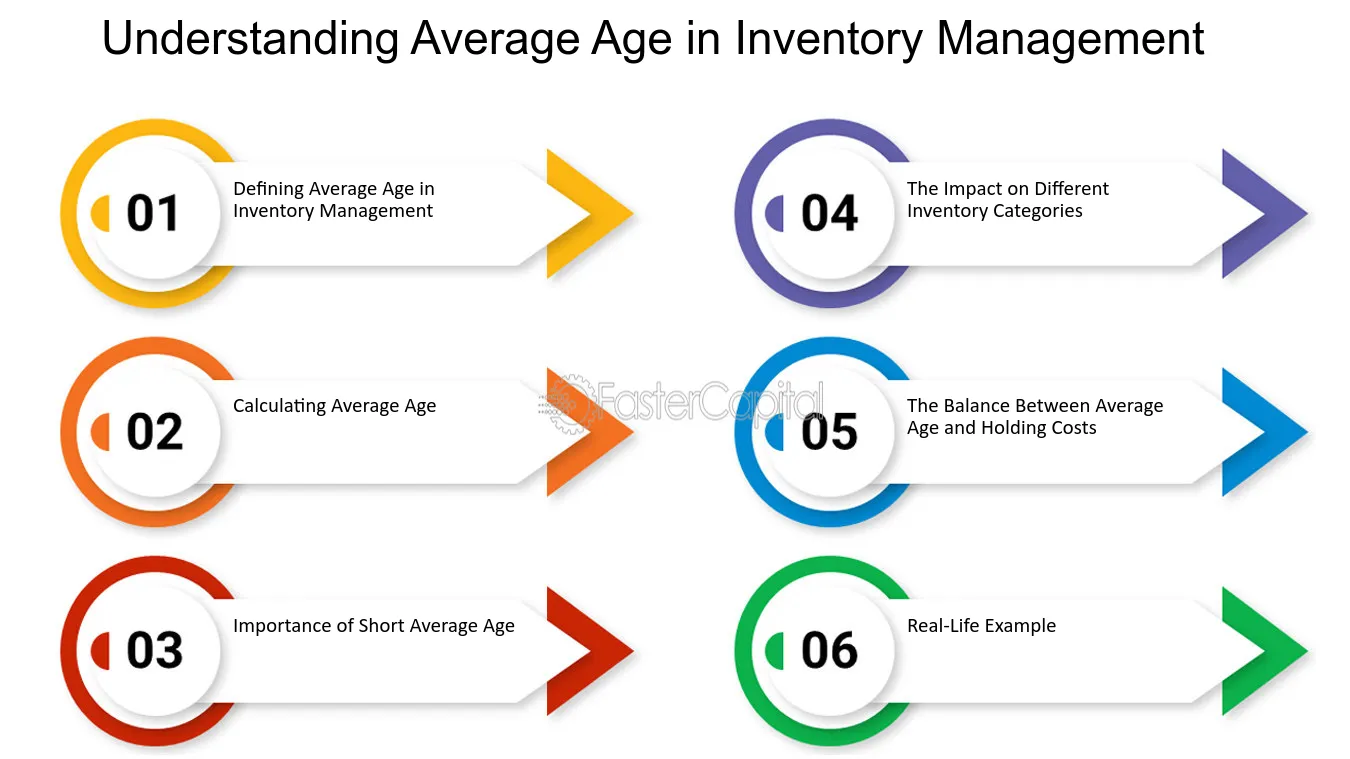
Understanding Average Age in Inventory Management - ABC analysis: Prioritizing Inventory Management for Average Age
2. Strategies for Managing High Average Age Inventory
In the realm of inventory management, one key metric that demands attention is the average age of inventory. This metric essentially measures the length of time that items sit in a warehouse before being sold or used. A high average age can be indicative of various issues, such as slow-moving products, inadequate demand forecasting, or ineffective inventory management practices. To tackle this challenge, businesses need to implement strategies that address the root causes and ensure efficient management of their inventory. In this section, we will delve into some effective strategies for managing high average age inventory, providing insights from different perspectives and offering practical tips for improvement.
1. Optimize demand forecasting: Accurate demand forecasting is crucial for maintaining optimal inventory levels. By analyzing historical sales data, market trends, and customer behavior, businesses can gain valuable insights into demand patterns. This enables them to make informed decisions about inventory replenishment, reducing the likelihood of overstocking or understocking. For instance, a company specializing in outdoor gear may identify a surge in demand for camping equipment during the summer months. By leveraging this information, they can adjust their inventory levels accordingly, avoiding excess inventory and potential obsolescence.
2. Implement an inventory classification system: Categorizing inventory based on its value and demand can significantly enhance inventory management efforts. One commonly used classification system is the ABC analysis, which segments inventory into three categories: A, B, and C. Category A includes high-value items with high demand, while Category C comprises low-value items with low demand. By prioritizing the management of Category A items, businesses can ensure that their most valuable products are readily available and minimize the risk of stockouts. On the other hand, a more relaxed approach can be adopted for Category C items, reducing the need for excessive storage space and excessive attention.
3. Establish effective communication channels: Collaboration and communication between different departments within a company are vital for inventory management success. Sales teams can provide valuable insights into customer preferences and market trends, enabling inventory managers to make more informed decisions. Additionally, cross-functional meetings and regular updates on inventory levels can help identify slow-moving items and take proactive measures to address them. By fostering a culture of open communication, businesses can streamline their inventory management processes and reduce the average age of inventory.
4. Implement just-in-time (JIT) inventory management: JIT is a lean inventory management approach that aims to minimize inventory holding costs by receiving goods only when they are needed for production or sale. By synchronizing the supply chain and production processes, businesses can reduce lead times and eliminate the need for excess inventory. This strategy is particularly effective for perishable or seasonal products, as it ensures freshness and minimizes the risk of obsolescence. For example, a bakery may adopt JIT inventory management for their daily bread production, ensuring that they have just enough inventory to meet customer demand while minimizing waste.
5. Leverage technology and automation: In today's digital era, technology plays a crucial role in optimizing inventory management. Inventory management software can provide real-time visibility into inventory levels, enabling businesses to track and monitor stock movements efficiently. Furthermore, automation tools can streamline various processes, such as order fulfillment and replenishment, reducing the chances of human error and improving overall efficiency. For instance, an e-commerce retailer may use automated reorder triggers based on predefined inventory thresholds to ensure timely replenishment of fast-moving products.
By implementing these strategies, businesses can effectively manage high average age inventory and optimize their overall inventory management practices. From accurate demand forecasting to leveraging technology, each approach brings its own benefits and contributes to reducing the average age of inventory. Ultimately, by prioritizing inventory management and continuously evaluating and refining their strategies, businesses can maintain a healthy balance between inventory levels and customer demand, maximizing profitability and customer satisfaction.
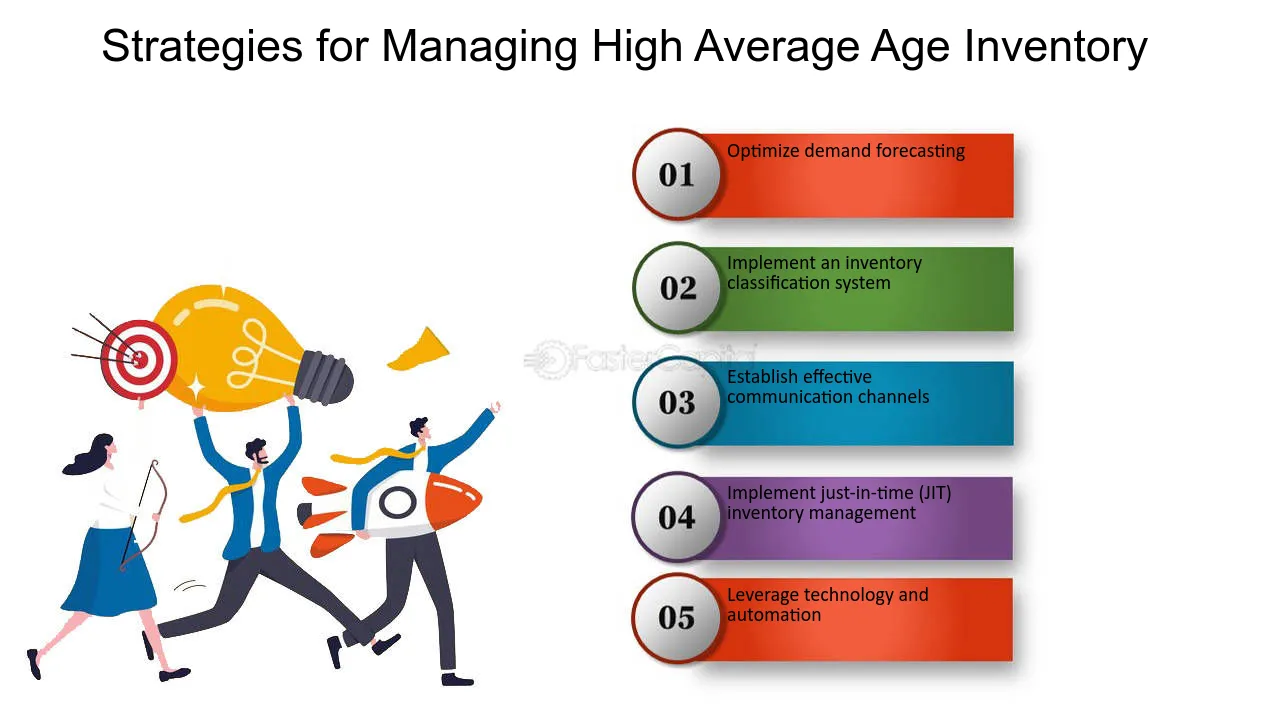
Strategies for Managing High Average Age Inventory - ABC analysis: Prioritizing Inventory Management for Average Age
3. Understanding the Importance of Maintaining Average Age of Inventory
Understanding the Importance of Maintaining Average Age of Inventory
When it comes to inventory management, one crucial aspect that often gets overlooked is the average age of inventory. This metric measures the average number of days it takes for a product to be sold after it has been received into the inventory. Maintaining a healthy average age of inventory is essential for businesses as it directly impacts their profitability, customer satisfaction, and overall operational efficiency. In this section, we will delve deeper into the significance of this metric and explore different perspectives on why it should be a priority for businesses.
1. Financial Implications:
Maintaining a reasonable average age of inventory is directly linked to a company's financial health. By minimizing the average age of inventory, businesses can reduce holding costs, such as storage fees, insurance, and depreciation, which can eat into their profit margins. Additionally, a lower average age of inventory allows businesses to free up working capital, enabling them to invest in other areas of the company or take advantage of new opportunities. Conversely, a high average age of inventory can tie up valuable resources, leading to cash flow issues and hindering growth.
2. Customer Satisfaction:
From a customer's perspective, having access to products promptly is crucial for a positive shopping experience. If a business frequently experiences out-of-stocks or delays in fulfilling orders due to high average age of inventory, it can result in frustrated customers who may turn to competitors. For instance, imagine a customer wanting to purchase a popular item online but finding it consistently out of stock. They are likely to seek alternative options, potentially leading to a loss of sales and loyal customers. By maintaining a healthy average age of inventory, businesses can ensure they meet customer demand promptly, enhancing customer satisfaction and loyalty.
3. Operational Efficiency:
Efficient inventory management is vital for the smooth functioning of any business. A high average age of inventory often indicates inefficiencies in the supply chain, such as inaccurate demand forecasting, procurement delays, or inadequate inventory control. These inefficiencies can result in excess inventory, leading to increased carrying costs and a higher risk of obsolescence. On the other hand, a low average age of inventory indicates a streamlined and responsive supply chain, allowing businesses to operate efficiently, reduce waste, and optimize resources.
4. Examples of Maintaining Average Age of Inventory:
To illustrate the importance of maintaining the average age of inventory, let's consider a retail clothing store. If the store fails to manage its inventory effectively and experiences a high average age of inventory, it may end up with an excess of out-of-fashion or seasonal clothing. As a result, the store would have to heavily discount these items to clear the inventory, leading to decreased profit margins. Conversely, a store that maintains a low average age of inventory can quickly respond to fashion trends and ensure that its shelves are stocked with the latest styles, attracting more customers and maximizing sales.
5. Balancing Act:
It is important to note that maintaining the average age of inventory is a delicate balancing act. While a low average age of inventory is generally desirable, businesses must also avoid the opposite extreme of carrying too little inventory. Insufficient inventory levels can lead to frequent stockouts, missed sales opportunities, and dissatisfied customers. Striking the right balance requires businesses to analyze demand patterns, optimize procurement processes, and leverage technology to improve forecasting accuracy.
By understanding the importance of maintaining the average age of inventory, businesses can make informed decisions to optimize their inventory management strategies. From financial implications to customer satisfaction and operational efficiency, this metric serves as a valuable indicator of a company's overall health and success. As we delve deeper into the topic of backordering and its impact on average age of inventory, we will explore strategies and best practices that businesses can adopt to ensure a healthy and efficient inventory management system.
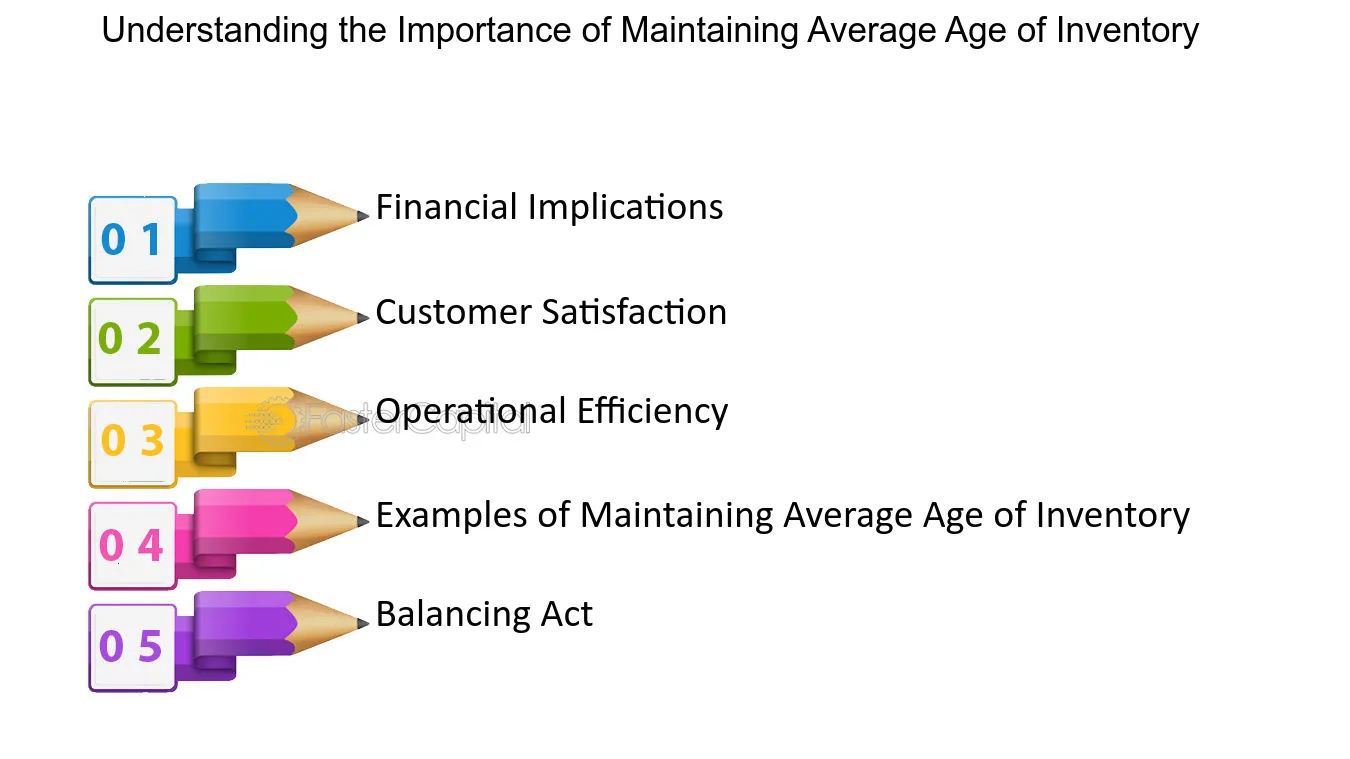
Understanding the Importance of Maintaining Average Age of Inventory - Backordering: Maintaining Average Age of Inventory during Out of Stocks
4. The Impact of Out-of-Stocks on Average Age of Inventory
When a business experiences an out-of-stock situation, it can have a significant impact on its average age of inventory. Average age of inventory refers to the average amount of time it takes for a product to be sold or used up. Out-of-stocks occur when there is no inventory available to fulfill customer orders or meet internal demand. This can happen due to various reasons such as supply chain disruptions, unexpected spikes in demand, or forecasting errors. In this section, we will explore the effects of out-of-stocks on the average age of inventory and discuss strategies to mitigate these impacts.
1. Increased average age of inventory: When a product is out of stock, it remains unsold or unused, leading to an increase in the average age of inventory. This means that the overall inventory is aging, and the longer it remains unsold, the higher the average age becomes. Higher average age of inventory can have several negative consequences for a business, including increased carrying costs, reduced cash flow, and potential obsolescence of products.
2. Customer dissatisfaction and lost sales: Out-of-stocks can result in customer dissatisfaction and lost sales. When customers are unable to purchase a desired product due to it being out of stock, they may turn to competitors or seek alternative solutions. This not only leads to missed sales opportunities but also affects customer loyalty and brand reputation. In addition, customers may perceive a business as unreliable or unprepared, further damaging the relationship.
3. Inventory replenishment delays: When an out-of-stock situation occurs, it takes time to replenish the inventory and bring the product back in stock. This delay in replenishment can further contribute to an increase in the average age of inventory. The longer it takes to restock, the longer the product remains unsold, resulting in a higher average age.
4. impact on supply chain efficiency: Out-of-stocks can disrupt the smooth functioning of the supply chain. When a product is out of stock, it can cause delays in fulfilling customer orders and result in increased lead times. This can have a domino effect on other products and inventory levels, affecting the overall efficiency of the supply chain. It is crucial for businesses to closely monitor and manage their inventory levels to minimize the impact of out-of-stocks on supply chain operations.
5. Mitigating the impact of out-of-stocks: To maintain a healthy average age of inventory during out-of-stock situations, businesses can implement several strategies. These include:
A. accurate demand forecasting: By accurately forecasting demand, businesses can ensure that they have the right amount of inventory on hand to meet customer needs. This can help in preventing out-of-stock situations and minimizing the impact on average age of inventory.
B. Safety stock management: Safety stock refers to the extra inventory kept on hand to buffer against unexpected fluctuations in demand or supply. By maintaining an appropriate level of safety stock, businesses can mitigate the impact of out-of-stocks on average age of inventory.
C. efficient supply chain management: Streamlining supply chain processes and improving communication with suppliers can help in reducing lead times and replenishment delays. This can ensure that products are restocked promptly, minimizing the impact on average age of inventory.
D. Implementing backordering: Backordering allows customers to place orders for out-of-stock products, ensuring that the demand is captured and fulfilled once the inventory is replenished. This can help in reducing lost sales and maintaining a healthy average age of inventory.
Out-of-stocks can have a significant impact on the average age of inventory. It leads to increased average age, customer dissatisfaction, lost sales, and supply chain inefficiencies. However, by implementing effective strategies such as accurate demand forecasting, safety stock management, efficient supply chain practices, and backordering, businesses can mitigate these impacts and maintain a healthy average age of inventory.
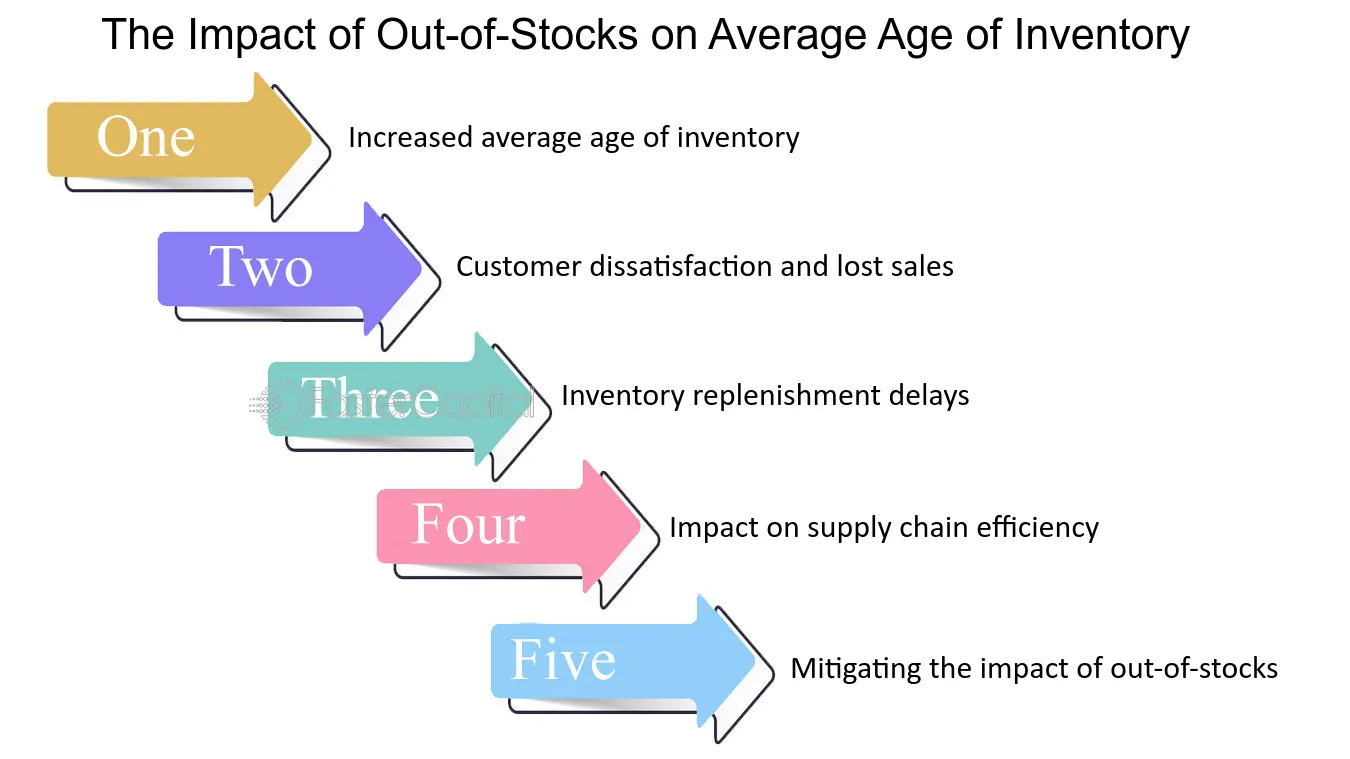
The Impact of Out of Stocks on Average Age of Inventory - Backordering: Maintaining Average Age of Inventory during Out of Stocks
5. A Solution for Maintaining Average Age of Inventory
Section 1: The Challenge of Maintaining Average Age of Inventory
In the world of inventory management, one of the critical metrics that businesses often strive to optimize is the Average Age of Inventory. It's a measure of how long, on average, items sit in the warehouse before being sold. Maintaining a healthy Average Age of Inventory is essential because it directly impacts a company's profitability, cash flow, and customer satisfaction. When items linger in the warehouse for too long, they tie up capital and increase carrying costs, making it harder to adapt to market changes. On the other hand, if inventory turnover is too rapid, it can lead to stockouts and potential revenue loss. Striking the right balance is challenging, especially during periods of high demand or supply chain disruptions.
1. Inventory Holding Costs: One perspective on this challenge comes from the financial side of the business. Holding inventory incurs costs such as storage, insurance, and depreciation. A longer Average Age of Inventory generally means higher holding costs. For instance, consider a retailer with a surplus of winter coats during the summer months. Holding onto these items for an extended period incurs storage costs without generating revenue.
2. Customer Expectations: From a customer-centric viewpoint, maintaining a reasonable Average Age of Inventory is essential to meet customer expectations. Customers today expect prompt deliveries and readily available products. When a product is consistently out of stock, it can lead to dissatisfaction and loss of customers. An example of this can be seen in the tech industry, where demand for the latest gadgets is high. Companies must ensure they have enough stock to meet demand while not overstocking on soon-to-be outdated models.
Section 2: Backordering as a Solution
So, how can businesses effectively manage their Average Age of Inventory, especially during periods of out-of-stock situations? One solution that has gained traction is backordering, a strategy that can help strike that delicate balance between inventory turnover and customer satisfaction.
1. Strategic Allocation: Backordering allows companies to strategically allocate limited inventory to fulfill orders. For example, if a popular item is temporarily out of stock, customers can still place orders for it. This ensures that the company doesn't lose potential sales and can fulfill them when new stock arrives. This approach minimizes revenue loss while maintaining a reasonable Average Age of Inventory.
2. Transparent Communication: Effective communication is key when implementing backordering. Companies must clearly communicate to customers that their desired items are temporarily out of stock but will be available soon. This transparency helps manage customer expectations and can even build trust. An example of this can be seen in the fashion industry, where pre-orders for upcoming clothing collections are common. Customers know they're reserving items in advance, and they're willing to wait.
3. Data-Driven Insights: Backordering isn't a one-size-fits-all solution. Businesses must rely on data to determine which items are suitable for backordering and how much stock to allocate. For instance, an online bookstore might allow customers to backorder a highly anticipated book release, ensuring they don't miss out on sales while controlling inventory levels for less popular titles.
4. Supply Chain Efficiency: Implementing backordering can also incentivize businesses to improve their supply chain efficiency. Knowing that customers are willing to wait for an item can reduce the pressure to maintain excessive safety stock, leading to cost savings in the long run.
Backordering is a strategic tool that can help businesses maintain their Average Age of inventory during out-of-stock situations. By leveraging this approach along with transparent communication and data-driven insights, companies can minimize revenue loss, keep customers satisfied, and strike that essential balance in inventory management.
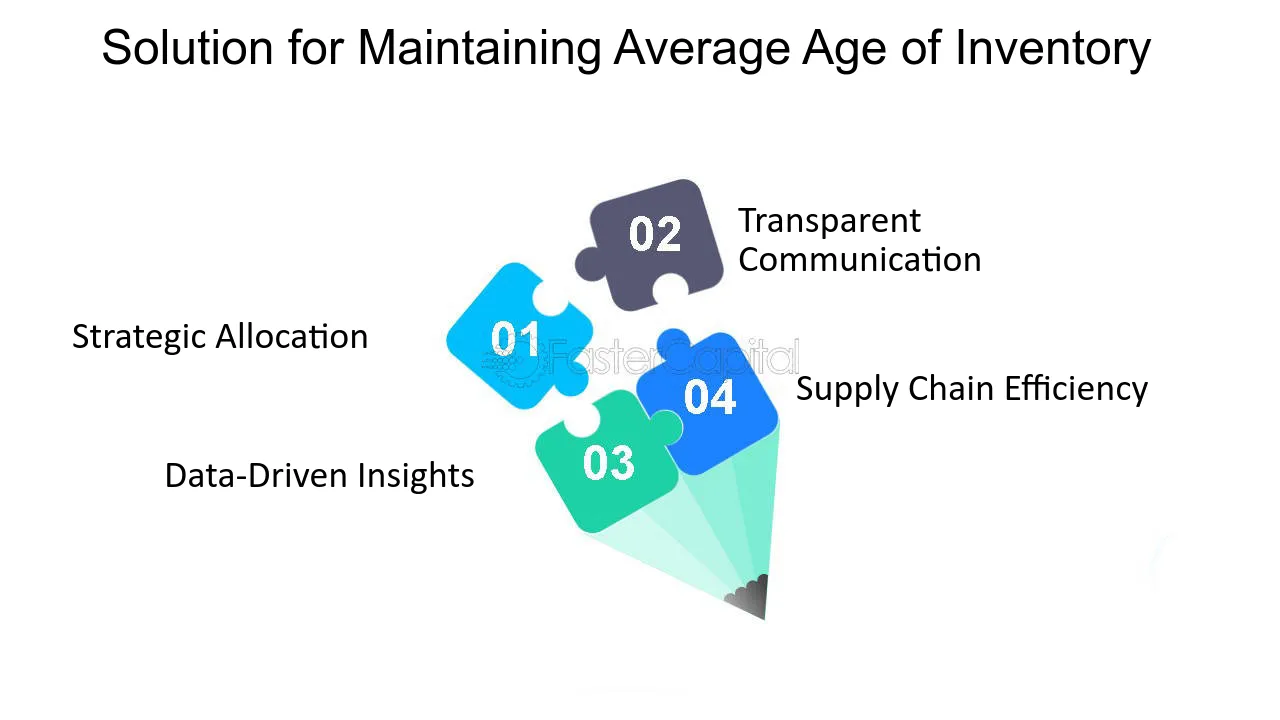
A Solution for Maintaining Average Age of Inventory - Backordering: Maintaining Average Age of Inventory during Out of Stocks
6. Overcoming Challenges in Backordering to Maintain Average Age of Inventory
One of the biggest challenges in backordering is to maintain the average age of inventory. When a product goes out-of-stock, it can disrupt the smooth flow of operations and lead to dissatisfied customers. Backordering, which involves accepting orders for products that are temporarily unavailable, can be a useful strategy to manage inventory and keep customers happy. However, it is not without its challenges. In this section, we will discuss some of the common challenges faced in backordering and how they can be overcome to maintain the average age of inventory.
1. Communication and Transparency: Communication plays a crucial role in backordering. It is essential to keep customers informed about the status of their orders and provide realistic estimated delivery dates. Lack of transparency can lead to frustration and, ultimately, loss of customers. To overcome this challenge, implement a robust system to update customers about their backordered items regularly. Utilize automated emails or notifications to provide real-time updates on order status. Transparency builds trust and helps manage customer expectations effectively.
2. Supplier Reliability: Backordering relies heavily on suppliers' ability to deliver the products on time. However, supplier reliability can be a significant challenge. Late deliveries or failure to fulfill orders can lead to increased average age of inventory and customer dissatisfaction. To mitigate this challenge, develop strong relationships with reliable suppliers. Regularly evaluate their performance and communicate your expectations clearly. Consider having backup suppliers to ensure a steady supply of products during peak demand or unforeseen circumstances.
3. Inventory Management: Maintaining an optimal inventory level is crucial to avoid excessive backorders and long average age of inventory. It is essential to strike a balance between stocking enough inventory to meet demand and avoiding overstocking. Utilize inventory management software to track sales patterns, forecast demand, and optimize reorder points. Regularly analyze sales data and adjust inventory levels accordingly. By effectively managing inventory, you can reduce backorders and maintain a healthy average age of inventory.
4. efficient Order fulfillment: Backordered items require special attention to ensure efficient order fulfillment. It is essential to prioritize backorders and streamline the fulfillment process. Implement an order management system that allows easy tracking of backordered items and ensures timely fulfillment. Consider using a first-in, first-out (FIFO) approach to fulfill backorders, ensuring fairness and customer satisfaction. Efficient order fulfillment minimizes delays and helps maintain a reasonable average age of inventory.
5. Customer Satisfaction and Retention: Backordering can be a double-edged sword when it comes to customer satisfaction and retention. While it allows customers to place orders for out-of-stock items, it also tests their patience. To overcome this challenge, focus on providing exceptional customer service. Promptly address customer inquiries and concerns about backorders. Offer alternatives or substitutes for unavailable products whenever possible. By prioritizing customer satisfaction, you can minimize the negative impact of backordering on customer retention.
Backordering presents several challenges in maintaining the average age of inventory. However, with effective communication, reliable suppliers, robust inventory management, efficient order fulfillment, and a strong focus on customer satisfaction, these challenges can be overcome. By implementing strategies to address these challenges, you can successfully navigate the backordering process while maintaining a healthy average age of inventory.
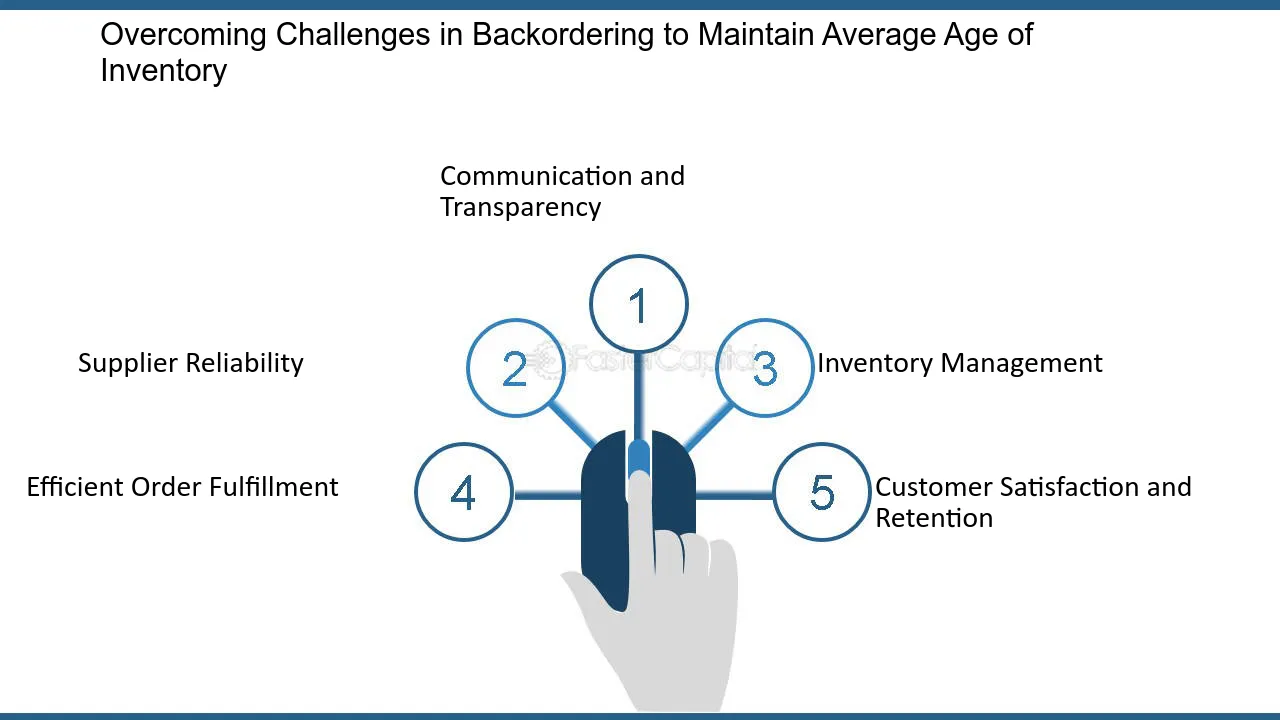
Overcoming Challenges in Backordering to Maintain Average Age of Inventory - Backordering: Maintaining Average Age of Inventory during Out of Stocks
7. Key Factors Affecting Average Age of Inventory Accuracy
Accurate inventory management is crucial for businesses to maintain a competitive edge in today's fast-paced market. In order to meet customer demands efficiently, it is essential to have a precise understanding of inventory levels and the age of inventory. The average age of inventory accuracy is a key metric that measures how quickly inventory data reflects the actual stock on hand. Several factors can significantly impact this metric, and understanding them is vital for improving demand forecasting and inventory accuracy.
1. Demand Variability: One of the primary factors affecting the average age of inventory accuracy is demand variability. Fluctuations in customer demand can lead to stockouts or overstock situations, resulting in inaccurate inventory records. For instance, if a sudden surge in demand occurs for a particular product, and the inventory system fails to capture this change promptly, it can lead to stockouts and dissatisfied customers. Implementing advanced demand forecasting techniques, such as analyzing historical sales data and market trends, can help businesses anticipate demand fluctuations and adjust inventory levels accordingly.
2. Supply Chain Delays: Delays in the supply chain can have a significant impact on inventory accuracy. If there are delays in receiving goods from suppliers or production delays within the business, it can lead to outdated inventory data. For example, if a shipment is delayed due to unforeseen circumstances, such as weather conditions or transportation issues, the inventory system may still reflect the expected arrival time, resulting in inaccurate stock levels. Collaborating closely with suppliers, monitoring lead times, and having contingency plans in place can help mitigate supply chain delays and improve inventory accuracy.
3. Inefficient Data Management: Poor data management practices can also contribute to inaccuracies in inventory records. manual data entry, outdated systems, or inadequate training of employees can lead to errors and discrepancies in inventory data. For instance, if a warehouse worker fails to update the inventory system after fulfilling an order, it can result in inaccuracies in stock levels. Adopting automated inventory management systems, implementing regular data audits, and providing comprehensive training to employees can help minimize data management errors and improve inventory accuracy.
4. Lack of real-Time visibility: Limited visibility into inventory levels and movements can hinder accurate inventory management. Without real-time information, businesses may struggle to make informed decisions, resulting in outdated inventory records. For example, if a company operates multiple warehouses or has a complex distribution network, it becomes crucial to have real-time visibility into inventory levels across all locations. Implementing inventory tracking technologies, such as RFID or barcode systems, can provide real-time visibility and enable businesses to maintain accurate inventory records.
5. Ineffective Communication: Poor communication between different departments or stakeholders can lead to discrepancies in inventory data. For instance, if sales and operations teams do not communicate effectively, it can result in inaccurate demand forecasts and inventory levels. Collaborative communication platforms and regular cross-functional meetings can help align different departments and ensure accurate information exchange. By fostering effective communication, businesses can improve demand forecasting accuracy and maintain inventory records that reflect the actual stock on hand.
Several key factors affect the average age of inventory accuracy, including demand variability, supply chain delays, inefficient data management, lack of real-time visibility, and ineffective communication. By addressing these factors, businesses can enhance demand forecasting accuracy and maintain precise inventory records. Embracing advanced technologies, improving data management practices, and fostering collaboration between departments are essential steps towards improving the average age of inventory accuracy and achieving operational excellence.
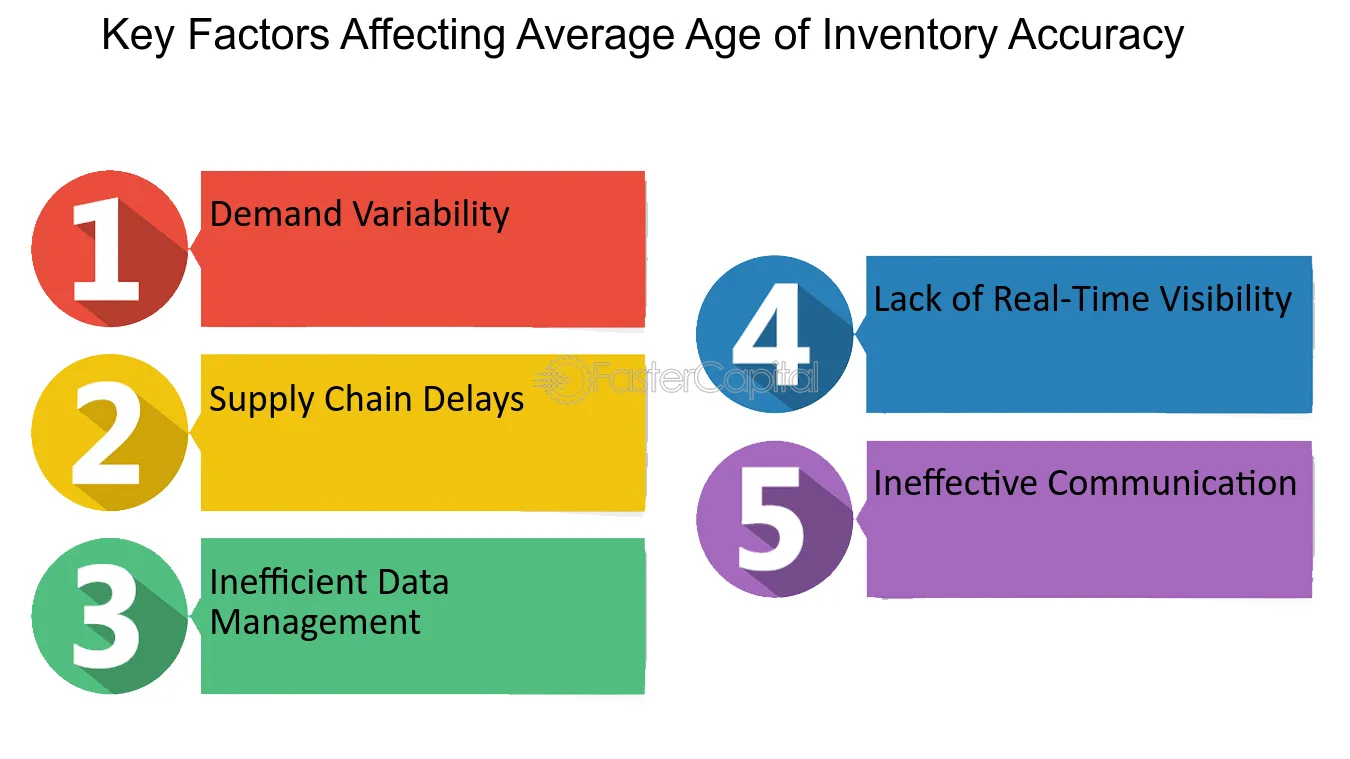
Key Factors Affecting Average Age of Inventory Accuracy - Demand forecasting: Improving Average Age of Inventory Accuracy
8. Understanding the Concept of Average Age of Inventory
In the world of inventory management, one key metric that is often used to evaluate the efficiency of a company's inventory system is the average age of inventory. This metric provides valuable insights into how long, on average, a company holds onto its inventory before it is sold or used. By understanding and optimizing the average age of inventory, businesses can effectively manage their supply chain, reduce costs, and improve overall operational efficiency.
1. Definition and Calculation: The average age of inventory is a measure that quantifies the average time it takes for inventory to be sold or used. It is calculated by dividing the total value of inventory by the cost of goods sold (COGS) and multiplying the result by 365 (the number of days in a year). For example, if a company has $500,000 worth of inventory and its COGS is $1,000,000, the average age of inventory would be 182.5 days.
2. Importance of Managing Average Age of Inventory: Keeping inventory for an extended period can tie up valuable working capital, increase carrying costs, and potentially lead to obsolescence or spoilage. On the other hand, maintaining too low of an average age of inventory can result in stockouts, lost sales, and dissatisfied customers. Therefore, finding the ideal average age of inventory is crucial for balancing cost-efficiency and customer satisfaction.
3. Factors Affecting Average Age of Inventory: Several factors influence the average age of inventory. Demand variability, lead time, order quantity, and production cycle time are some of the key factors that can impact the average age of inventory. For instance, a company with high demand variability may need to hold more inventory to ensure customer demands are met, resulting in a longer average age of inventory.
4. inventory Turnover ratio: The inventory turnover ratio is closely related to the average age of inventory. It measures the number of times inventory is sold or used during a specific period. The formula for calculating inventory turnover ratio is COGS divided by average inventory. A high turnover ratio indicates that inventory is moving quickly, resulting in a lower average age of inventory.
5. Optimizing the Average Age of Inventory: To optimize the average age of inventory, companies can employ various strategies. One such strategy is implementing a just-in-time (JIT) inventory system, where inventory is ordered and received just in time for production or sale. This approach minimizes the time inventory spends in storage, reducing the average age of inventory. Additionally, forecasting demand accurately, improving supply chain management, and implementing efficient inventory control systems can also help optimize the average age of inventory.
6. Examples: Let's consider two companies, Company A and Company B. Company A has an average age of inventory of 90 days, while Company B has an average age of inventory of 180 days. Despite having similar sales volumes, Company B's longer average age of inventory indicates potential inefficiencies in its inventory management. By analyzing the factors affecting the average age of inventory, such as demand variability and lead time, Company B can identify areas for improvement and work towards reducing its average age of inventory.
Understanding the concept of average age of inventory is essential for businesses to effectively manage their inventory levels and improve operational efficiency. By analyzing this metric, companies can make informed decisions regarding inventory ordering, storage, and replenishment. Ultimately, optimizing the average age of inventory allows businesses to strike a balance between reducing costs and meeting customer demands.
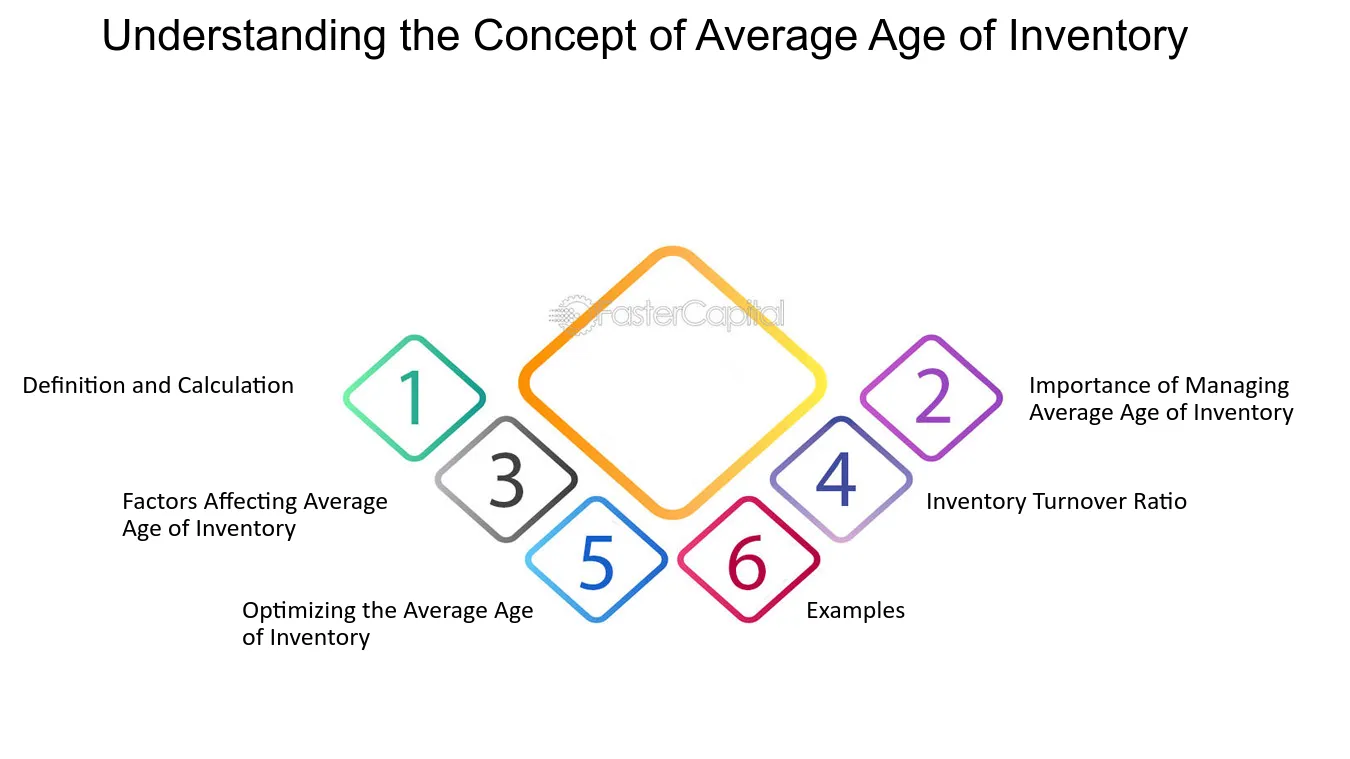
Understanding the Concept of Average Age of Inventory - Economic order quantity: EOQ: Finding the Ideal Average Age of Inventory
9. Importance of Finding the Ideal Average Age of Inventory
The importance of finding the ideal average age of inventory cannot be overstated in the context of economic order quantity (EOQ). This crucial metric allows businesses to strike a delicate balance between holding too much inventory, which ties up valuable capital, and holding too little inventory, which can lead to stockouts and missed opportunities. By determining the optimal average age of inventory, companies can minimize costs, maximize efficiency, and ensure smooth operations. In this section, we will delve into the significance of finding the ideal average age of inventory and explore various perspectives to shed light on this critical aspect of inventory management.
One of the primary reasons for determining the ideal average age of inventory is to minimize holding costs. Holding costs include expenses such as warehousing, insurance, maintenance, and obsolescence. Holding excess inventory for an extended period can significantly increase these costs. On the other hand, holding too little inventory can result in frequent replenishment orders, leading to increased ordering costs. By finding the optimal average age of inventory, businesses can strike a balance between these costs, ensuring that they neither tie up excessive capital nor incur unnecessary expenses.
Example: A clothing retailer must carefully manage its average age of inventory to minimize holding costs. If the retailer holds excessive inventory of a particular style for an extended period, it risks being left with unsold items as fashion trends change. Conversely, if the retailer holds too little inventory, it may face stockouts, leading to missed sales opportunities. By analyzing historical sales data and market trends, the retailer can determine the ideal average age of inventory for each product category, minimizing holding costs while meeting customer demand.
2. Optimizing production and supply chain efficiency:
Another crucial aspect of finding the ideal average age of inventory is optimizing production and supply chain efficiency. By understanding the average age of inventory, businesses can align their production schedules and supply chain operations accordingly. This alignment ensures that production is neither underutilized nor overwhelmed, leading to a more efficient and cost-effective operation.
Example: An automobile manufacturer must carefully manage its average age of inventory to optimize production efficiency. Holding excessive inventory for an extended period ties up capital and increases holding costs. On the other hand, holding too little inventory can disrupt the production line and lead to delays. By analyzing demand forecasts, production capacity, and lead times, the manufacturer can determine the ideal average age of inventory, ensuring a smooth production process and minimizing costs.
3. Meeting customer demand and reducing stockouts:
Finding the ideal average age of inventory is crucial for meeting customer demand while minimizing stockouts. By analyzing historical sales data, market trends, and customer preferences, businesses can determine the optimal inventory levels required to fulfill customer orders promptly. maintaining the right average age of inventory helps ensure that products are available when customers need them, enhancing customer satisfaction and loyalty.
Example: An e-commerce platform must carefully manage its average age of inventory to meet customer demand and avoid stockouts. Holding excessive inventory for an extended period ties up capital and increases the risk of inventory becoming obsolete. Conversely, holding too little inventory may result in stockouts, leading to dissatisfied customers and potential loss of sales. By analyzing customer buying patterns, seasonality, and lead times, the e-commerce platform can determine the ideal average age of inventory for each product, ensuring high customer satisfaction and minimizing stockouts.
Finding the ideal average age of inventory is of utmost importance in the context of economic order quantity (EOQ). It enables businesses to minimize holding costs, optimize production and supply chain efficiency, and meet customer demand while reducing stockouts. By carefully analyzing historical data, market trends, and customer preferences, companies can strike the perfect balance between holding too much or too little inventory, ensuring a smooth and profitable operation.
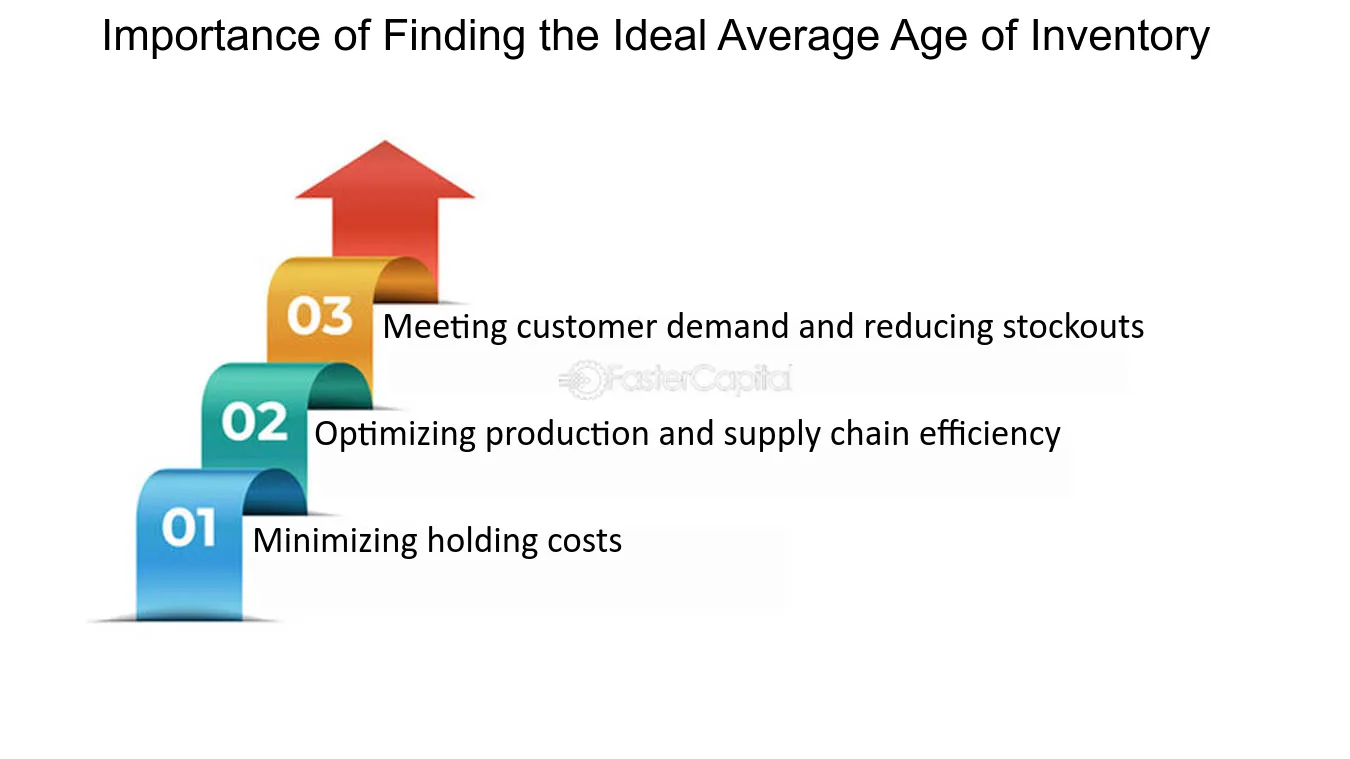
Importance of Finding the Ideal Average Age of Inventory - Economic order quantity: EOQ: Finding the Ideal Average Age of Inventory
10. Factors Affecting the Average Age of Inventory
The average age of inventory is a crucial metric for businesses to monitor and optimize. It represents the average length of time that inventory items remain in stock before being sold or used. understanding the factors that influence this metric is essential for achieving efficiency in inventory management and maximizing profitability. In this section, we will delve into the various factors that affect the average age of inventory, exploring insights from different perspectives and providing in-depth information to help businesses make informed decisions.
1. Demand Variability: One of the primary factors influencing the average age of inventory is demand variability. Fluctuations in customer demand can significantly impact how quickly inventory items are sold or used. When demand is stable and predictable, businesses can maintain lower inventory levels, leading to a shorter average age of inventory. Conversely, if demand is highly variable, businesses may need to hold higher levels of inventory to avoid stockouts, resulting in a longer average age of inventory. For example, a retailer selling seasonal products like swimwear may experience high demand during the summer months and minimal demand during the rest of the year, leading to a longer average age of inventory.
2. Lead Time: Lead time, which refers to the time it takes for inventory to be replenished after it has been ordered, is another critical factor affecting the average age of inventory. Longer lead times generally result in a longer average age of inventory, as it takes more time for new stock to arrive and be sold or used. Businesses that rely on international suppliers or manufacturers located far away may face longer lead times due to shipping and transportation delays. Conversely, businesses with shorter lead times can maintain lower inventory levels and achieve a shorter average age of inventory. For instance, a company that sources inventory from local suppliers can benefit from shorter lead times, enabling them to replenish stock more quickly and reduce the average age of inventory.
3. Ordering Frequency and Batch Size: The frequency of orders placed and the batch size of each order can significantly impact the average age of inventory. Ordering more frequently with smaller batch sizes allows businesses to keep inventory levels low, resulting in a shorter average age of inventory. On the other hand, ordering less frequently with larger batch sizes can lead to higher inventory levels and a longer average age of inventory. The trade-off lies in finding the optimal balance between ordering costs and holding costs. For example, a restaurant that orders fresh produce daily in small quantities can maintain a shorter average age of inventory compared to a restaurant that orders large quantities once a week.
4. Seasonality and Trends: Seasonal fluctuations and trends in consumer behavior can also influence the average age of inventory. Businesses that experience predictable seasonal demand patterns may adjust their inventory levels accordingly, resulting in shorter average age of inventory during peak seasons. Additionally, staying abreast of trends can help businesses proactively manage inventory levels to meet changing customer preferences and avoid obsolescence. For instance, a fashion retailer that accurately predicts upcoming trends can stock inventory accordingly, reducing the average age of inventory during the peak trend period.
5. Product Shelf Life: The shelf life of products is a crucial factor when considering the average age of inventory. Perishable or time-sensitive goods require careful inventory management to minimize waste and obsolescence. Businesses dealing with such products must consider the expiration dates or product lifecycles to ensure timely sales or usage. In industries like food and pharmaceuticals, where product quality and safety are paramount, managing the average age of inventory becomes even more critical. For example, a bakery specializing in fresh bread must carefully monitor the average age of inventory to prevent spoilage and maintain customer satisfaction.
Understanding and managing these factors can help businesses optimize their average age of inventory, leading to improved efficiency, reduced holding costs, and increased profitability. By analyzing demand variability, lead time, ordering frequency and batch size, seasonality and trends, and product shelf life, businesses can make informed decisions about inventory management strategies. Striking the right balance between these factors while considering industry-specific requirements will enable businesses to find their ideal average age of inventory and thrive in a competitive market.
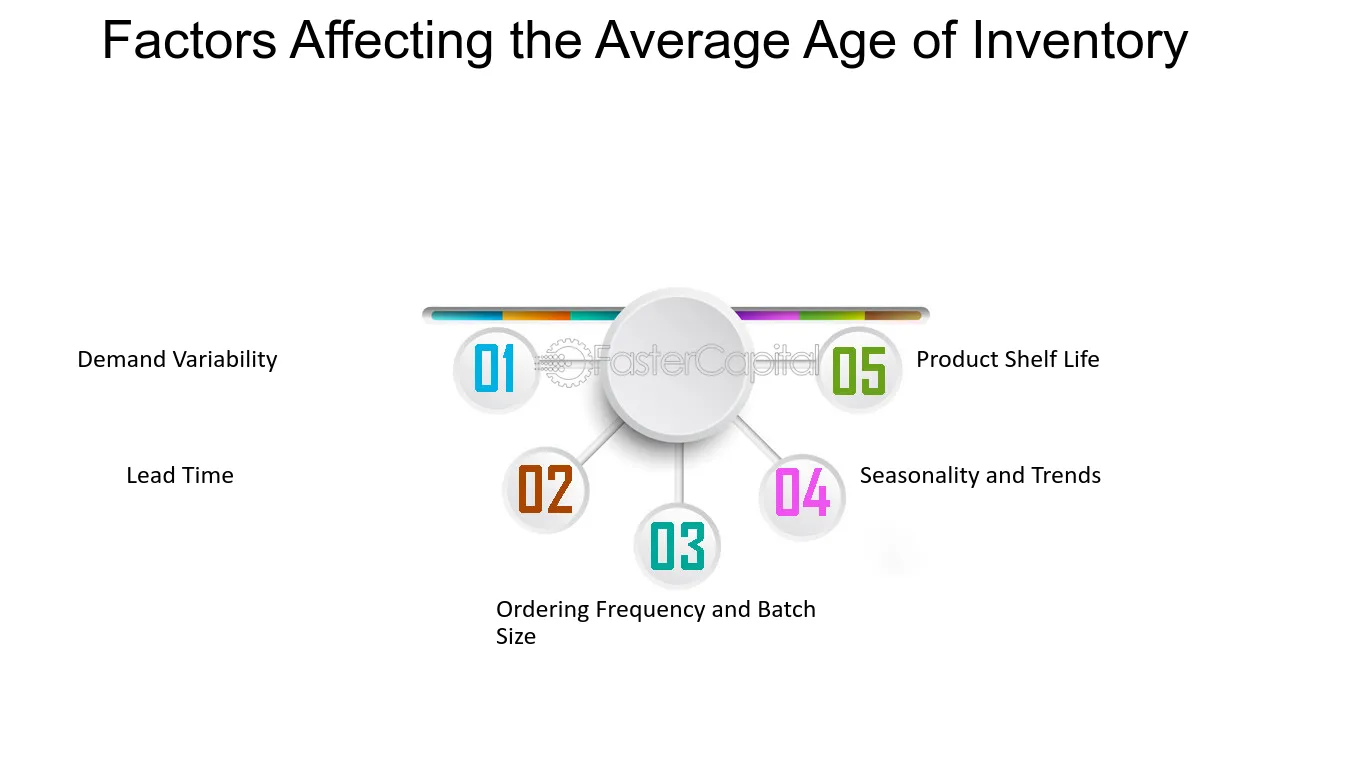
Factors Affecting the Average Age of Inventory - Economic order quantity: EOQ: Finding the Ideal Average Age of Inventory
11. Strategies for Optimizing Average Age of Inventory
In the world of inventory management, finding the ideal average age of inventory is crucial for businesses to maintain a healthy balance between stock availability and cost efficiency. The average age of inventory refers to the average amount of time it takes for inventory to be sold or consumed. A longer average age of inventory can result in higher carrying costs, increased risk of obsolescence, and potential loss of sales due to stockouts. On the other hand, a shorter average age of inventory may lead to higher ordering costs and missed opportunities for bulk purchasing discounts. To strike the right balance, businesses need effective strategies for optimizing the average age of inventory.
From a supply chain perspective, it is important to consider factors such as lead time, demand variability, and customer expectations when developing strategies to optimize the average age of inventory. By implementing the following strategies, businesses can streamline their inventory management practices and achieve optimal results:
1. accurate demand forecasting: A key aspect of inventory optimization is accurately predicting customer demand. By utilizing historical data, market trends, and customer insights, businesses can forecast demand more accurately. This enables them to adjust their inventory levels accordingly, reducing the risk of excess stock or stockouts. For example, a retailer can use point-of-sale data and market research to forecast demand for seasonal products, ensuring they have the right amount of inventory on hand to meet customer demands during peak periods.
2. Implementing just-in-time (JIT) inventory management: JIT is a popular inventory management strategy that aims to minimize carrying costs and improve cash flow by receiving inventory just in time for production or customer delivery. By implementing JIT practices, businesses can reduce their average age of inventory and minimize the risk of obsolescence. For instance, a manufacturer can establish strong relationships with suppliers and receive raw materials only when needed, eliminating the need for excessive inventory storage.
3. Optimal order quantities: Determining the optimal order quantity is crucial for balancing inventory carrying costs and ordering costs. The economic order quantity (EOQ) formula helps businesses calculate the ideal order quantity that minimizes total inventory costs. By considering factors such as holding costs, ordering costs, and demand patterns, businesses can optimize their order quantities and maintain a healthy average age of inventory. For instance, a wholesaler can use the EOQ formula to determine the most cost-effective order quantity for a particular product, ensuring they have enough stock to meet customer demand without incurring unnecessary costs.
4. Efficient inventory replenishment: Streamlining the inventory replenishment process is vital for maintaining an optimal average age of inventory. Businesses can utilize technologies such as automated inventory management systems and barcode scanning to improve accuracy and efficiency in the replenishment process. By closely monitoring inventory levels and setting up automated reorder points, businesses can ensure timely replenishment and minimize stockouts or overstock situations. For example, an e-commerce company can integrate its online store with an inventory management system that automatically triggers reorder notifications when stock levels reach a certain threshold.
5. Regular inventory analysis and optimization: Continuous evaluation and optimization of inventory levels are essential for maintaining a healthy average age of inventory. By conducting regular inventory analysis, businesses can identify slow-moving or obsolete items and take appropriate actions such as discounting, liquidation, or discontinuation. Additionally, businesses can leverage data analytics tools to identify trends, patterns, and seasonality in customer demand, enabling them to adjust inventory levels accordingly. For instance, a fashion retailer can analyze sales data to identify trends in color preferences or styles, allowing them to optimize their inventory assortment for maximum sales and minimal aging.
By implementing these strategies, businesses can optimize their average age of inventory, ensuring they have the right amount of stock at the right time. Achieving the ideal balance between stock availability and cost efficiency is a continuous process that requires ongoing monitoring, analysis, and adjustment. Embracing technology, leveraging data analytics, and staying attuned to market dynamics can empower businesses to make informed decisions and maintain a competitive edge in today's fast-paced business environment.
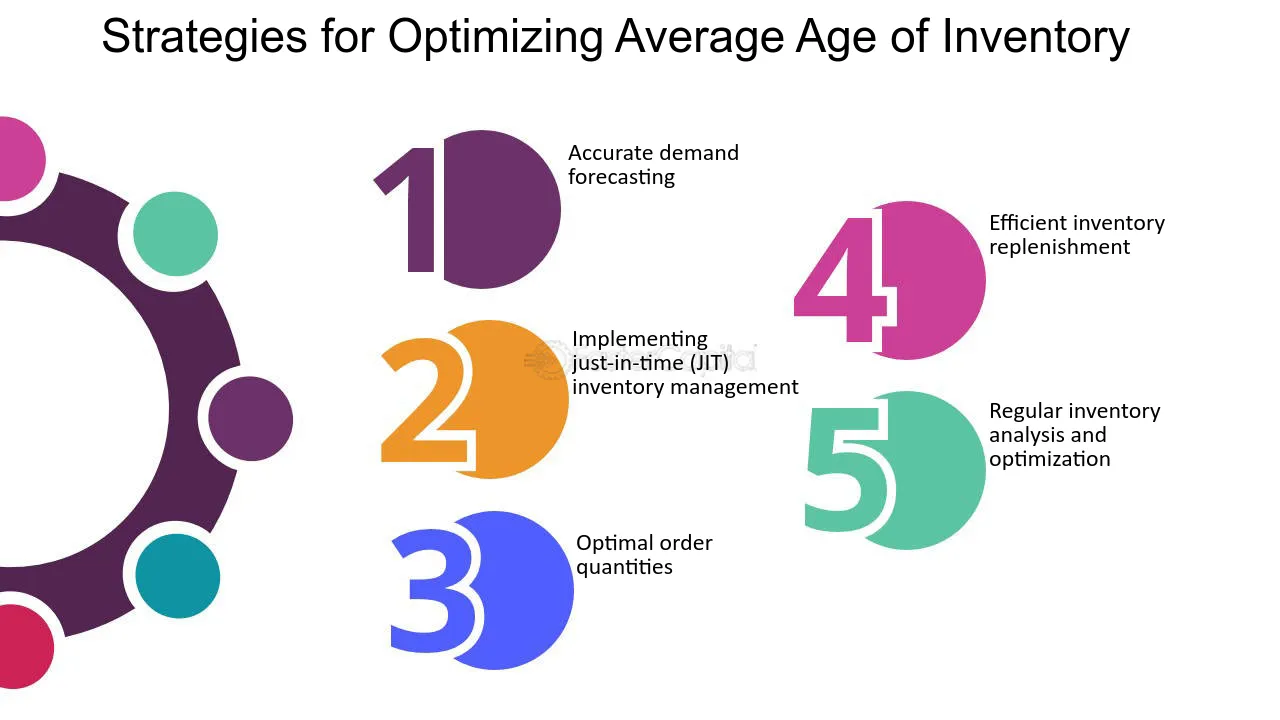
Strategies for Optimizing Average Age of Inventory - Economic order quantity: EOQ: Finding the Ideal Average Age of Inventory
12. Successful Implementation of EOQ and Average Age of Inventory
Case Studies: Successful Implementation of EOQ
Implementing the economic order quantity (EOQ) model can be a game-changer for businesses looking to optimize their inventory management. By finding the ideal average age of inventory, companies can ensure that they maintain optimal stock levels, minimize holding costs, and maximize profitability. In this section, we will explore some real-life case studies that demonstrate the successful implementation of EOQ and the benefits it brings.
1. Case Study 1: Company A, a manufacturing firm, was facing challenges with inventory management, resulting in frequent stockouts and excess inventory. By implementing the EOQ model, they were able to determine the optimal order quantity that minimized holding costs and eliminated stockouts. As a result, the company experienced a significant reduction in carrying costs and improved customer satisfaction due to better product availability.
2. Case Study 2: Retailer B was struggling with overstocking certain products while running out of others. By applying EOQ principles, they analyzed demand patterns, lead times, and holding costs to determine the ideal order quantity and reorder point for each item. This enabled them to maintain optimal stock levels, reduce excess inventory, and avoid stockouts. Consequently, the retailer saw an increase in sales and a reduction in holding costs, leading to improved profitability.
3. Case Study 3: Distributor C, operating in a highly competitive market, faced challenges related to inventory turnover. By implementing EOQ, they were able to strike a balance between holding costs and ordering costs, resulting in efficient inventory management. This allowed them to replenish stock at the right time, avoid excess inventory, and reduce the risk of obsolescence. As a result, the distributor experienced improved cash flow, reduced storage costs, and increased customer satisfaction.
Average Age of Inventory: A Key Metric for Success
Determining the average age of inventory is crucial for businesses aiming to optimize their inventory management practices. This metric provides valuable insights into how quickly inventory is sold, how efficiently it is replenished, and how effectively it aligns with customer demand. In this section, we will delve into the significance of average age of inventory and how it can be calculated and interpreted.
1. Calculation: The average age of inventory is calculated by dividing the total value of inventory by the cost of goods sold (COGS) and multiplying the result by 365 (the number of days in a year). This provides an estimate of the number of days it takes for the inventory to be sold.
2. Interpretation: A lower average age of inventory indicates that products are selling quickly, implying efficient inventory turnover. This suggests that the business is responsive to customer demand and can avoid excess inventory and potential obsolescence. On the other hand, a higher average age of inventory may indicate slow-selling products, poor demand forecasting, or ineffective inventory management practices.
3. Importance: Monitoring the average age of inventory helps businesses identify potential issues in their supply chain and inventory management processes. It enables them to make data-driven decisions to optimize stock levels, reduce holding costs, and improve overall profitability. By adjusting order quantities, reorder points, and production schedules based on the average age of inventory, companies can align their operations with customer demand and avoid unnecessary inventory-related expenses.
These case studies highlight the successful implementation of EOQ and the benefits it brings to businesses. By optimizing inventory management practices and finding the ideal average age of inventory, companies can improve customer satisfaction, reduce holding costs, and enhance profitability. Understanding the significance of average age of inventory and leveraging it as a key metric for success empowers businesses to make informed decisions and stay ahead in today's competitive market.
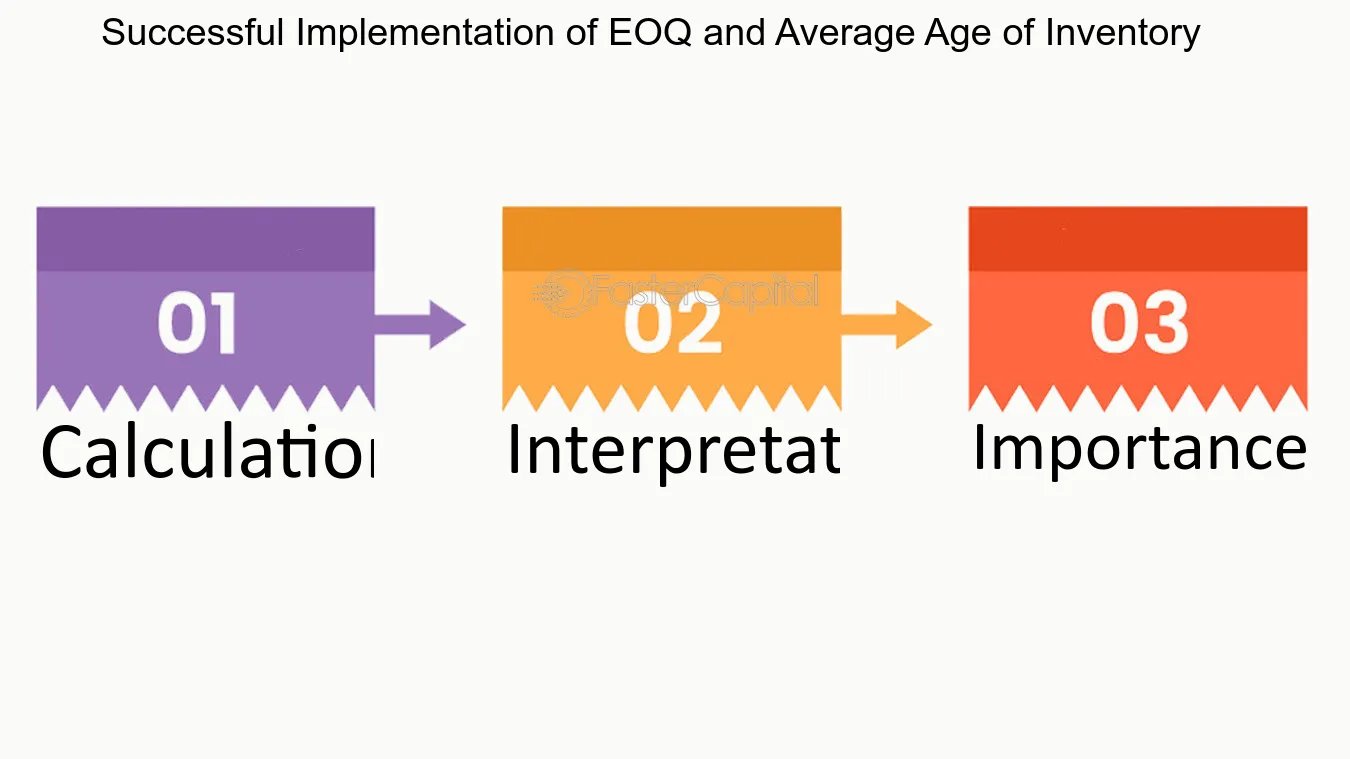
Successful Implementation of EOQ and Average Age of Inventory - Economic order quantity: EOQ: Finding the Ideal Average Age of Inventory
13. Potential Challenges and Solutions in Managing Average Age of Inventory
Managing the average age of inventory is a critical aspect of inventory management that directly impacts a company's profitability and operational efficiency. The average age of inventory refers to the average number of days it takes for inventory to be sold or used within a specified time period. This metric is crucial because it helps businesses determine the optimal level of inventory to hold, avoiding stockouts or excess inventory that can lead to financial losses. However, there are several challenges that organizations may encounter when trying to manage the average age of inventory effectively. In this section, we will explore these challenges and propose potential solutions to overcome them.
1. Demand Forecasting Accuracy:
One of the primary challenges in managing the average age of inventory is accurately forecasting demand. Inaccurate demand forecasts can result in either stockouts or excess inventory. If demand is underestimated, it may lead to stockouts, disappointing customers and potentially losing sales. On the other hand, overestimating demand can result in excess inventory, tying up valuable capital and increasing carrying costs. To address this challenge, businesses can employ advanced demand forecasting techniques, such as statistical models or machine learning algorithms, which analyze historical sales data, market trends, and other relevant factors to improve forecast accuracy.
Example: A retail clothing company experienced stockouts during the holiday season due to underestimating customer demand for a popular winter jacket. To overcome this challenge, the company implemented a demand forecasting system that considered historical sales data, weather patterns, and social media sentiment analysis to predict future demand accurately. This helped them avoid stockouts and meet customer demand efficiently.
2. Seasonality and Trends:
Seasonality and trends in consumer behavior can significantly impact the average age of inventory. Some products may have higher demand during specific times of the year, such as holiday-themed items or seasonal clothing. On the other hand, certain products may experience declining demand due to changing trends or technological advancements. Managing inventory effectively requires businesses to anticipate these fluctuations and adjust their ordering and production schedules accordingly.
Example: A toy manufacturer faced challenges in managing the average age of inventory for their seasonal products. They implemented a just-in-time manufacturing approach, where production was ramped up closer to the holiday season based on demand forecasts. This helped them reduce excess inventory and minimize carrying costs while ensuring they could meet customer demand during peak periods.
3. Supplier and Lead Time Variability:
Supplier reliability and lead time variability can pose challenges in managing the average age of inventory. Delays in receiving raw materials or finished goods from suppliers can disrupt production schedules and lead to stockouts or excess inventory. Businesses need to establish strong relationships with reliable suppliers and negotiate favorable lead times to mitigate this challenge. Additionally, maintaining safety stock levels can help buffer against unexpected delays or disruptions in the supply chain.
Example: A manufacturing company faced lead time variability from their overseas suppliers, resulting in inconsistent inventory levels. To address this challenge, they diversified their supplier base, identifying local suppliers who could provide faster lead times. They also established safety stock levels to ensure continuity of production even during unforeseen delays.
4. Obsolescence and Perishability:
For businesses dealing with products that have a limited shelf life or are prone to obsolescence, managing the average age of inventory becomes even more critical. Perishable goods, such as fresh produce or pharmaceuticals, require careful inventory management to minimize waste and maximize profitability. Similarly, industries characterized by rapid technological advancements, like electronics or fashion, need to stay ahead of trends and avoid holding obsolete inventory.
Example: A grocery store implemented a first-in, first-out (FIFO) inventory management system for perishable goods. This ensured that older products were sold first, reducing the risk of spoilage and minimizing waste. Additionally, they closely monitored market trends and collaborated with suppliers to introduce new products and discontinue slow-moving items, effectively managing the average age of inventory in a rapidly changing industry.
Managing the average age of inventory presents several challenges that require proactive solutions. Accurate demand forecasting, considering seasonality and trends, addressing lead time variability, and effectively managing obsolescence and perishability are crucial for maintaining optimal inventory levels. By employing appropriate strategies and leveraging advanced technologies, businesses can overcome these challenges and achieve efficient inventory management, ultimately driving profitability and customer satisfaction.

Potential Challenges and Solutions in Managing Average Age of Inventory - Economic order quantity: EOQ: Finding the Ideal Average Age of Inventory
14. Understanding Average Age of Inventory
When it comes to managing inventory, one key metric that businesses often track is the average age of inventory. This metric provides valuable insights into the freshness of products and helps businesses make informed decisions about restocking, promotions, and pricing strategies. By understanding the average age of inventory, businesses can maximize freshness, reduce waste, and ultimately improve customer satisfaction.
1. Definition and Calculation:
The average age of inventory is calculated by dividing the total number of days that all inventory items have been held in stock by the total number of inventory items. This calculation provides a snapshot of how long, on average, products have been sitting in the inventory before being sold. The lower the average age of inventory, the fresher the products are and the higher the chances of selling them before they become obsolete or expire.
2. Importance of Monitoring:
Monitoring the average age of inventory is crucial for businesses, especially those dealing with perishable goods or products with limited shelf life. By keeping a close eye on this metric, businesses can identify slow-moving items and take necessary actions to prevent overstocking or spoilage. Additionally, tracking the average age of inventory helps businesses assess the efficiency of their supply chain and identify potential bottlenecks.
3. Impact on Pricing and Promotions:
The average age of inventory directly influences pricing and promotional strategies. Products with a higher average age may need to be discounted or included in special promotions to incentivize customers to purchase them before they become outdated or less desirable. On the other hand, products with a lower average age can be priced higher, reflecting their freshness and premium quality.
For example, a bakery that specializes in freshly baked goods may track the average age of its bread inventory. If the average age starts to increase, indicating that bread is not being sold as quickly as before, the bakery may decide to offer a "buy one, get one free" promotion to encourage customers to purchase more bread and prevent waste.
4. Inventory Turnover:
The average age of inventory is closely related to inventory turnover, which measures how quickly inventory is sold and replaced within a specific period. High inventory turnover, accompanied by a low average age of inventory, indicates efficient inventory management and a healthy business. On the other hand, low turnover and a high average age of inventory may suggest issues with demand forecasting, purchasing decisions, or product quality.
5. Strategies to Reduce Average Age of Inventory:
To minimize the average age of inventory, businesses can employ various strategies. These include optimizing demand forecasting to ensure accurate inventory levels, implementing a first-in, first-out (FIFO) inventory management system to prioritize the sale of older products, and establishing strong relationships with suppliers to ensure timely deliveries. Additionally, implementing just-in-time (JIT) inventory management can help businesses reduce excess inventory and keep products fresh.
Understanding the average age of inventory is crucial for businesses aiming to maximize freshness and minimize waste. By monitoring this metric, businesses can make informed decisions about pricing, promotions, and inventory management strategies. Ultimately, a lower average age of inventory leads to increased customer satisfaction, reduced waste, and improved profitability.
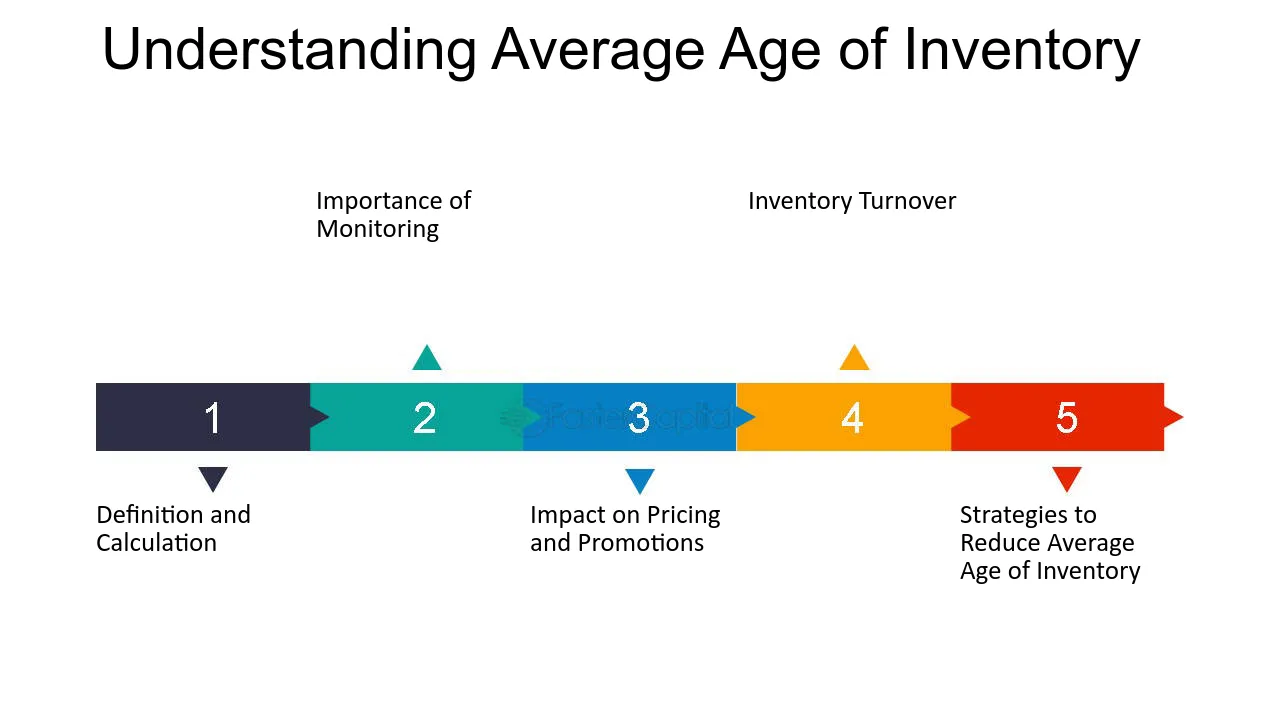
Understanding Average Age of Inventory - First Out: Maximizing Freshness: Average Age of Inventory and FIFO
15. The Significance of Average Age of Inventory in Minimizing Holding Costs
The average age of inventory is a crucial factor when it comes to minimizing holding costs in any business. Holding costs refer to the expenses incurred by a company to store and maintain its inventory until it is sold or used. These costs can include storage fees, insurance, obsolescence, and the opportunity cost of tying up capital in inventory. Therefore, reducing the average age of inventory is essential to reduce holding costs and improve overall profitability.
From the perspective of a business owner or manager, minimizing holding costs is a top priority. By reducing the average age of inventory, businesses can free up valuable resources that can be utilized elsewhere. This not only helps to lower storage costs but also minimizes the risk of inventory becoming obsolete or unsellable. By efficiently managing inventory turnover, businesses can ensure that they always have the right amount of stock on hand, avoiding excess inventory that can lead to increased holding costs.
From a financial point of view, the average age of inventory plays a significant role in determining a company's profitability. Holding costs directly impact a company's bottom line, as they eat into the potential profit margins. By reducing the average age of inventory, businesses can increase inventory turnover and generate more sales. This, in turn, leads to higher revenue and improved profitability.
To better understand the significance of the average age of inventory in minimizing holding costs, let's delve into the following points:
1. efficient inventory management: By closely monitoring and managing inventory levels, businesses can reduce the average age of inventory and minimize holding costs. Implementing inventory control systems, such as just-in-time (JIT) inventory management, can help ensure that inventory is replenished only when needed. This prevents excess stock from piling up and reduces the risk of obsolescence.
2. Demand forecasting: Accurate demand forecasting is crucial in minimizing holding costs. By analyzing historical sales data and market trends, businesses can predict future demand and adjust inventory levels accordingly. This helps to prevent overstocking or understocking, both of which can result in increased holding costs.
3. Supplier relationships: Maintaining strong relationships with suppliers is essential in reducing the average age of inventory. Timely deliveries and reliable suppliers can help businesses manage their inventory levels effectively. By working closely with suppliers to streamline the supply chain, companies can ensure that they receive inventory on time, reducing the need for excess stock.
4. Automated inventory tracking: Utilizing inventory management software or systems can greatly aid in reducing the average age of inventory. These tools provide real-time visibility into inventory levels, allowing businesses to make informed decisions about restocking and reducing holding costs. Automated tracking also helps identify slow-moving items or potential stockouts, enabling proactive measures to be taken.
In practice, let's consider a retail clothing store. By closely monitoring sales patterns and demand trends, the store manager can adjust inventory levels accordingly. For instance, if a particular style of jeans is selling rapidly, the manager can reorder more to meet the demand. On the other hand, if a certain type of shirt is not selling well, the manager can take necessary actions to prevent excess stock from accumulating. By implementing these strategies, the store can reduce the average age of inventory, minimize holding costs, and improve overall profitability.
The average age of inventory plays a significant role in minimizing holding costs for businesses. By implementing efficient inventory management techniques, accurately forecasting demand, maintaining strong supplier relationships, and utilizing automated inventory tracking systems, companies can effectively reduce holding costs and improve profitability. keeping a close eye on the average age of inventory is a vital aspect of successful inventory management and should be a priority for any business looking to optimize its operations.
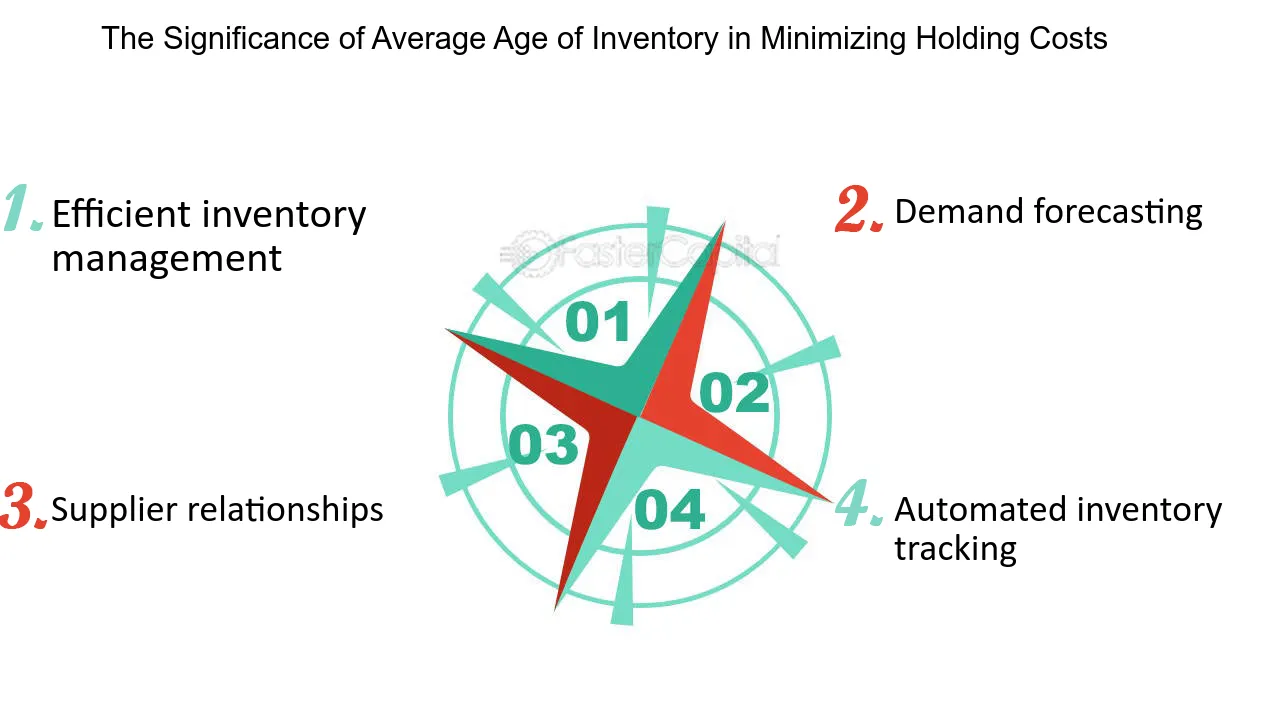
The Significance of Average Age of Inventory in Minimizing Holding Costs - First Out: Minimizing Holding Costs: Average Age of Inventory and LIFO
16. Strategies for Reducing Average Age of Inventory
One of the key challenges that businesses face in managing their inventory is the need to minimize the average age of inventory. The longer inventory sits in storage, the higher the holding costs become, resulting in increased expenses for the company. Additionally, older inventory is more likely to become obsolete or lose value, further adding to the financial burden. Therefore, it is crucial for businesses to implement effective strategies that can help reduce the average age of inventory and optimize their operations.
From a supply chain perspective, adopting a proactive approach is essential to reduce the average age of inventory. This involves closely monitoring the demand patterns and customer preferences to ensure that the right products are available at the right time. By accurately forecasting demand and aligning production and procurement activities accordingly, businesses can minimize the time it takes for inventory to move through the supply chain. This not only reduces holding costs but also improves customer satisfaction by ensuring timely product availability.
1. Implement Just-in-Time (JIT) Inventory Management: JIT is a strategy that aims to minimize inventory levels by receiving goods from suppliers just in time for production or customer demand. By reducing the buffer stock, businesses can significantly reduce the average age of inventory. For example, a car manufacturing company can work closely with its suppliers to receive components only when they are needed on the assembly line. This eliminates the need for extensive storage and reduces the risk of inventory becoming obsolete.
2. Optimize Order Quantities: Another strategy to reduce the average age of inventory is to optimize order quantities. By ordering in smaller quantities more frequently, businesses can ensure that inventory turnover is higher, resulting in fresher products and reduced holding costs. However, it is crucial to strike a balance between frequent orders and economies of scale to avoid increasing procurement costs. Advanced inventory management systems can help analyze historical data and forecast demand accurately, enabling businesses to determine the optimal order quantities.
3. Implement Effective Inventory Classification: Not all inventory items have the same level of importance or demand. By classifying inventory based on their value, demand, or criticality, businesses can prioritize their efforts to reduce the average age of inventory. For example, a retail store can categorize products as fast-moving, slow-moving, or seasonal items. By focusing on reducing the average age of slow-moving items through targeted promotions or discounts, businesses can free up valuable storage space and minimize holding costs.
4. Leverage Technology and Automation: Technology plays a vital role in optimizing inventory management and reducing the average age of inventory. Implementing inventory management software can provide real-time visibility into stock levels, demand patterns, and lead times. Automation tools can streamline order processing, reduce manual errors, and speed up the movement of inventory. For instance, an e-commerce business can integrate its inventory management system with its online store, ensuring accurate stock updates and minimizing the risk of overselling or stockouts.
5. Collaborate with Suppliers and Partners: Establishing strong relationships with suppliers and partners can significantly contribute to reducing the average age of inventory. By sharing demand forecasts, production plans, and inventory levels, businesses can work together to streamline the supply chain and reduce lead times. For example, a fashion retailer can collaborate with its suppliers to implement a vendor-managed inventory (VMI) system, where suppliers are responsible for managing inventory levels at the retailer's stores. This ensures that inventory is constantly replenished based on demand, reducing the average age of inventory and improving overall operational efficiency.
Reducing the average age of inventory is crucial for businesses to minimize holding costs and optimize their operations. By implementing strategies such as JIT inventory management, optimizing order quantities, effective inventory classification, leveraging technology, and collaborating with suppliers, businesses can ensure that inventory turnover is high, reducing the risk of obsolescence and improving their bottom line. Proactive inventory management not only saves costs but also enhances customer satisfaction, making it a critical aspect of successful supply chain management.
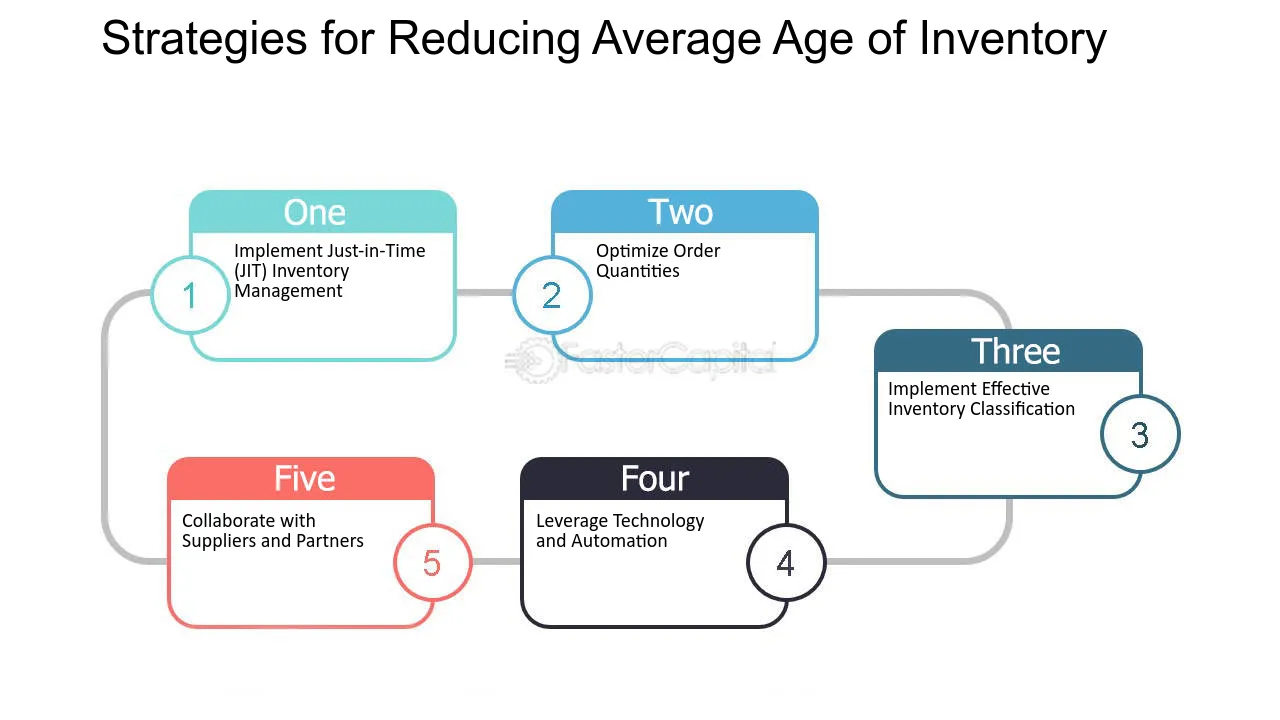
Strategies for Reducing Average Age of Inventory - Inventory holding cost: Minimizing Expenses through Average Age Reduction
17. Introduction to Inventory Turnover and Average Age of Inventory
Inventory turnover and average age of inventory are two important metrics that businesses use to manage their inventory effectively and maximize profitability. These metrics provide insights into how efficiently a company is managing its inventory and can help identify areas for improvement. In this section, we will delve into the concept of inventory turnover and average age of inventory, and explore how businesses can use these metrics to optimize their inventory management strategies.
1. Inventory turnover:
Inventory turnover, also known as stock turnover, is a measure of how quickly a company sells its inventory and replaces it with new stock. It is calculated by dividing the cost of goods sold (COGS) by the average inventory value. A high inventory turnover indicates that a company is selling its inventory quickly, while a low turnover suggests that inventory is sitting on the shelves for a longer period.
2. Importance of inventory turnover:
Understanding inventory turnover is crucial for businesses as it directly impacts their profitability. A high inventory turnover means that a company is able to generate revenue from its inventory more frequently, thus reducing the risk of obsolete or expired stock. On the other hand, a low turnover can tie up valuable capital in unsold inventory, leading to increased carrying costs and potentially reduced cash flow.
3. Factors affecting inventory turnover:
Several factors can influence a company's inventory turnover rate. These include industry trends, seasonality, demand fluctuations, and supply chain efficiency. For example, a retailer selling seasonal products like swimwear may experience higher turnover rates during the summer months but lower turnover during the rest of the year. Understanding these factors helps businesses make informed decisions about inventory management, such as adjusting procurement strategies or implementing promotional activities.
4. Average age of inventory:
While inventory turnover measures how quickly inventory is sold, the average age of inventory provides additional insights by calculating the average number of days it takes for inventory to be sold. This metric is calculated by dividing the number of days in a specific period by the inventory turnover ratio. For instance, if the inventory turnover ratio is 5, the average age of inventory would be 73 days (365 days divided by 5).
5. Significance of average age of inventory:
The average age of inventory helps businesses assess the efficiency of their inventory management practices. A lower average age indicates that inventory is being sold quickly, reducing the risk of obsolescence and minimizing carrying costs. Conversely, a higher average age suggests that inventory is staying on the shelves for a longer time, potentially tying up capital and increasing the likelihood of obsolete or expired stock.
6. Balancing inventory turnover and average age of inventory:
Achieving an ideal balance between inventory turnover and average age of inventory is crucial for maximizing profitability. While a high inventory turnover is generally desirable, it should be accompanied by a reasonable average age of inventory. For example, a company with a very high turnover but a very low average age may struggle to meet customer demand or risk stockouts. On the other hand, a company with a low turnover but a high average age may face increased carrying costs and potential obsolescence.
Understanding inventory turnover and average age of inventory is vital for effective inventory management. By analyzing these metrics, businesses can identify areas for improvement, optimize their inventory levels, and ultimately enhance profitability. By striking the right balance between inventory turnover and average age of inventory, companies can ensure that their inventory is efficiently managed, reducing costs and maximizing revenue.
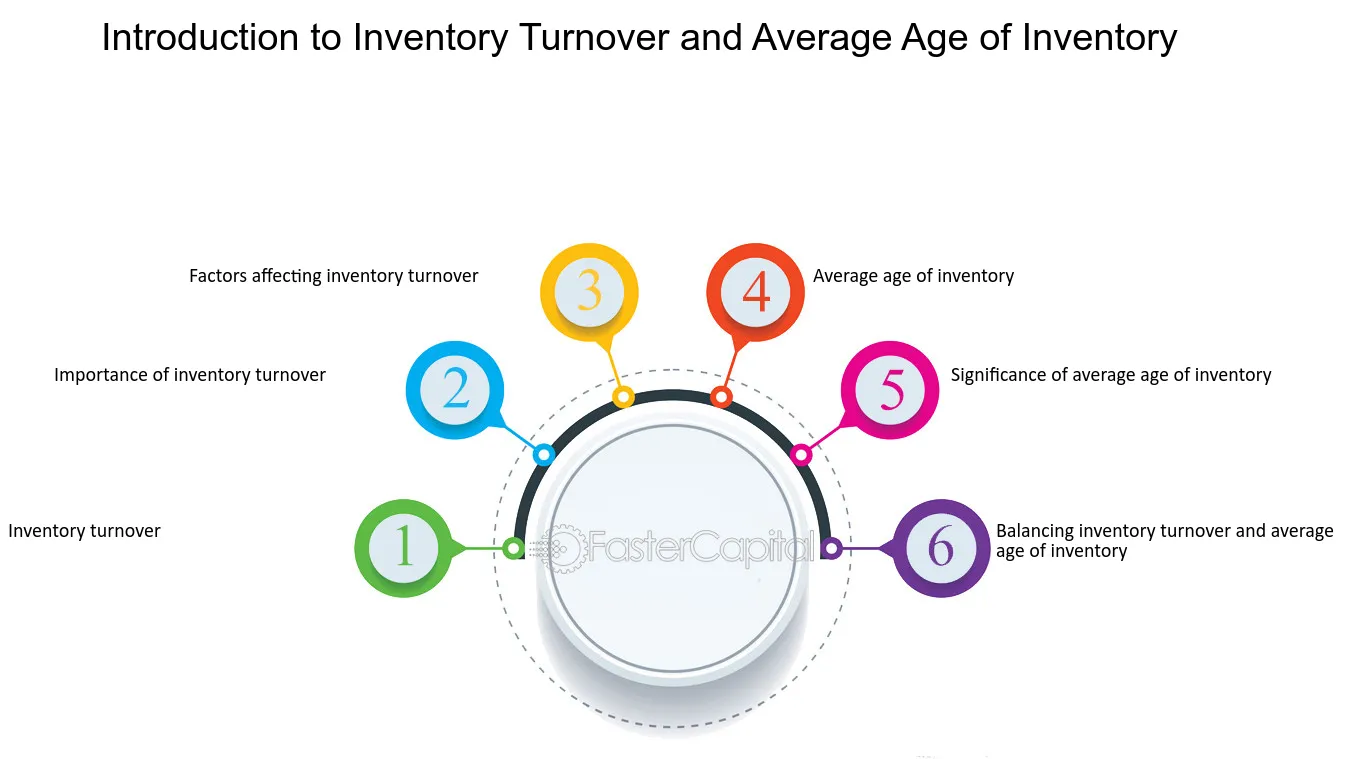
Introduction to Inventory Turnover and Average Age of Inventory - Inventory turnover: Maximizing Profitability with Average Age of Inventory
18. The Significance of Average Age of Inventory in Profitability
In the world of business, inventory turnover plays a crucial role in determining the profitability of a company. It is a measure of how efficiently a company manages its inventory and converts it into sales. While inventory turnover is an important metric to consider, it is equally important to delve deeper into the concept of average age of inventory. The average age of inventory refers to the average number of days it takes for a company to sell its entire inventory. Understanding the significance of average age of inventory can provide valuable insights into the profitability of a business.
1. optimizing Cash flow: One of the primary reasons why the average age of inventory is significant for profitability is its impact on cash flow. When inventory sits idle for a longer period, it ties up valuable capital that could be utilized elsewhere in the business. By reducing the average age of inventory, companies can free up cash flow, enabling them to invest in growth opportunities, pay off debts, or even distribute dividends.
2. minimizing Holding costs: Holding costs, also known as carrying costs, are the expenses incurred by a company to store and maintain its inventory. These costs include warehousing, insurance, utilities, and depreciation. The longer inventory remains unsold, the higher the holding costs. By reducing the average age of inventory, companies can minimize these expenses, ultimately improving profitability.
3. Reducing Obsolescence: In today's fast-paced business environment, product obsolescence is a constant challenge. As technology advances and consumer preferences change, the value of certain inventory items may diminish over time. The longer inventory sits on the shelves, the higher the risk of obsolescence. By closely monitoring the average age of inventory and taking proactive measures to sell or liquidate slow-moving items, companies can mitigate the risk of obsolescence and protect their profitability.
4. enhancing Customer satisfaction: Another significant aspect of the average age of inventory is its impact on customer satisfaction. Customers expect businesses to have readily available products, and delays in fulfilling orders can lead to dissatisfaction and lost sales. By reducing the average age of inventory and ensuring a steady supply of popular items, companies can meet customer demands promptly, fostering loyalty and repeat business.
5. Identifying Operational Inefficiencies: Analyzing the average age of inventory can provide valuable insights into the efficiency of a company's operations. A high average age of inventory may indicate issues such as poor demand forecasting, ineffective inventory management systems, or slow order processing. By identifying these inefficiencies, companies can implement corrective measures to streamline their operations, reduce costs, and improve profitability.
For instance, let's consider a retail clothing store that has a high average age of inventory due to slow sales of a particular clothing line. By closely monitoring the average age of inventory, the store manager can identify this issue and take action. They may decide to offer discounts or promotions to boost sales of the slow-moving clothing line, preventing it from becoming obsolete and potentially improving overall profitability.
The average age of inventory is a crucial metric that significantly impacts the profitability of a business. By optimizing cash flow, minimizing holding costs, reducing obsolescence, enhancing customer satisfaction, and identifying operational inefficiencies, companies can leverage this metric to make informed decisions and maximize their profitability. Understanding and actively managing the average age of inventory can help businesses thrive in today's competitive marketplace.
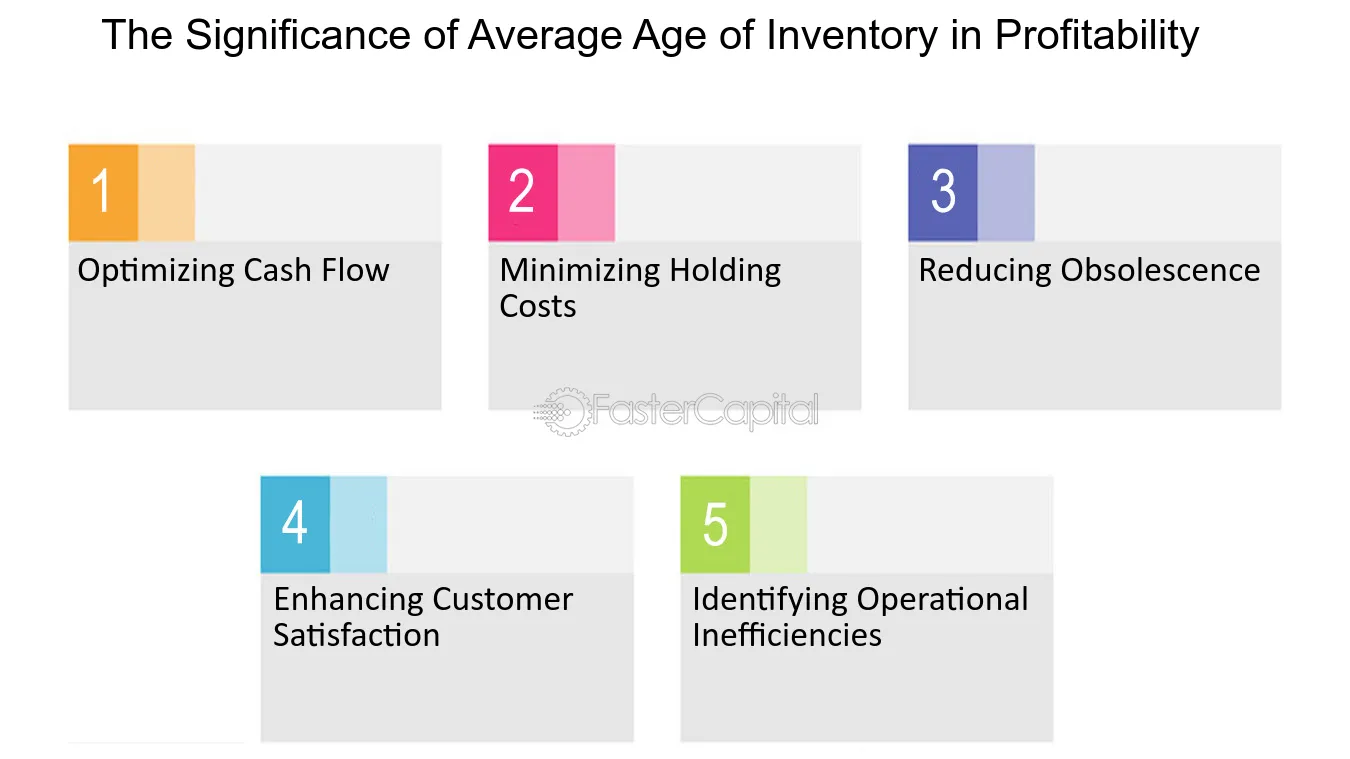
The Significance of Average Age of Inventory in Profitability - Inventory turnover: Maximizing Profitability with Average Age of Inventory
19. Identifying the Factors Affecting Average Age of Inventory
Inventory management is a crucial aspect of any business, and one key metric that helps in assessing the efficiency of inventory management is the average age of inventory. This metric provides valuable insights into how long it takes for inventory to move through the supply chain, from the time it is received to the time it is sold. By understanding the factors that affect the average age of inventory, businesses can identify areas for improvement and work towards reducing delays and optimizing their supply chain processes.
1. Demand Forecasting: Accurate demand forecasting plays a vital role in determining the average age of inventory. If a business accurately predicts customer demand, it can ensure that inventory levels are aligned with the expected sales. This helps in avoiding overstocking or understocking situations, both of which can contribute to an increase in the average age of inventory. By leveraging historical sales data, market trends, and customer insights, businesses can improve their demand forecasting accuracy and minimize inventory holding periods.
For example, a clothing retailer can analyze past sales data to identify seasonal trends and stock up accordingly. By accurately forecasting the demand for winter clothing, they can ensure that their inventory turnover remains high during the winter season, reducing the average age of inventory.
2. Lead Time: The time it takes for inventory to move through the supply chain, from the point of order placement to delivery, significantly impacts the average age of inventory. Longer lead times can result in higher inventory holding periods, as goods may spend more time in transit or in storage before reaching the end customer. Businesses should work closely with suppliers to reduce lead times wherever possible.
For instance, a manufacturing company can collaborate with its suppliers to implement just-in-time (JIT) inventory management. By receiving raw materials and components just in time for production, the company can minimize storage time and reduce the average age of inventory.
3. Order Fulfillment Process: The efficiency of the order fulfillment process directly affects the average age of inventory. If orders are processed and shipped promptly, inventory turnover will be higher, resulting in a lower average age of inventory. On the other hand, delays in order processing, picking, packing, or shipping can lead to a longer holding period for inventory.
To illustrate, an e-commerce retailer can invest in automation and streamlined processes to expedite order fulfillment. By utilizing barcode scanning technology and optimizing warehouse layout, they can reduce the time taken to process orders and decrease the average age of inventory.
4. Seasonality and Trends: Understanding seasonal demand patterns and market trends is crucial for managing inventory levels effectively. Businesses operating in industries with pronounced seasonal variations must adjust their inventory accordingly to avoid excess stock and obsolescence. By aligning inventory levels with expected demand fluctuations, businesses can minimize the average age of inventory.
For example, a toy manufacturer can analyze historical data to identify peak demand periods, such as the holiday season. By increasing production and stocking up on popular toys before the holiday rush, they can avoid stockouts and maintain a lower average age of inventory.
5. Product Shelf Life: Certain industries, such as food and beverages or cosmetics, have products with limited shelf lives. Managing inventory effectively in such industries requires close attention to expiration dates and batch rotation. By implementing first-in, first-out (FIFO) inventory management practices and closely monitoring product expiry dates, businesses can prevent excessive inventory aging and reduce the average age of inventory.
Identifying the factors that affect the average age of inventory is crucial for businesses aiming to optimize their supply chain processes. By focusing on demand forecasting, reducing lead times, improving order fulfillment processes, considering seasonal trends, and managing product shelf life, businesses can effectively reduce delays, improve inventory turnover, and ultimately enhance their overall operational efficiency.
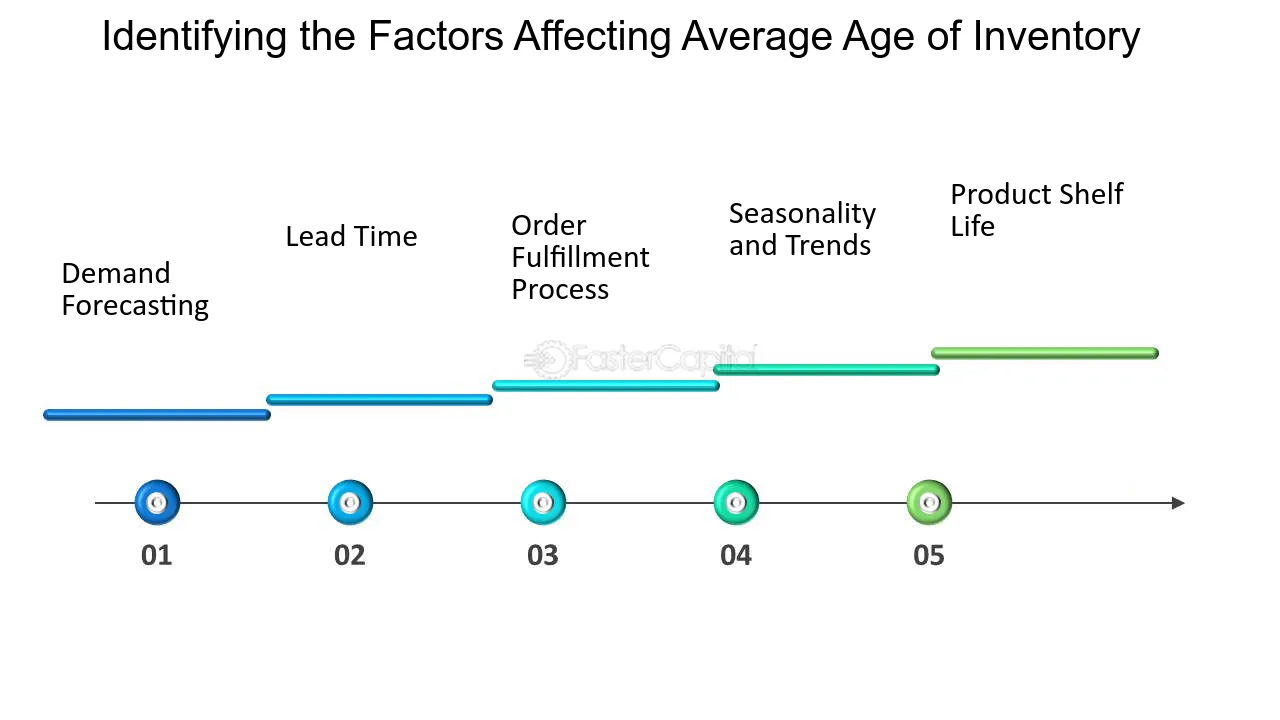
Identifying the Factors Affecting Average Age of Inventory - Lead time: Reducing Delays: Average Age of Inventory and Lead Time
20. Strategies for Reducing Average Age of Inventory and Improving Lead Time
One of the key challenges faced by businesses across industries is managing their inventory effectively. The average age of inventory, which refers to the amount of time it takes for inventory to be sold or used, is a crucial metric that can significantly impact a company's bottom line. A high average age of inventory not only ties up valuable working capital but also increases the risk of obsolescence and decreases customer satisfaction due to longer lead times. In this section, we will explore some effective strategies for reducing the average age of inventory and improving lead time, ensuring smoother operations and better customer experiences.
1. Forecasting and Demand Planning:
Accurate forecasting and demand planning are essential for minimizing inventory holding costs and reducing lead times. By analyzing historical data, market trends, and customer demand patterns, businesses can predict future demand more accurately. This allows them to optimize their inventory levels, ensuring that they have just enough stock to meet customer needs without overstocking. Implementing advanced demand planning tools and collaborating closely with sales and marketing teams can further enhance the accuracy of forecasts.
For example, a retail clothing company can utilize historical sales data and market trends to forecast demand for different product categories. By accurately predicting the demand for each item, the company can maintain optimal inventory levels and reduce the average age of inventory.
2. streamlining Supply chain Processes:
Efficient supply chain management plays a vital role in reducing lead times and improving inventory turnover. By identifying and eliminating bottlenecks, businesses can streamline their processes, ensuring faster movement of goods from suppliers to customers. This can be achieved through various strategies, such as implementing lean manufacturing principles, optimizing transportation routes, and establishing strong relationships with reliable suppliers.
For instance, a manufacturing company can adopt lean manufacturing techniques to eliminate waste and improve production efficiency. By reducing lead times within the manufacturing process, the company can respond quickly to customer orders and minimize the average age of inventory.
3. Implementing Just-in-Time (JIT) Inventory Management:
Just-in-Time (JIT) inventory management is a strategy that aims to minimize inventory levels by receiving goods from suppliers only when they are needed for production or sale. By synchronizing the delivery of raw materials or finished goods with production or customer demand, businesses can reduce lead times and keep inventory levels lean. JIT inventory management requires close coordination with suppliers and a robust system for tracking demand fluctuations accurately.
For example, an automobile manufacturer can adopt JIT inventory management to minimize inventory levels of spare parts. By receiving parts from suppliers just in time for assembly, the manufacturer can reduce the average age of inventory and respond quickly to customer orders.
4. Utilizing Technology and Automation:
Leveraging technology and automation can significantly improve inventory management and lead time reduction. Implementing an advanced inventory management system can provide real-time visibility into stock levels, demand, and lead times. This enables businesses to make data-driven decisions, optimize inventory levels, and reduce the average age of inventory. Automation can also streamline processes such as order fulfillment, reducing manual errors and improving efficiency.
For instance, an e-commerce company can implement an automated order management system that integrates with inventory data. This allows the company to track inventory levels in real-time, automatically update stock availability on the website, and trigger reorder points when stock levels are low. By automating these processes, the company can reduce lead times and improve customer satisfaction.
Reducing the average age of inventory and improving lead time are critical for businesses aiming to enhance operational efficiency and customer satisfaction. By implementing strategies such as accurate forecasting, streamlined supply chain processes, JIT inventory management, and leveraging technology and automation, companies can optimize their inventory levels, reduce lead times, and stay responsive to customer demands. Embracing these strategies will not only lead to cost savings but also strengthen competitiveness in a fast-paced business environment.
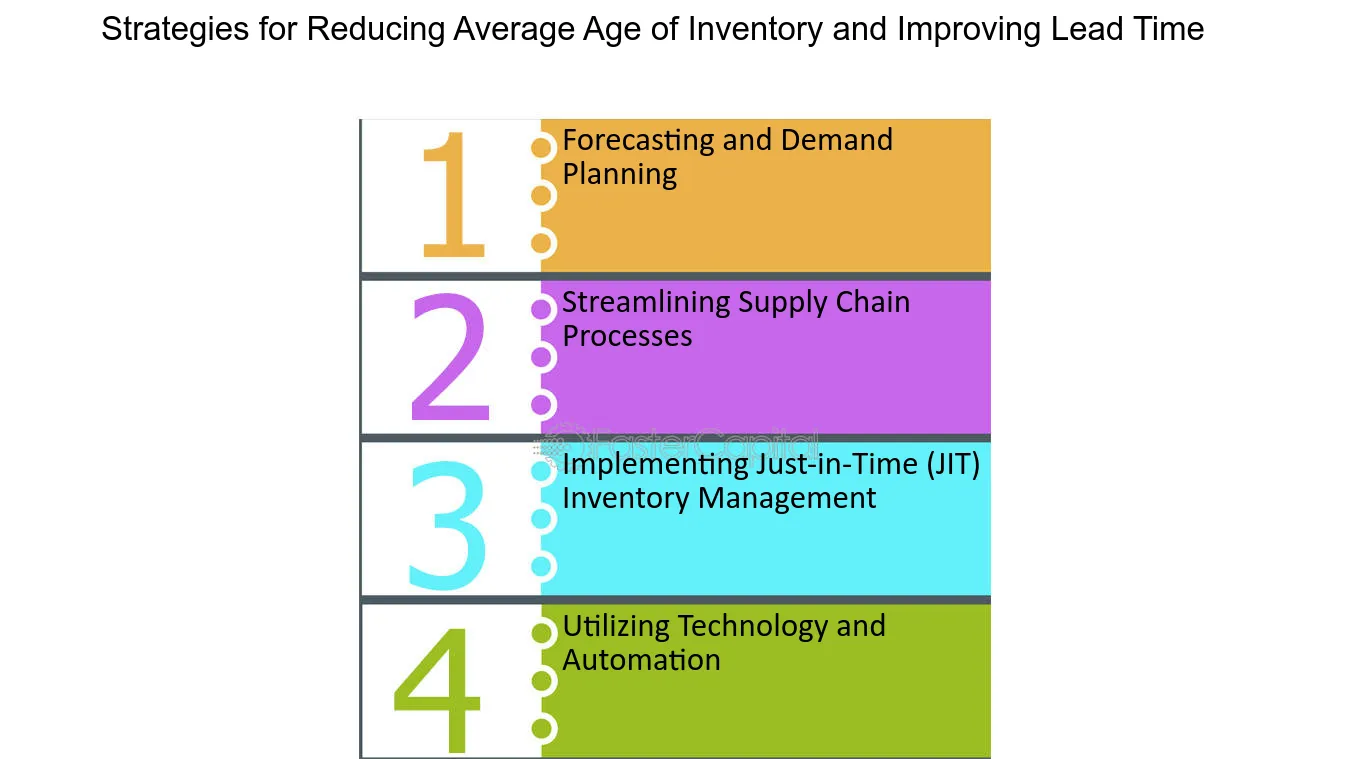
Strategies for Reducing Average Age of Inventory and Improving Lead Time - Lead time: Reducing Delays: Average Age of Inventory and Lead Time
21. Strategies for Accelerating Average Age of Inventory
In the world of supply chain management, the age of inventory is a critical metric that directly impacts a company's profitability and overall efficiency. The average age of inventory refers to the average amount of time it takes for a product to be sold from the moment it enters the inventory. A high average age of inventory can lead to increased carrying costs, obsolescence, and reduced customer satisfaction. Therefore, it is essential for businesses to implement strategies that accelerate the average age of inventory, ultimately improving their bottom line.
From a production standpoint, one effective strategy for reducing the average age of inventory is to implement just-in-time (JIT) manufacturing. JIT manufacturing focuses on producing goods only when they are needed, thereby minimizing excess inventory. By closely monitoring customer demand and adjusting production accordingly, companies can reduce lead times and keep inventory levels low. This approach not only reduces carrying costs but also minimizes the risk of inventory obsolescence. For instance, Toyota, a pioneer of JIT manufacturing, successfully reduced its average age of inventory by implementing this strategy, leading to improved efficiency and cost savings.
Another strategy that can help accelerate the average age of inventory is to optimize the supply chain by reducing lead times. Shorter lead times mean that products spend less time in transit or waiting to be processed, reducing the overall age of inventory. One way to achieve this is by collaborating closely with suppliers to streamline processes and eliminate unnecessary delays. For instance, implementing electronic data interchange (EDI) systems can automate order processing, reducing lead times and improving the speed of inventory replenishment. By actively managing the supply chain and reducing lead times, companies like Amazon have been able to maintain low average ages of inventory, ensuring timely product delivery to customers.
Furthermore, effective demand forecasting plays a crucial role in accelerating the average age of inventory. By accurately predicting customer demand, companies can align their production and inventory levels accordingly. This prevents overstocking or understocking, reducing the average age of inventory. Advanced analytics and machine learning algorithms can be employed to analyze historical sales data, market trends, and other relevant factors to generate accurate demand forecasts. For example, retail giant Walmart utilizes sophisticated demand forecasting models to optimize its inventory levels, resulting in a low average age of inventory and improved profitability.
Implementing efficient inventory management techniques can also contribute to accelerating the average age of inventory. One such technique is the adoption of ABC analysis, which categorizes inventory items based on their value and demand. By focusing on the high-value and high-demand items, companies can prioritize their inventory management efforts and ensure timely replenishment. Additionally, implementing a robust inventory tracking system, such as barcode or RFID technology, enables real-time visibility of inventory levels and reduces the risk of stockouts. By effectively managing inventory, companies can reduce the average age of inventory and improve customer satisfaction.
Accelerating the average age of inventory is a vital goal for businesses seeking to optimize their supply chain and improve profitability. Strategies such as implementing JIT manufacturing, reducing lead times, accurate demand forecasting, and efficient inventory management techniques can significantly contribute to this objective. By adopting these strategies and continuously evaluating and refining their supply chain processes, companies can successfully reduce their average age of inventory, leading to increased efficiency, cost savings, and ultimately, a competitive edge in the market.
Raising capital can be a struggle!
With FasterCapital's team's help, you get your startup funded successfully and quickly!
22. Success Stories in Accelerating Average Age of Inventory
In our quest to reduce lead time and accelerate the average age of inventory, we turn to case studies that showcase success stories in various industries. By examining real-life examples, we gain valuable insights into the strategies and tactics employed by companies to improve their inventory turnover rates and achieve remarkable results. These case studies highlight the importance of streamlining processes, optimizing supply chains, and embracing innovative technologies to drive efficiency and profitability. Let's delve into these success stories and uncover the key takeaways that can inspire and guide us on our own journey towards inventory optimization.
1. Case Study: Toyota Motor Corporation
Toyota, renowned for its lean manufacturing principles, provides an excellent example of how reducing lead time can significantly impact inventory turnover. By implementing the Toyota Production System (TPS), the company achieved a remarkable decrease in its average age of inventory. One key aspect of TPS is just-in-time (JIT) production, which aims to deliver parts and components to the assembly line precisely when they are needed. This approach eliminates excess inventory and reduces the risk of obsolescence. As a result, Toyota has been able to maintain a low average age of inventory, ensuring that vehicles are produced and delivered to customers in a timely manner.
2. Case Study: Zara
Zara, a fast-fashion retailer, has revolutionized the fashion industry with its agile supply chain and rapid product turnover. The company's success lies in its ability to quickly respond to changing fashion trends and deliver new designs to stores within weeks. Zara achieves this by maintaining close relationships with suppliers and manufacturers, enabling them to produce small batches of clothing and replenish stock frequently. By reducing lead time and accelerating the average age of inventory, Zara ensures that its stores always offer the latest styles, attracting fashion-conscious customers who value up-to-the-minute trends.
3. Case Study: Amazon
As an e-commerce giant, Amazon relies on efficient inventory management to meet customer demands and maintain its competitive edge. The company employs advanced forecasting algorithms and real-time data analytics to optimize its inventory levels and reduce lead time. Amazon's success in accelerating the average age of inventory can be attributed to its extensive network of fulfillment centers strategically located near major markets. By strategically positioning inventory, Amazon can fulfill customer orders promptly, reducing wait times and enhancing customer satisfaction.
4. Case Study: Apple Inc.
Apple's success in accelerating the average age of inventory can be attributed to its meticulous supply chain management and product innovation. The company effectively manages its inventory by closely collaborating with suppliers and maintaining a just-in-time inventory model. Apple's ability to accurately forecast demand and rapidly introduce new products helps prevent excess inventory buildup and ensures a steady flow of fresh merchandise. By reducing lead time and closely monitoring inventory levels, Apple consistently delivers cutting-edge technology to its customers, keeping them engaged and satisfied.
These case studies highlight the significance of reducing lead time and accelerating the average age of inventory in various industries. From automotive manufacturing to fashion retail and e-commerce, companies that prioritize inventory optimization reap the rewards of improved efficiency, reduced costs, and enhanced customer satisfaction. By adopting strategies such as just-in-time production, agile supply chains, and advanced data analytics, businesses can effectively manage their inventory and stay ahead in today's competitive market. Let these success stories inspire us to take proactive steps towards accelerating the average age of inventory and unlocking the potential for greater success in our own organizations.
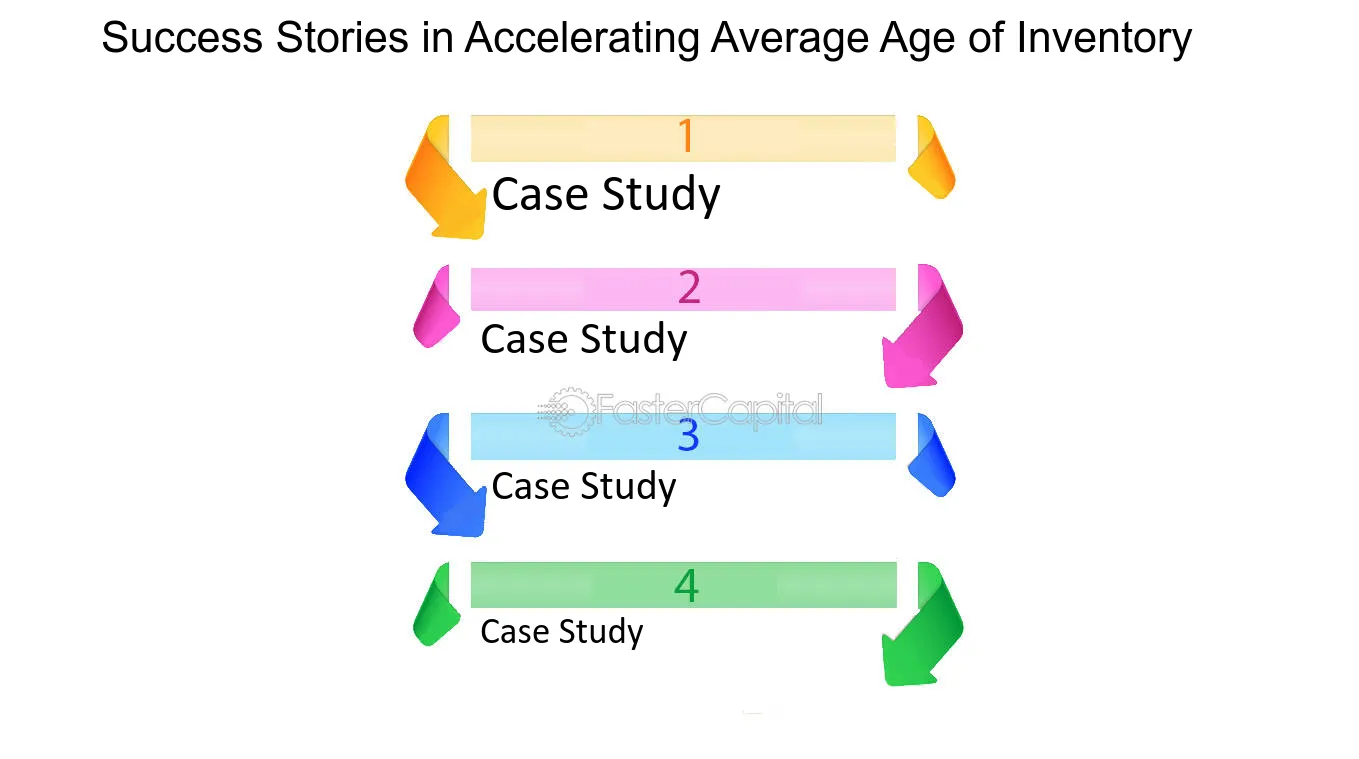
Success Stories in Accelerating Average Age of Inventory - Lead time reduction: Accelerating Average Age of Inventory
23. The Importance of Tracking and Managing Average Age of Inventory
In today's fast-paced business environment, it is crucial for companies to stay ahead of the curve and constantly evaluate their inventory management practices. One key metric that can provide valuable insights into the efficiency of inventory management is the average age of inventory. This metric helps businesses understand how long their products have been sitting in the warehouse, and can be a powerful tool in preventing losses due to obsolescence.
1. Identifying Slow-Moving Products: Tracking the average age of inventory allows businesses to identify slow-moving products that may be at risk of becoming obsolete. By analyzing this metric, companies can determine which products are taking longer to sell and take proactive measures to prevent obsolescence. For example, if a product's average age of inventory is significantly higher than the industry average, it may be an indication that demand for that product is declining. Armed with this knowledge, businesses can adjust their inventory levels accordingly, avoiding unnecessary costs associated with holding onto slow-moving items.
2. Forecasting Demand: The average age of inventory can also be used as a forecasting tool to predict future demand. By analyzing historical data and trends, businesses can gain valuable insights into consumer behavior and adjust their inventory levels accordingly. For instance, if the average age of inventory for a particular product is consistently decreasing, it may indicate a surge in demand. This information can help businesses make informed decisions about inventory replenishment, ensuring that they have enough stock to meet customer demand without incurring excessive carrying costs.
3. optimizing Inventory turnover: efficient inventory management is all about finding the right balance between having enough stock to meet customer demand and minimizing carrying costs. The average age of inventory plays a crucial role in optimizing inventory turnover. By closely monitoring this metric, businesses can identify bottlenecks in their supply chain and take corrective actions. For instance, if the average age of inventory is increasing, it may indicate issues with procurement or distribution processes that need to be addressed. By streamlining these processes, businesses can improve inventory turnover, reduce carrying costs, and ultimately increase profitability.
4. Minimizing Obsolescence Costs: Obsolete inventory can be a significant drain on a company's resources. By tracking and managing the average age of inventory, businesses can minimize obsolescence costs. For instance, if a product's average age of inventory exceeds a certain threshold, it may be a signal to implement promotional strategies to accelerate sales and prevent obsolescence. Alternatively, if a product is consistently showing a high average age of inventory, it may be time to consider liquidation or other strategies to minimize losses. By actively managing the average age of inventory, businesses can reduce the financial impact of obsolescence and improve their overall profitability.
Tracking and managing the average age of inventory is vital for businesses looking to prevent losses due to obsolescence. This metric provides valuable insights into the efficiency of inventory management, helps identify slow-moving products, forecasts demand, optimizes inventory turnover, and minimizes obsolescence costs. By leveraging this information, businesses can make informed decisions about their inventory levels, mitigate risks, and ultimately improve their bottom line.
The Importance of Tracking and Managing Average Age of Inventory - Obsolescence: Preventing Losses: Average Age of Inventory and Obsolescence
24. Importance of Calculating Average Age of Inventory Arrival
The importance of calculating the average age of inventory arrival cannot be overstated in the realm of purchase order lead time management. This metric provides valuable insights into the efficiency of a company's supply chain, helping businesses make informed decisions regarding inventory management, production planning, and customer satisfaction. By understanding the average age of inventory arrival, companies can identify bottlenecks, optimize their procurement processes, and ensure timely delivery of goods to meet customer demands.
1. Identifying Bottlenecks: Calculating the average age of inventory arrival allows businesses to pinpoint bottlenecks in their supply chain. For example, if the average age of inventory arrival is consistently higher than the expected lead time, it may indicate delays in the procurement process or issues with suppliers. By identifying these bottlenecks, companies can take proactive measures to address them, such as finding alternative suppliers or streamlining internal processes.
2. optimizing Inventory management: The average age of inventory arrival provides valuable information for optimizing inventory management. By comparing the average age with the desired lead time, businesses can determine whether they have excessive or insufficient inventory levels. For instance, if the average age of inventory arrival is significantly higher than the lead time, it may indicate an excess of inventory, leading to increased carrying costs and potential obsolescence. On the other hand, if the average age is consistently lower than the lead time, it may suggest inadequate stock levels, potentially resulting in stockouts and dissatisfied customers. By calculating and monitoring the average age of inventory arrival, companies can strike a balance between carrying costs and customer service levels.
3. enhancing Production planning: The average age of inventory arrival also plays a crucial role in production planning. By understanding the average lead time for procuring raw materials or components, businesses can align their production schedules accordingly. For instance, if the average age of inventory arrival is longer than expected, companies can adjust their production plans to account for these delays, preventing production disruptions and ensuring timely delivery to customers. Conversely, if the average age is shorter than anticipated, businesses can capitalize on this efficiency by optimizing production schedules and potentially reducing inventory holding costs.
4. Meeting Customer Demands: Ultimately, calculating the average age of inventory arrival is essential for meeting customer demands and maintaining high levels of customer satisfaction. Customers today have high expectations when it comes to product availability and delivery times. By accurately estimating the average age of inventory arrival, companies can ensure that they have the right products in stock when customers need them. This not only enhances customer satisfaction but also improves the company's reputation and competitive advantage in the market.
To illustrate the importance of calculating the average age of inventory arrival, let's consider an example. Imagine a retail company that sells electronic gadgets. The company relies on a global network of suppliers to procure the necessary components for manufacturing its products. By calculating the average age of inventory arrival, the company realizes that the lead time for a critical component is consistently longer than expected, resulting in delays in production and delivery. Armed with this insight, the company decides to diversify its supplier base, engaging with additional suppliers who can provide the component more efficiently. As a result, the average age of inventory arrival decreases, production schedules are better aligned, and customers receive their orders in a timelier manner, leading to increased customer satisfaction and improved business performance.
Calculating the average age of inventory arrival is a vital step in purchase order lead time management. This metric enables businesses to identify bottlenecks, optimize inventory management, enhance production planning, and meet customer demands. By leveraging this information, companies can streamline their supply chain processes, improve operational efficiency, and ultimately achieve a competitive edge in the market.

Importance of Calculating Average Age of Inventory Arrival - Purchase order lead time: Calculating Average Age of Inventory Arrival
25. Methods for Calculating Average Age of Inventory Arrival
When it comes to managing inventory, one of the key metrics that businesses need to track is the average age of inventory arrival. This metric helps businesses understand how quickly new inventory is being received and how long it takes for items to move through the supply chain. By calculating the average age of inventory arrival, businesses can make informed decisions about purchasing, production, and distribution to ensure optimal inventory levels and minimize stockouts.
There are several methods that businesses can use to calculate the average age of inventory arrival. Each method has its own advantages and considerations, and the choice of method may depend on the specific needs and characteristics of the business. Let's explore some of the commonly used methods in more detail:
1. First In, First Out (FIFO) Method:
The FIFO method assumes that the first items received into inventory are also the first ones to be sold or used. To calculate the average age of inventory arrival using this method, businesses can take the sum of the age of each item in inventory and divide it by the total number of items. For example, if a business received 100 units of a product 10 days ago and 200 units 5 days ago, the average age of inventory arrival would be (10010 + 2005) / (100 + 200) = 6.67 days.
2. Weighted Average Method:
The weighted average method takes into account both the quantity and age of each item in inventory. It assigns a weight to each item based on its quantity, and then calculates the average age by summing the weighted ages and dividing by the total quantity. For instance, if a business received 200 units of a product 10 days ago and 300 units 5 days ago, the average age of inventory arrival would be (20010 + 3005) / (200 + 300) = 6.67 days.
3. Moving Average Method:
The moving average method calculates the average age of inventory arrival based on a rolling average of recent arrivals. This method is particularly useful when there are frequent fluctuations in inventory levels. To calculate the moving average, businesses can take the sum of the ages of the most recent arrivals and divide it by the number of arrivals. For example, if a business received 100 units of a product 10 days ago, 200 units 5 days ago, and 50 units 2 days ago, the average age of inventory arrival would be (10010 + 2005 + 50*2) / (100 + 200 + 50) = 5.56 days.
4. Exponential Smoothing Method:
The exponential smoothing method assigns exponentially decreasing weights to past inventory arrivals, giving more importance to recent arrivals. This method helps businesses capture the trend of inventory arrival over time. The formula for calculating the average age of inventory arrival using exponential smoothing involves multiplying the age of each arrival by a smoothing factor, summing the weighted ages, and dividing by the sum of the smoothing factors. For instance, if a business received 100 units of a product 10 days ago, 200 units 5 days ago, and 50 units 2 days ago, with a smoothing factor of 0.5, the average age of inventory arrival would be (100100.5 + 20050.5 + 5020.5) / (100.5 + 50.5 + 2*0.5) = 5.83 days.
5. days of Inventory On hand (DIOH) Method:
The DIOH method calculates the average age of inventory arrival based on the number of days it would take to deplete the current inventory. By dividing the number of units in inventory by the average daily usage rate, businesses can estimate the average age of inventory arrival. For example, if a business has 500 units in inventory and the average daily usage rate is 100 units, the average age of inventory arrival would be 500 / 100 = 5 days.
Calculating the average age of inventory arrival is crucial for effective inventory management. By using methods such as FIFO, weighted average, moving average, exponential smoothing, or DIOH, businesses can gain valuable insights into the efficiency of their supply chain and make data-driven decisions to optimize inventory levels. Each method offers a different perspective on inventory age, allowing businesses to choose the most suitable approach based on their specific requirements and operational characteristics.
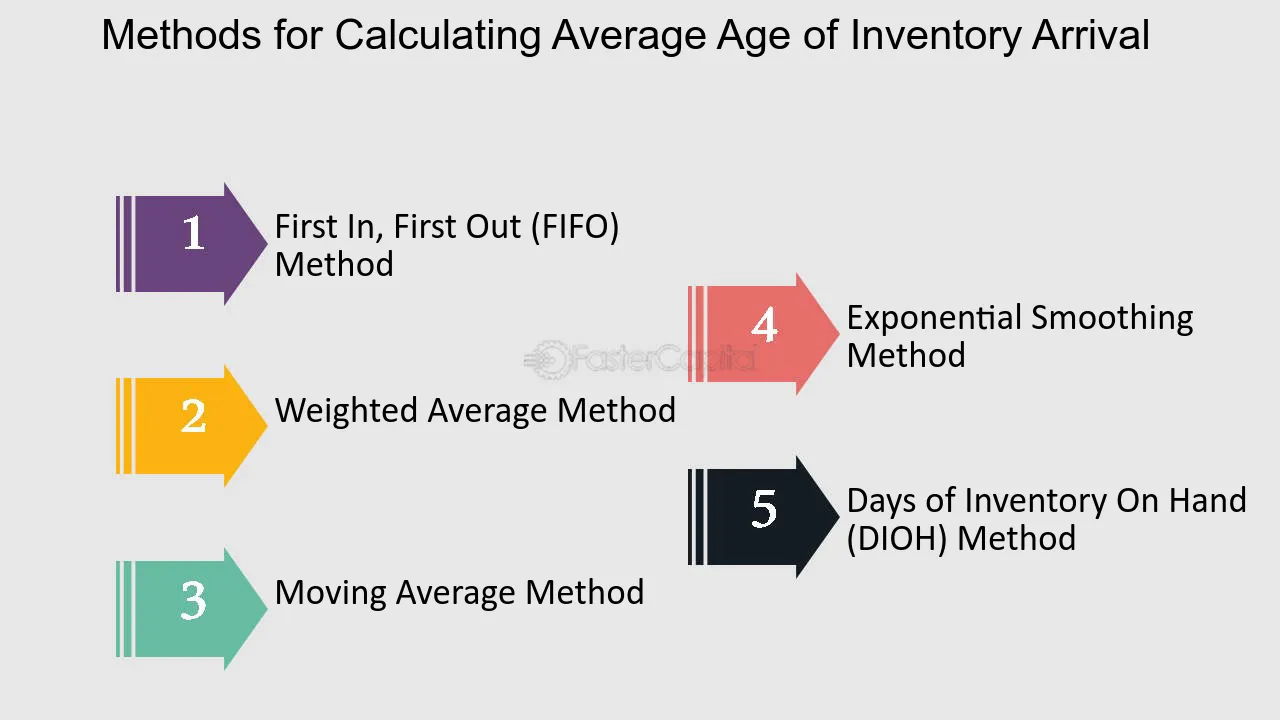
Methods for Calculating Average Age of Inventory Arrival - Purchase order lead time: Calculating Average Age of Inventory Arrival
26. Using Historical Data to Determine Average Age of Inventory Arrival
One of the key factors in managing inventory effectively is understanding the average age of inventory arrival. This metric provides valuable insights into how long it takes for inventory to arrive after a purchase order is placed. By analyzing historical data, businesses can gain a deeper understanding of their supply chain performance and make informed decisions to optimize inventory management.
1. Gather Historical Data: The first step in determining the average age of inventory arrival is to gather relevant historical data. This includes information on the date when purchase orders were placed and the actual date when the inventory arrived. It is important to collect data for a significant period of time to ensure accuracy and account for any seasonal variations.
2. Calculate Lead Time: Once the historical data is collected, it is necessary to calculate the lead time for each purchase order. Lead time is the duration between the placement of a purchase order and the actual arrival of the inventory. This can be calculated by subtracting the order placement date from the arrival date.
For example, if a purchase order was placed on January 1st and the inventory arrived on January 10th, the lead time would be 9 days.
3. Determine Average Lead Time: After calculating the lead time for each purchase order, the next step is to determine the average lead time. This can be done by summing all the lead times and dividing it by the total number of purchase orders.
For instance, if there were 10 purchase orders with lead times of 9, 12, 7, 10, 11, 8, 9, 10, 13, and 6 days, the average lead time would be (9+12+7+10+11+8+9+10+13+6)/10 = 9.5 days.
4. Analyze the Results: Once the average lead time is calculated, it is essential to analyze the results to gain insights into the inventory management process. A shorter lead time indicates a more efficient supply chain, while a longer lead time may suggest potential bottlenecks or delays. By comparing the average lead time with industry benchmarks or internal targets, businesses can identify areas for improvement and take appropriate actions.
5. Identify Trends and Patterns: In addition to calculating the average lead time, analyzing historical data can help identify trends and patterns in inventory arrival. For instance, businesses may observe seasonal variations where lead times are longer during peak periods or shorter during off-peak seasons. This information can be used to adjust inventory levels and plan for future demand fluctuations.
6. Continuous Monitoring and Improvement: Determining the average age of inventory arrival is not a one-time task. It is crucial to continuously monitor and measure this metric to identify any changes or deviations over time. By regularly analyzing historical data and comparing it with previous periods, businesses can track their performance and implement continuous improvement initiatives to enhance supply chain efficiency.
Using historical data to determine the average age of inventory arrival is a valuable tool for effective inventory management. By calculating lead times, analyzing the results, and identifying trends, businesses can optimize their supply chain processes, reduce stockouts, and improve customer satisfaction. Regular monitoring and improvement ensure that businesses stay agile and responsive in a dynamic marketplace.
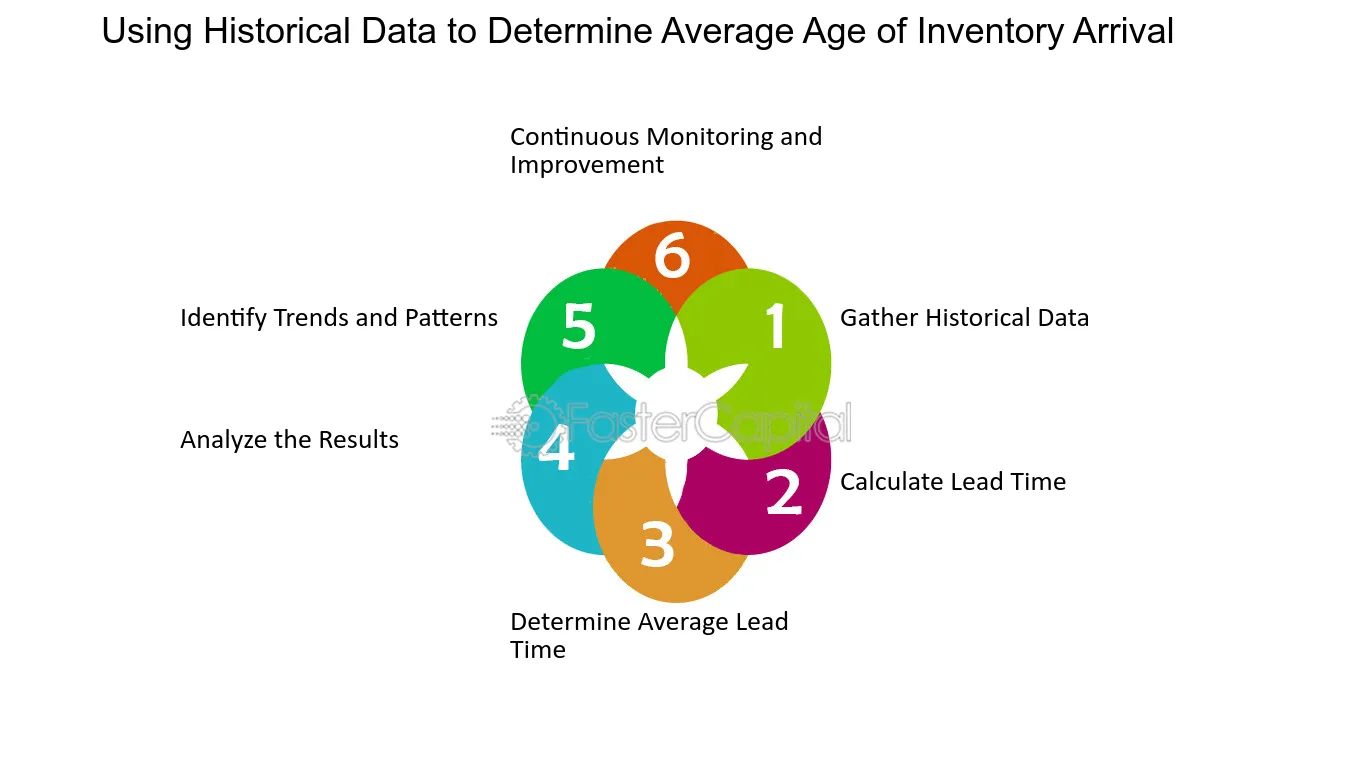
Using Historical Data to Determine Average Age of Inventory Arrival - Purchase order lead time: Calculating Average Age of Inventory Arrival
27. Benefits of Monitoring Average Age of Inventory Arrival
One crucial aspect of managing inventory efficiently is monitoring the average age of inventory arrival. This metric provides valuable insights into the timeliness of inventory replenishment and helps businesses optimize their supply chain processes. By calculating the average age of inventory arrival, companies can identify potential bottlenecks, reduce stockouts, and ensure a consistent flow of products to meet customer demand. In this section, we will explore the benefits of monitoring the average age of inventory arrival from various perspectives.
1. Improved Demand Planning: Monitoring the average age of inventory arrival allows businesses to better forecast their inventory needs. By analyzing historical data, companies can identify patterns and trends in the time it takes for inventory to arrive after placing a purchase order. This information enables more accurate demand planning, ensuring that stock levels are replenished in a timely manner to meet customer demand. For example, a clothing retailer may notice that it takes longer for certain items to arrive during peak seasons, prompting them to place orders well in advance to avoid stockouts.
2. Reduced Holding Costs: Holding costs, including warehousing, insurance, and depreciation, can significantly impact a company's bottom line. Monitoring the average age of inventory arrival helps businesses identify inefficiencies in their supply chain that lead to excessive holding costs. By reducing the time it takes for inventory to arrive, companies can minimize the amount of capital tied up in storage and reduce associated expenses. For instance, a manufacturer may discover that long lead times from a particular supplier result in excessive holding costs, prompting them to explore alternative sourcing options or negotiate shorter lead times.
3. Minimized Stockouts: Stockouts can result in lost sales, dissatisfied customers, and damage to a company's reputation. Monitoring the average age of inventory arrival helps businesses identify potential stockout risks and take proactive measures to prevent them. By analyzing the time it takes for inventory to arrive, companies can adjust their reorder points and lead times to ensure that stock is replenished before it runs out. For example, an online retailer may notice that certain products consistently take longer to arrive, prompting them to maintain higher safety stock levels or find alternative suppliers to mitigate the risk of stockouts.
4. Streamlined Supply Chain: efficient supply chain management is crucial for businesses to remain competitive in today's fast-paced market. Monitoring the average age of inventory arrival provides insights into potential bottlenecks and areas for improvement in the supply chain. By identifying delays or inefficiencies, companies can take corrective actions to streamline their procurement processes, reduce lead times, and enhance overall operational efficiency. For instance, a distributor may discover that an internal paperwork approval process is causing delays in order processing, prompting them to implement automated systems for faster approval and reduced lead times.
5. Enhanced Customer Satisfaction: Timely delivery of products is essential for customer satisfaction. Monitoring the average age of inventory arrival helps businesses ensure that orders are fulfilled promptly and accurately. By reducing lead times and improving inventory replenishment processes, companies can meet customer expectations and provide a positive buying experience. For example, an e-commerce company that consistently delivers orders within a short timeframe can build a reputation for reliability and attract repeat customers.
Monitoring the average age of inventory arrival offers numerous benefits for businesses. From improved demand planning and reduced holding costs to minimized stockouts and streamlined supply chain processes, this metric provides valuable insights to optimize inventory management. By leveraging historical data and analyzing timeframes for inventory replenishment, companies can make informed decisions, enhance operational efficiency, and ultimately deliver better customer experiences.

Benefits of Monitoring Average Age of Inventory Arrival - Purchase order lead time: Calculating Average Age of Inventory Arrival
28. Tools and Software for Tracking Average Age of Inventory Arrival
When it comes to managing inventory, one crucial aspect that businesses need to keep track of is the average age of inventory arrival. Understanding how long it takes for inventory to arrive after a purchase order is placed can help businesses optimize their supply chain, reduce carrying costs, and improve overall efficiency. To effectively track the average age of inventory arrival, businesses can utilize a variety of tools and software solutions that provide real-time data and insights. In this section, we will explore some of the tools and software available for tracking the average age of inventory arrival and how they can benefit businesses.
1. Inventory Management Systems:
Inventory management systems are essential tools for tracking and managing inventory. These systems typically offer features that allow businesses to monitor the status of purchase orders, including estimated arrival dates and actual delivery dates. By inputting the purchase order lead time for each item, businesses can easily calculate the average age of inventory arrival. Some popular inventory management systems include TradeGecko, Fishbowl, and Zoho Inventory.
2. Supply Chain Management Software:
Supply chain management software provides end-to-end visibility into the supply chain process, enabling businesses to track the progress of purchase orders from the time they are placed to when they are received. These software solutions often include features such as order tracking, shipment monitoring, and delivery notifications. By leveraging such software, businesses can accurately measure the average age of inventory arrival and identify any bottlenecks or delays in the supply chain. Examples of popular supply chain management software include SAP SCM, Oracle SCM Cloud, and JDA Software.
Data analytics tools can play a crucial role in tracking the average age of inventory arrival by providing businesses with detailed insights and trends. These tools can analyze historical data to identify patterns, forecast future inventory arrival times, and calculate average lead times. By leveraging data analytics tools, businesses can make data-driven decisions to optimize inventory levels and improve overall supply chain efficiency. Examples of data analytics tools that can be used for this purpose include Tableau, Microsoft Power BI, and Google Analytics.
4. ERP Systems:
Enterprise Resource Planning (ERP) systems integrate various business functions, including inventory management, purchasing, and supply chain management. These systems offer comprehensive features that enable businesses to track purchase orders, monitor inventory levels, and calculate lead times. By utilizing ERP systems, businesses can have a centralized platform for managing all aspects of inventory, ensuring accurate tracking and calculation of the average age of inventory arrival. Popular ERP systems include SAP ERP, Oracle ERP Cloud, and Microsoft Dynamics 365.
Tracking the average age of inventory arrival is crucial for businesses to effectively manage their inventory and optimize their supply chain operations. With the help of tools and software solutions such as inventory management systems, supply chain management software, data analytics tools, and ERP systems, businesses can gain valuable insights and real-time data to accurately calculate the average age of inventory arrival. By leveraging these tools, businesses can make informed decisions to improve efficiency, reduce costs, and ultimately enhance customer satisfaction.
Tools and Software for Tracking Average Age of Inventory Arrival - Purchase order lead time: Calculating Average Age of Inventory Arrival
29. Understanding the Concept of Average Age in Inventory Management
In the world of inventory management, one key metric that is often used to evaluate the efficiency and effectiveness of a company's inventory management practices is the average age of inventory. This metric refers to the average number of days that an item stays in stock before being sold or used. Understanding the concept of average age in inventory management is crucial for businesses as it can provide valuable insights into the health of their inventory levels and help them make informed decisions regarding reorder points and replenishment strategies.
1. Definition and Calculation of Average Age:
The average age of inventory is calculated by dividing the total number of days that items stay in stock by the total number of items sold or used during a specific period. For example, if a company has 100 units of a particular item in stock and sells 10 units per day, the average age of inventory would be 10 days. This metric provides a measure of how quickly items are being utilized or sold, allowing businesses to assess the efficiency of their inventory turnover.
2. Importance of Average Age in Inventory Management:
The average age of inventory is a critical metric for businesses as it directly impacts their bottom line. A high average age suggests that items are sitting in stock for extended periods, tying up capital and increasing the risk of obsolescence or spoilage. On the other hand, a low average age indicates a fast-moving inventory, reducing the risk of holding excess stock and improving cash flow. By monitoring and managing the average age of inventory, businesses can optimize their inventory levels, minimize carrying costs, and improve overall profitability.
3. Factors Influencing Average Age:
Several factors can influence the average age of inventory, and understanding these factors is essential for effective inventory management. These factors include demand variability, lead time, order quantity, and the accuracy of demand forecasting. For instance, if demand for a particular item is highly volatile, the average age of inventory may be higher as businesses struggle to match supply with fluctuating customer demands. Similarly, longer lead times or large order quantities can result in higher average ages as items spend more time in stock before being sold.
4. Strategies to Optimize Average Age:
To optimize the average age of inventory, businesses can implement various strategies tailored to their specific needs and industry. These strategies include:
- Implementing Just-in-Time (JIT) inventory management: JIT aims to minimize inventory levels by ordering and receiving stock only when it is needed for production or sale. By synchronizing supply with demand, businesses can reduce the average age of inventory and minimize holding costs.
- improving demand forecasting accuracy: accurate demand forecasting enables businesses to align their inventory levels with expected customer demands, reducing the risk of overstocking or stockouts. By incorporating historical sales data, market trends, and customer insights, businesses can enhance their forecasting accuracy and optimize the average age of inventory.
- Setting appropriate reorder points: Reorder points are predetermined inventory levels at which businesses should place new orders to avoid stockouts. By setting reorder points based on historical sales data, lead times, and desired service levels, businesses can ensure timely replenishment and minimize the average age of inventory.
Understanding the concept of average age in inventory management is crucial for businesses aiming to optimize their inventory levels and improve overall profitability. By monitoring and managing the average age of inventory, businesses can identify areas for improvement, implement effective strategies, and achieve a healthy balance between stock availability and holding costs.
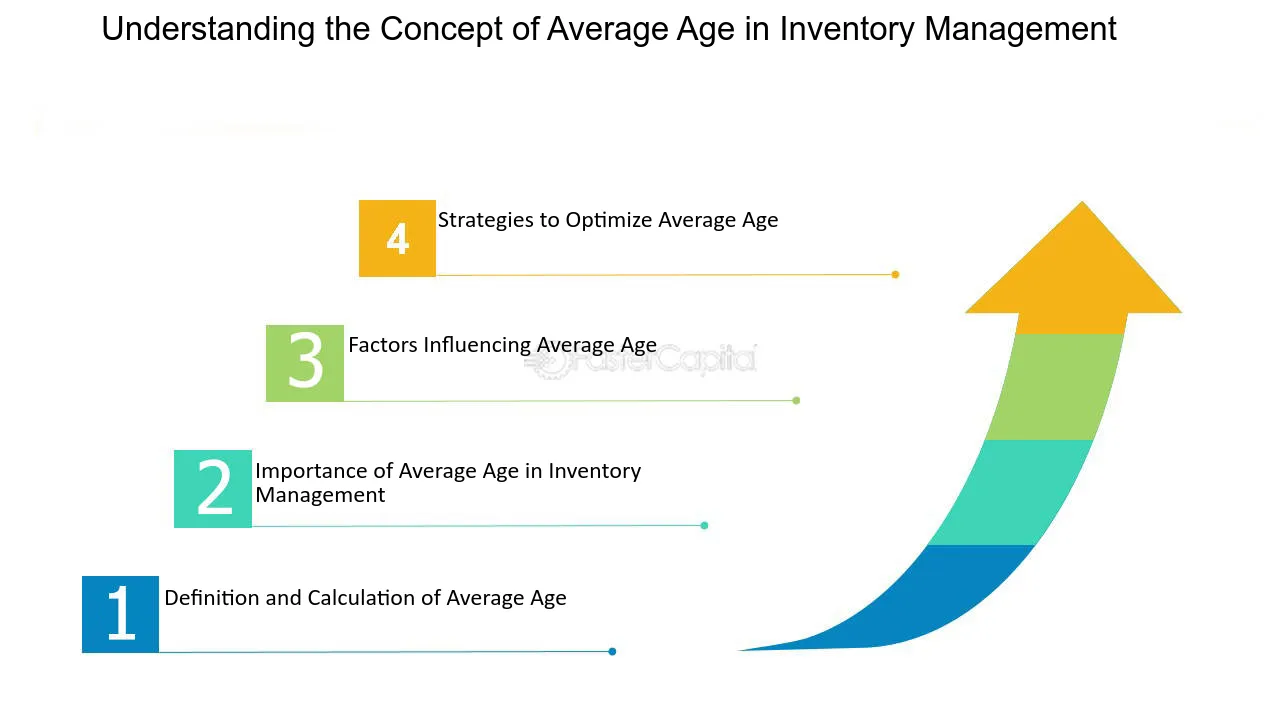
Understanding the Concept of Average Age in Inventory Management - Reorder point: Managing Inventory Levels for Optimal Average Age
30. Strategies to Minimize Average Age of Inventory
In the world of inventory management, one of the critical metrics that businesses strive to optimize is the average age of inventory. This metric represents the average amount of time that a product spends in storage before being sold, and it holds a direct impact on a company's profitability, cash flow, and overall operational efficiency. A high average age of inventory can tie up capital, increase carrying costs, and lead to obsolescence, while a low average age of inventory indicates a well-oiled supply chain and responsiveness to customer demands. In this section, we will explore various strategies to minimize the average age of inventory, offering insights from different perspectives, practical examples, and actionable tips.
1. Demand forecasting and Data analytics:
- Accurate demand forecasting is the foundation for inventory management. By leveraging data analytics, businesses can better predict consumer demand, allowing for more precise stock levels and reducing the chances of overstocking. This prevents products from aging on the shelves.
2. Lean Inventory Practices:
- Implementing lean inventory principles, such as Just-In-Time (JIT) or Kanban systems, can help minimize excess inventory. By replenishing stock only when needed, companies can reduce the average age of inventory and lower carrying costs. Toyota's JIT manufacturing system is a classic example of this approach.
3. ABC Analysis:
- Utilizing the ABC analysis method categorizes inventory into three classes: A (high-value items), B (medium-value items), and C (low-value items). By focusing on class A items and optimizing their stocking levels, businesses can free up cash and reduce the age of their most valuable inventory.
4. Safety Stock Optimization:
- Maintaining safety stock is essential to prevent stockouts, but overdoing it can increase the average age of inventory. By carefully assessing the optimal safety stock levels based on historical data and lead times, companies can find the right balance between service levels and inventory turnover.
5. Supplier Collaboration:
- Collaboration with suppliers can lead to better lead times and reduced transit times. This results in fresher products arriving in the warehouse, reducing the average age of inventory. For example, Zara, a fast-fashion retailer, collaborates closely with its suppliers to maintain low inventory ages.
6. Seasonal and Perishable Product Strategies:
- Companies dealing with seasonal or perishable products must have precise strategies. Implementing dynamic pricing, markdowns, or seasonal sales can help clear out older inventory while maintaining profitability. The fashion industry often uses these strategies effectively.
7. Technology and Automation:
- Leveraging technology, like inventory management software and RFID tracking, can enhance visibility into inventory flows. Automation of reorder processes can reduce human errors and enable more precise order placement, minimizing inventory aging.
8. Continuous Monitoring and Improvement:
- Regularly reviewing and adjusting inventory management strategies is crucial. Monitor key performance indicators (KPIs) related to inventory turnover and make data-driven decisions to continually optimize your approach.
Reducing the average age of inventory is not a one-time effort but an ongoing commitment to maintaining the right balance between stock levels and customer demand. By incorporating these strategies and adapting them to your specific industry and business model, you can keep your inventory fresh, your costs down, and your customers satisfied.
31. The Impact of Returns on Average Age of Inventory
Section 1: The Influence of Returns on Inventory Aging
Returns in the world of retail and e-commerce have become an increasingly significant aspect of supply chain management. From the consumer's perspective, returns are a necessary mechanism to ensure product satisfaction. However, from the retailer's perspective, returns can disrupt inventory management and influence the Average Age of Inventory (AAI). The AAI is a crucial metric that measures how long, on average, products sit in a company's inventory. Let's dive into the multifaceted impact of returns on the AAI.
1. Returns as a Driver of AAI Fluctuations:
Returns introduce uncertainty into inventory management, affecting the AAI. When products are returned, they re-enter the inventory, increasing the AAI. This can be particularly challenging when dealing with perishable goods or seasonal items, as their value diminishes over time. To maintain a low AAI, retailers need to quickly process and resell returned items, which can be operationally complex.
2. Impact on Holding Costs:
Returns also contribute to increased holding costs. When products are returned, they need to be stored, inspected, and often refurbished before they can be resold. This incurs additional costs in terms of storage, labor, and repair, all of which can elevate the AAI. Companies that fail to manage returns efficiently may see their holding costs soar.
Section 2: Customer Experience and Inventory Aging
1. Balancing Customer Satisfaction:
While managing returns can be operationally challenging, it's vital to strike a balance between customer satisfaction and controlling the AAI. Customers expect a hassle-free return process, and a lenient return policy can contribute to increased returns. Retailers must find ways to meet customer expectations while minimizing the impact on their AAI.
2. Seasonal and Trend-Dependent Inventory:
For businesses dealing in seasonal or trend-dependent inventory, returns can have a significant impact on the AAI. Consider a clothing retailer where fashion trends change rapidly. Returns of out-of-season items can lead to a surge in the AAI, affecting inventory turnover and profitability. Strategies like reselling returned items during off-seasons can help mitigate this effect.
Section 3: Reverse Logistics Strategies
1. Optimizing Return Processing:
Efficient return processing is key to controlling the AAI. Retailers can streamline this by investing in technology for automated inspection, sorting, and routing of returned items. The quicker products re-enter the sales pipeline, the less they affect the AAI.
2. Liquidation and Resale:
To manage returns effectively, some companies opt for liquidation channels or resale platforms for returned items. This can help recover value from returned products quickly, reducing their impact on the AAI.
3. Preventing Returns:
The best strategy for managing the AAI is to prevent returns in the first place. This includes improving product descriptions, images, and customer reviews to set accurate expectations. Furthermore, providing excellent customer service and post-purchase support can reduce the likelihood of returns.
Section 4: Data Analytics and Forecasting
1. Predictive Analytics:
Companies can use data analytics to predict return rates and patterns. With this insight, they can better plan for fluctuations in the AAI, adjusting their inventory management strategies accordingly.
2. Trend Analysis:
Tracking trends in returned items can help retailers adapt their inventory to reduce future returns. For instance, if a specific product or category consistently experiences high return rates, retailers can reconsider whether it's a good fit for their inventory.
The impact of returns on the Average Age of Inventory is a complex issue that requires careful management. By optimizing return processes, balancing customer satisfaction, and utilizing data analytics, companies can better control their AAI, leading to more efficient inventory management and improved profitability.
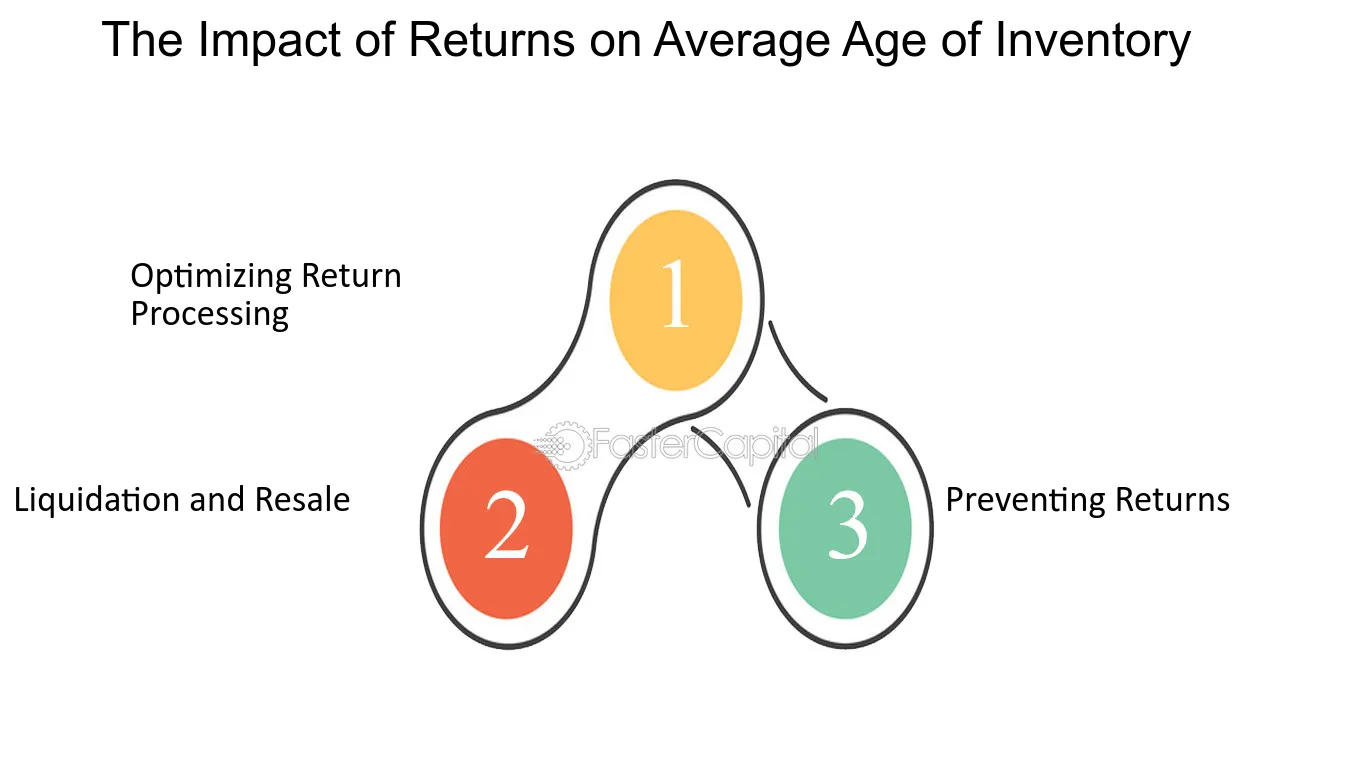
The Impact of Returns on Average Age of Inventory - Reverse logistics: Managing Returns to Maintain Average Age of Inventory
32. Understanding the Average Age of Inventory
When it comes to managing inventory, one of the crucial factors that businesses need to consider is the average age of inventory. This metric provides valuable insights into how quickly products are moving through the supply chain and can help businesses make informed decisions about their stock levels. In this section, we will delve deeper into the concept of average age of inventory and explore its significance in balancing safety stock and stockouts.
1. Definition of Average Age of Inventory: The average age of inventory is a measure of how long, on average, a product sits in inventory before it is sold. It is calculated by dividing the total number of days a product has been in inventory by the number of units sold during that period. For example, if a product has been in inventory for 30 days and 100 units have been sold, the average age of inventory would be 0.3 days.
2. Importance of Average Age of Inventory: Understanding the average age of inventory is vital for businesses as it helps them gauge the efficiency of their supply chain. A high average age of inventory indicates slow-moving products that are not being sold quickly enough, tying up valuable capital and potentially leading to obsolescence. On the other hand, a low average age of inventory suggests fast-moving products, indicating high demand and efficient inventory management.
3. Balancing Safety Stock and Average Age of Inventory: Maintaining a balance between safety stock and average age of inventory is crucial for businesses to avoid stockouts while minimizing carrying costs. Safety stock acts as a buffer to protect against unexpected fluctuations in demand or supply chain disruptions. However, excessive safety stock can increase the average age of inventory, tying up capital and increasing the risk of obsolescence.
4. Factors Affecting Average Age of Inventory: Several factors can impact the average age of inventory, including demand variability, lead time, and order quantities. For instance, products with high demand variability may require higher safety stock levels, increasing the average age of inventory. Similarly, longer lead times or larger order quantities can also contribute to a higher average age of inventory.
5. Strategies to Optimize Average Age of Inventory: To strike the right balance, businesses can employ various strategies to optimize their average age of inventory. These include accurate demand forecasting, reducing lead times through efficient supply chain management, implementing just-in-time (JIT) inventory systems, and employing dynamic safety stock calculations based on demand patterns.
6. Example Scenario: Let's consider an online retailer that sells electronic gadgets. During the holiday season, they experience a surge in demand for smartphones. To meet this increased demand, they decide to increase their safety stock levels. However, this decision leads to a higher average age of inventory as the additional stock takes longer to sell. By accurately forecasting the demand and adjusting safety stock levels accordingly, the retailer can ensure they have enough inventory to meet customer demands without excessively increasing the average age of inventory.
Understanding the average age of inventory is essential for businesses to strike the right balance between safety stock and stockouts. By closely monitoring this metric and implementing appropriate strategies, businesses can optimize their inventory management, improve cash flow, and enhance customer satisfaction.
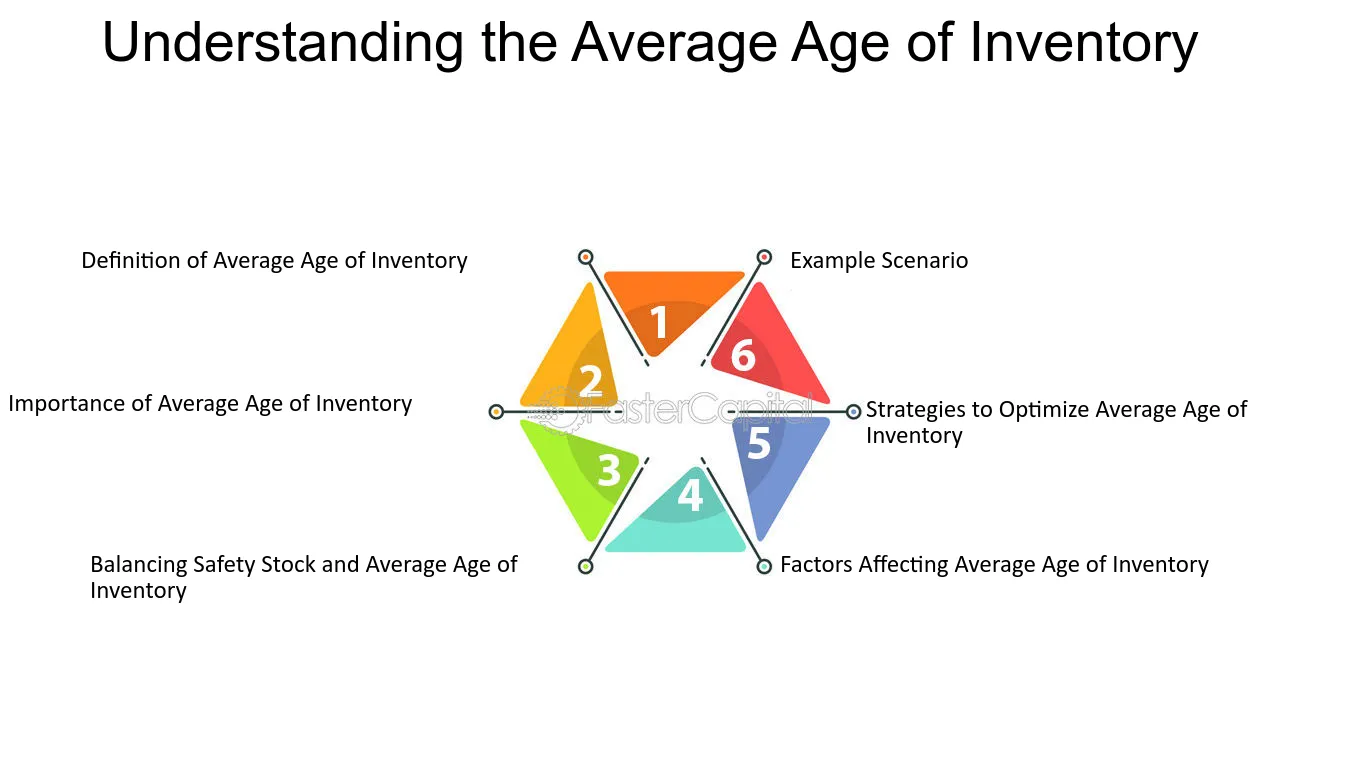
Understanding the Average Age of Inventory - Safety stock: Balancing Average Age of Inventory and Stockouts
33. The Role of Average Age of Inventory in Sales Velocity
When it comes to sales velocity, one crucial factor that often gets overlooked is the average age of inventory. The average age of inventory refers to the average length of time that products or goods remain in a company's inventory before being sold. This metric is vital because it directly impacts a company's ability to generate revenue and maintain profitability.
From the perspective of a business owner, a high average age of inventory can be detrimental to sales velocity. If products sit in the inventory for an extended period, it ties up valuable capital that could be used for other business activities. Moreover, holding onto inventory for too long can lead to increased storage costs, obsolescence, and even spoilage of perishable goods. On the other hand, a low average age of inventory indicates that products are moving quickly, resulting in a higher turnover rate and increased revenue.
To understand the role of average age of inventory in sales velocity better, let's dive into some key insights:
1. efficient inventory management: Maintaining an optimal average age of inventory requires effective inventory management. This includes accurate demand forecasting, monitoring sales trends, and implementing just-in-time inventory practices. By having the right amount of stock on hand, businesses can avoid excess inventory and prevent products from sitting idle for extended periods.
2. Customer demand and satisfaction: The average age of inventory directly reflects customer demand. If products are slow-moving, it may indicate a lack of interest or a mismatch between the products offered and customer preferences. By analyzing the average age of inventory, businesses can identify potential areas for improvement and make informed decisions about product assortment and marketing strategies.
3. Seasonal variations: Seasonal products or goods with a limited shelf life can significantly impact the average age of inventory. For example, a clothing retailer may experience a higher average age of inventory during off-seasons when demand decreases. Understanding these seasonal fluctuations enables businesses to plan and adjust their inventory levels accordingly, ensuring optimal sales velocity throughout the year.
4. supply chain efficiency: The average age of inventory is not solely dependent on internal factors but is also influenced by the efficiency of the supply chain. Delays in the procurement process, transportation issues, or supplier constraints can all contribute to a higher average age of inventory. Collaborating closely with suppliers and optimizing logistics can help reduce lead times and improve overall sales velocity.
To illustrate the impact of average age of inventory, let's consider an example. Imagine a technology retailer that specializes in smartphones. If this retailer holds onto a particular smartphone model for too long, it risks losing sales as newer models are released, and consumer preferences shift. By closely monitoring the average age of inventory and adjusting product assortment accordingly, the retailer can ensure faster turnover and capitalize on the latest market trends, ultimately enhancing sales velocity.
The average age of inventory plays a critical role in sales velocity. Businesses must strive to maintain an optimal average age of inventory by implementing efficient inventory management practices, understanding customer demand, considering seasonal variations, and optimizing the supply chain. By doing so, companies can improve sales velocity, increase revenue, and stay competitive in today's dynamic marketplace.
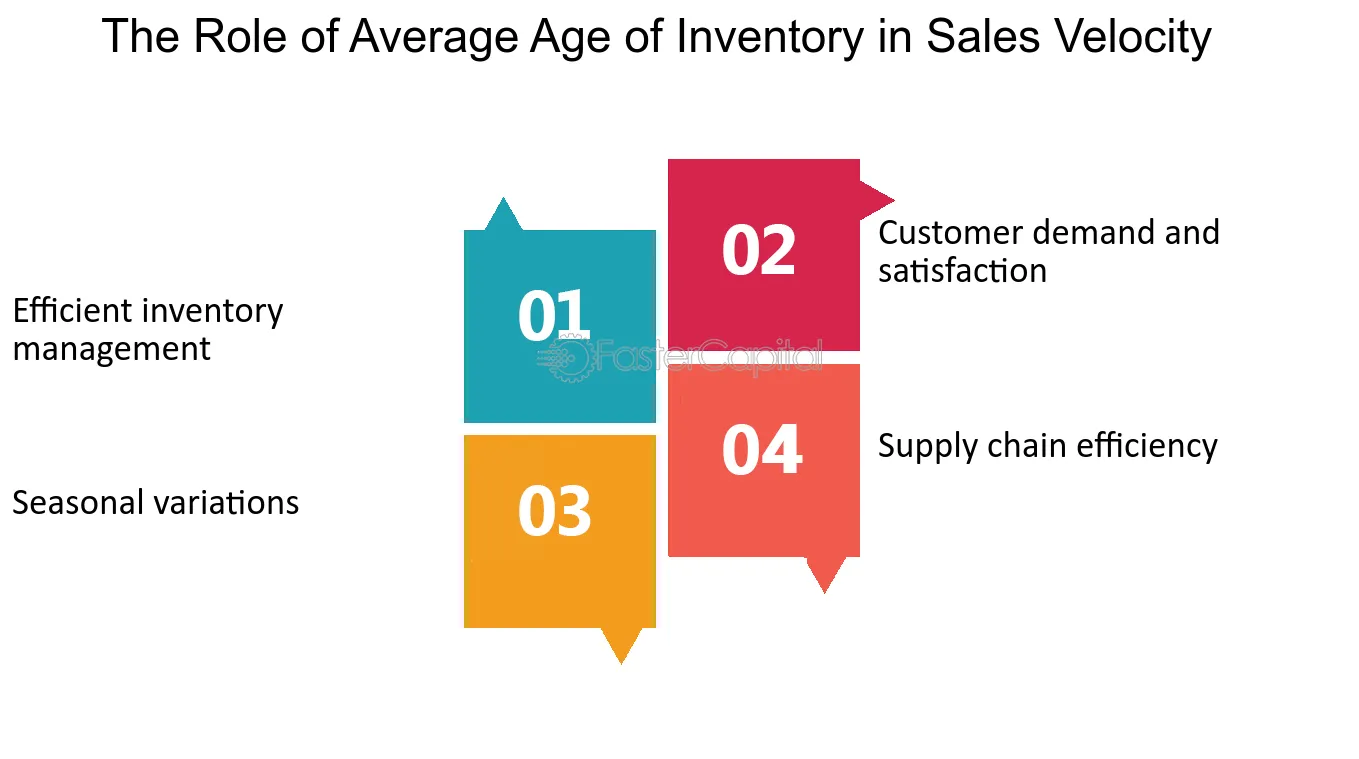
The Role of Average Age of Inventory in Sales Velocity - Sales velocity: Enhancing Average Age of Inventory Performance
34. Analyzing the Current Performance of Average Age of Inventory
Understanding the performance of the average age of inventory is crucial for businesses looking to optimize their sales velocity. By analyzing this metric, companies can gain valuable insights into the efficiency of their inventory management practices, identify potential bottlenecks, and make data-driven decisions to enhance overall performance. In this section, we will delve into the various aspects of analyzing the current performance of the average age of inventory, exploring different perspectives and providing in-depth information to help businesses optimize their inventory management strategies.
1. Definition and Calculation:
To begin our analysis, it is important to have a clear understanding of what the average age of inventory represents. This metric measures the average number of days it takes for inventory to be sold, from the time it enters the warehouse to the time it is shipped. calculating the average age of inventory involves dividing the total number of days inventory is held by the average daily sales during a specific period. For example, if a company holds inventory for an average of 30 days and has daily sales of 100 units, the average age of inventory would be 30 days.
2. Identifying Potential Issues:
Analyzing the current performance of the average age of inventory allows businesses to identify potential issues that may be hindering their sales velocity. High average age of inventory can indicate slow-moving or obsolete products, inefficient ordering processes, or inadequate demand forecasting. On the other hand, a low average age of inventory may suggest stockouts, missed sales opportunities, or excessive safety stock. By closely monitoring this metric, businesses can pinpoint areas for improvement and take appropriate actions to optimize their inventory management.
3. Benchmarking and Industry Standards:
One effective way to analyze the current performance of the average age of inventory is by benchmarking against industry standards. Comparing your company's average age of inventory to that of competitors or industry benchmarks can provide valuable insights into how well you are managing your inventory. For instance, if your average age of inventory is significantly higher than the industry average, it may indicate room for improvement in terms of inventory turnover and sales velocity. Conversely, if your average age of inventory is lower than the industry average, it may suggest efficient inventory management practices or higher demand for your products.
4. Seasonality and Demand Variations:
Seasonality and demand variations can significantly impact the average age of inventory. Understanding these fluctuations is crucial for accurate analysis and decision-making. For example, during peak seasons or promotional periods, inventory may move faster, resulting in a lower average age of inventory. On the other hand, during slower periods, the average age of inventory may increase as sales decline. By considering seasonality and demand variations in the analysis, businesses can make informed decisions regarding inventory levels, ordering quantities, and marketing strategies to optimize sales velocity.
5. optimizing Inventory turnover:
Analyzing the current performance of the average age of inventory can help businesses identify opportunities to optimize inventory turnover. By reducing the average age of inventory, companies can increase sales velocity, improve cash flow, and minimize carrying costs. Strategies to optimize inventory turnover may include implementing just-in-time (JIT) inventory management, improving demand forecasting accuracy, identifying slow-moving products for clearance, or negotiating better supplier terms. By continuously monitoring and analyzing the average age of inventory, businesses can proactively identify areas for improvement and implement strategies to enhance overall performance.
Analyzing the current performance of the average age of inventory is a crucial step in optimizing sales velocity. By understanding this metric, businesses can identify potential issues, benchmark against industry standards, consider seasonality and demand variations, and implement strategies to optimize inventory turnover. By continuously monitoring and analyzing the average age of inventory, companies can make data-driven decisions to enhance their inventory management practices, ultimately improving their bottom line and staying ahead in today's competitive market.
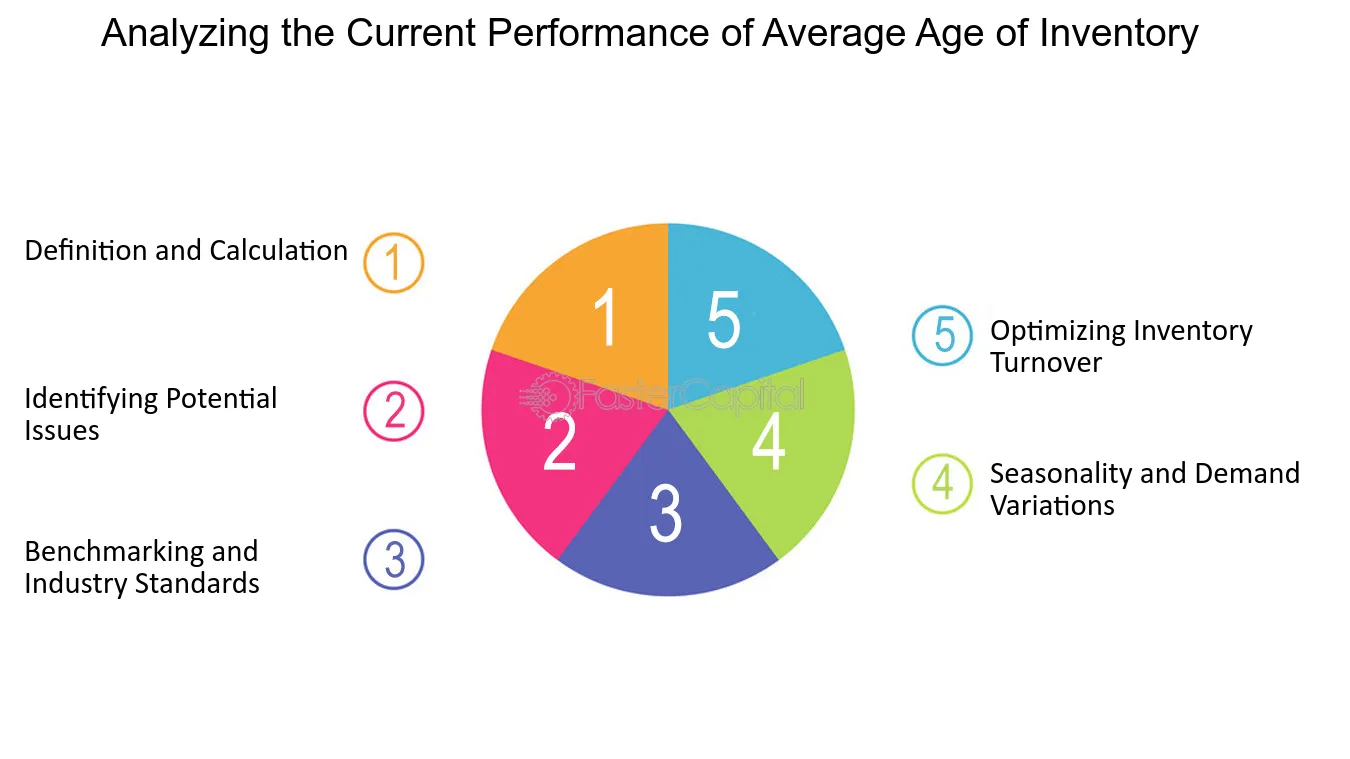
Analyzing the Current Performance of Average Age of Inventory - Sales velocity: Enhancing Average Age of Inventory Performance
35. Strategies for Improving Average Age of Inventory
When it comes to optimizing inventory performance, reducing the average age of inventory is a critical factor that businesses must consider. The average age of inventory refers to the amount of time it takes for inventory to be sold or used up. A high average age of inventory can lead to increased holding costs, reduced cash flow, and potential obsolescence of goods. Therefore, it is essential for businesses to implement effective strategies to improve their average age of inventory and enhance sales velocity. In this section, we will explore some valuable strategies from different perspectives that can help businesses achieve this objective.
1. Demand Forecasting and Inventory Planning:
Accurate demand forecasting is the cornerstone of inventory management. By analyzing historical sales data, market trends, and customer behavior, businesses can make informed decisions about the quantity and timing of inventory replenishment. Effective inventory planning ensures that products are available when customers demand them, reducing the likelihood of excess stock and a high average age of inventory. For instance, a clothing retailer can analyze past sales data to predict the demand for particular styles, sizes, and colors, enabling them to optimize their inventory levels accordingly.
2. Implementing Just-in-Time (JIT) Inventory:
The JIT inventory system focuses on minimizing inventory levels by having goods delivered precisely when they are needed. This strategy helps businesses reduce holding costs and the risk of inventory obsolescence. By maintaining close relationships with suppliers and utilizing real-time inventory tracking systems, businesses can ensure that inventory is replenished as soon as it is required. For example, a manufacturing company can adopt JIT inventory practices to receive raw materials just in time for production, minimizing storage costs and improving cash flow.
3. enhancing Supply chain Collaboration:
Collaboration with suppliers and distributors is crucial for streamlining the flow of goods and reducing the average age of inventory. By sharing accurate sales and inventory data with partners, businesses can improve communication and coordination, leading to more efficient inventory management. For instance, a retailer can collaborate with its suppliers to implement vendor-managed inventory (VMI), where suppliers monitor and replenish inventory levels based on real-time sales data, reducing the risk of stockouts and excess inventory.
4. Implementing Sales and Promotions:
Strategic sales and promotions can help businesses clear out slow-moving inventory and reduce the average age of inventory. By offering discounts, bundle deals, or limited-time offers, businesses can incentivize customers to purchase products that have been in stock for an extended period. This strategy not only increases sales velocity but also frees up valuable storage space for new, in-demand products. For example, a technology retailer can offer a discount on older smartphone models to encourage customers to make a purchase and make room for the latest releases.
5. Analyzing and optimizing Product mix:
Regularly analyzing the performance of individual products within the inventory mix is crucial for identifying slow-moving items. By categorizing products based on their sales velocity and profitability, businesses can make informed decisions about discontinuing or discounting underperforming products. This optimization of the product mix helps reduce the average age of inventory by focusing on items that are in high demand and generating revenue. For instance, a grocery store can analyze sales data to identify products with low turnover rates and explore options to replace them with more popular alternatives.
Improving the average age of inventory is essential for businesses to optimize their inventory performance and enhance sales velocity. By implementing strategies such as demand forecasting, JIT inventory, supply chain collaboration, sales and promotions, and product mix optimization, businesses can reduce holding costs, improve cash flow, and minimize the risk of inventory obsolescence. These strategies, when applied effectively, can lead to increased customer satisfaction, improved profitability, and a competitive edge in the market.
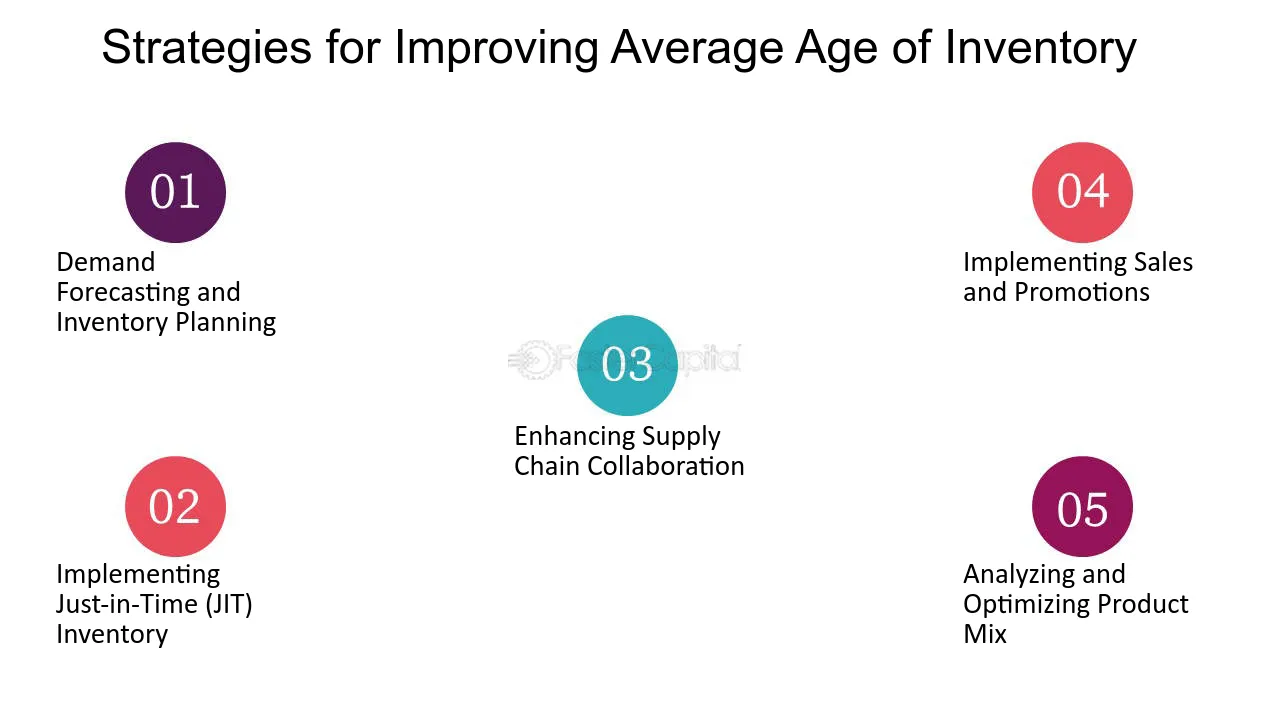
Strategies for Improving Average Age of Inventory - Sales velocity: Enhancing Average Age of Inventory Performance
36. Utilizing Technology and Automation to Enhance Average Age of Inventory
In the fast-paced world of sales and inventory management, businesses are constantly striving to improve their performance and stay ahead of the competition. One crucial metric that plays a significant role in this endeavor is the average age of inventory. This metric measures the average number of days it takes for a product to be sold or consumed. A lower average age of inventory indicates that products are being sold quickly, which is a positive sign for any business. In this section, we will explore how technology and automation can be utilized to enhance the average age of inventory, resulting in improved sales velocity and overall performance.
1. streamlining Inventory management:
One of the key ways technology can enhance the average age of inventory is by streamlining inventory management processes. By implementing an inventory management system, businesses can automate various tasks such as tracking stock levels, monitoring demand patterns, and generating accurate forecasts. This enables businesses to have real-time visibility into their inventory, allowing them to make informed decisions about replenishment, pricing, and promotions. For example, an automated system can send alerts when stock levels are running low, ensuring that products are replenished in a timely manner to avoid stockouts. This proactive approach helps businesses maintain optimal inventory levels, reducing the average age of inventory.
2. Implementing Demand-Driven Strategies:
Technology also empowers businesses to implement demand-driven strategies, further improving the average age of inventory. By leveraging data analytics and machine learning algorithms, businesses can gain insights into customer behavior, market trends, and demand patterns. This enables them to accurately forecast demand and align their inventory accordingly. For instance, a retailer can use historical sales data and predictive analytics to identify seasonal demand fluctuations for certain products. Armed with this knowledge, they can adjust their inventory levels accordingly, ensuring they have the right products available at the right time. By aligning inventory with demand, businesses can minimize excess stock and reduce the average age of inventory.
3. Leveraging Automation in Fulfillment:
Automation plays a crucial role in enhancing the average age of inventory by expediting the fulfillment process. With the rise of e-commerce, customers have come to expect fast and efficient order fulfillment. By leveraging automation technologies such as robotics and conveyor systems, businesses can significantly reduce the time it takes to process and ship orders. For example, an online retailer can utilize automated picking systems that scan barcodes and retrieve products from designated locations, minimizing human error and speeding up order fulfillment. By streamlining the fulfillment process, businesses can ensure that products reach customers quickly, reducing the average age of inventory.
4. Embracing Just-in-Time Inventory:
Just-in-Time (JIT) inventory management is a strategy that aims to minimize inventory levels by receiving goods only when they are needed. By embracing JIT inventory management and leveraging technology, businesses can reduce the average age of inventory. For instance, a manufacturer can implement automated systems that notify suppliers when certain materials are running low, triggering a replenishment order. This ensures that materials arrive just in time for production, minimizing the need for excess inventory. By implementing JIT practices, businesses can reduce carrying costs and improve inventory turnover, ultimately reducing the average age of inventory.
Technology and automation have become indispensable tools for businesses looking to enhance the average age of inventory. By streamlining inventory management processes, implementing demand-driven strategies, leveraging automation in fulfillment, and embracing JIT inventory practices, businesses can significantly improve their sales velocity and overall performance. As technology continues to advance, businesses must embrace these tools to stay competitive in today's dynamic marketplace.
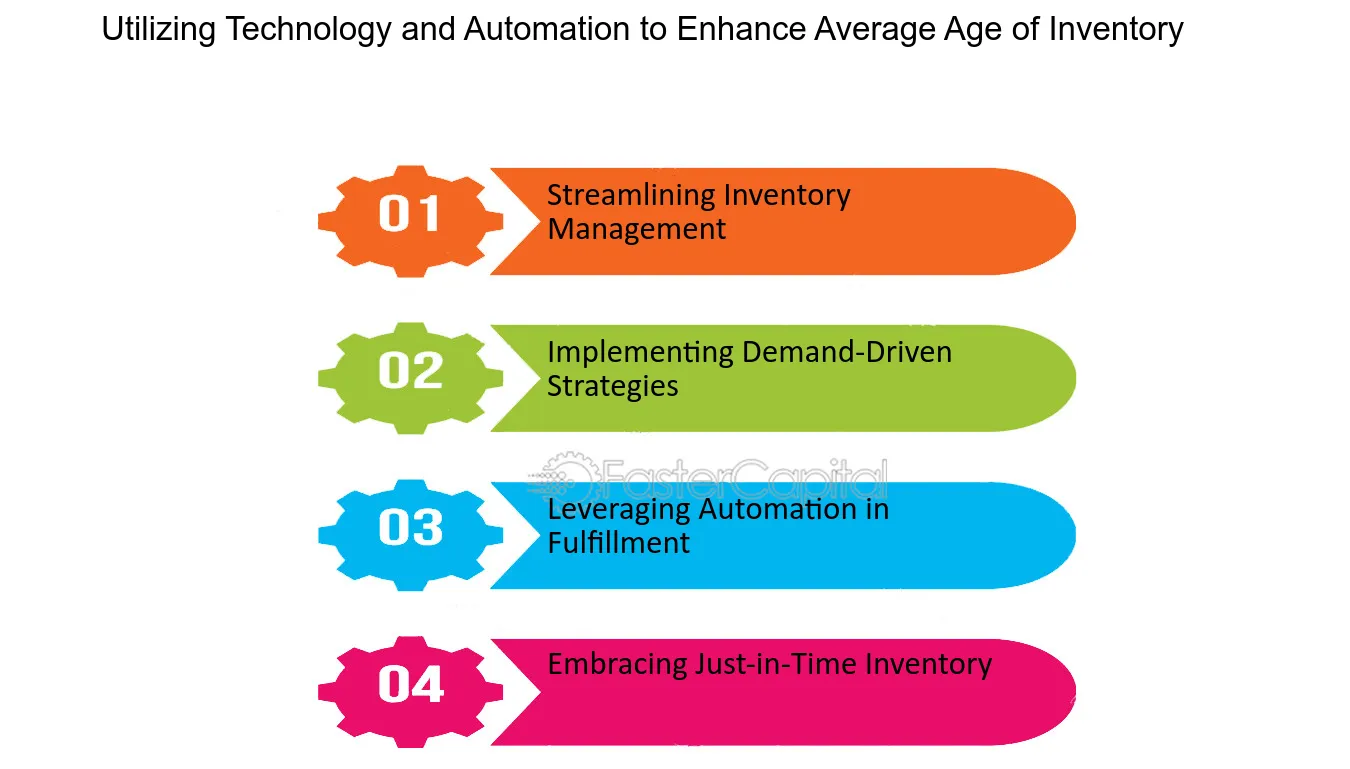
Utilizing Technology and Automation to Enhance Average Age of Inventory - Sales velocity: Enhancing Average Age of Inventory Performance
37. Understanding the Concept of Average Age of Inventory
Section: Understanding the Concept of Average Age of Inventory
In the dynamic landscape of inventory management, understanding the Average Age of Inventory (AAI) is pivotal. It serves as a critical metric, offering insights into the efficiency of a company's supply chain. The AAI essentially represents the average number of days it takes for a company to sell its entire inventory. This figure holds significant implications for businesses across various industries, influencing decision-making processes related to procurement, production, and sales strategies.
1. Calculation of Average Age of Inventory:
To compute the AAI, one must divide the average inventory value by the cost of goods sold (COGS) over a specific period. This yields a numerical value that denotes the average number of days it takes for inventory to flow through the system. For instance, consider a retail company with an average inventory value of $100,000 and a COGS of $1,000,000 over a year. The AAI would be 36.5 days, indicating it takes, on average, over a month for the company to sell its entire inventory.
2. Implications of AAI on Working Capital:
A low AAI implies that a company is efficient in turning over its inventory, which can lead to reduced carrying costs. This, in turn, can free up working capital for other crucial business operations. Conversely, a high AAI indicates slower turnover, potentially tying up capital in stagnant inventory. For instance, a manufacturing firm with a low AAI might be able to allocate more resources towards research and development or expansion efforts.
3. Customer Satisfaction and AAI:
From a customer perspective, a low AAI can be a positive sign. It means that products are readily available, reducing the chances of stockouts and ensuring customer satisfaction. On the other hand, a high AAI may lead to stockouts, potentially frustrating customers and damaging the company's reputation. Consider an e-commerce platform that maintains a low AAI, consistently delivering products to customers promptly. This enhances customer trust and loyalty.
4. Adapting AAI to Seasonal Demand:
One of the key challenges in inventory management is accommodating seasonal fluctuations in demand. Companies must strike a balance between avoiding stockouts during high-demand periods and preventing excess inventory during lulls. By analyzing historical data and adjusting the AAI based on seasonal trends, businesses can better align their inventory levels with market dynamics. For example, a winter sports equipment retailer may ramp up inventory levels in the fall to meet the surge in demand as winter approaches.
5. Optimizing Production and Procurement with AAI:
The AAI also plays a crucial role in production and procurement planning. By examining the AAI alongside lead times for production and procurement processes, companies can fine-tune their ordering schedules. For instance, a manufacturer with a high AAI may need to adjust production schedules to avoid overstocking. This can lead to cost savings and improved overall operational efficiency.
Understanding the Average Age of Inventory goes beyond mere numerical analysis. It delves into the heart of operational efficiency, impacting working capital, customer satisfaction, and adaptability to market fluctuations. By harnessing the power of AAI, businesses can navigate the complex terrain of inventory management with precision and agility.
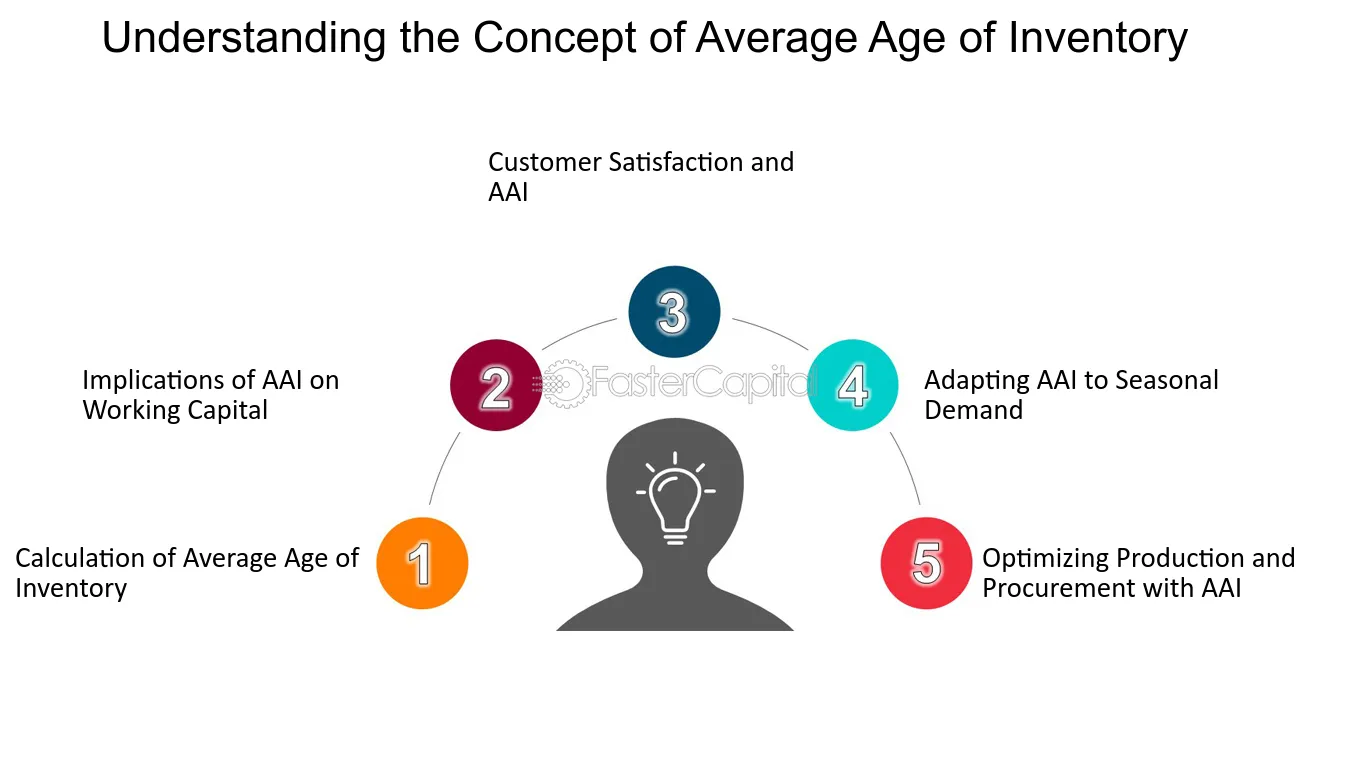
Understanding the Concept of Average Age of Inventory - Seasonal demand: Adapting Average Age of Inventory to Market Fluctuations
38. Analyzing Market Fluctuations and Their Effects on Average Age of Inventory
Market fluctuations can have a significant impact on the average age of inventory for businesses across various industries. Understanding these fluctuations and their effects is crucial for adapting inventory management strategies and maximizing profitability. In this section, we will delve into the intricacies of market fluctuations and explore how they influence the average age of inventory.
1. Seasonal Demand: One of the primary drivers of market fluctuations is seasonal demand. Many industries experience predictable peaks and valleys throughout the year, such as the retail sector during the holiday season. During periods of high demand, businesses may need to increase their inventory levels to meet customer needs, which can result in a decrease in the average age of inventory. Conversely, during slower seasons, excess inventory may accumulate, leading to a higher average age of inventory.
For example, a clothing retailer may experience a surge in demand for winter coats during the colder months. To capitalize on this seasonal trend, the retailer would need to maintain sufficient stock levels to meet customer demands. As a result, the average age of inventory for winter coats would decrease during this period, as the turnover rate is higher. However, during the summer months, when demand for winter coats dwindles, the average age of inventory would increase as the retailer holds onto excess stock.
2. Economic Factors: Economic conditions play a vital role in market fluctuations and subsequently impact the average age of inventory. Factors such as inflation, interest rates, and consumer spending habits can influence both supply and demand, thereby affecting inventory turnover rates.
Consider the housing market as an example. During a booming real estate market, home builders and suppliers experience increased demand for construction materials. To meet this demand, they may need to stockpile inventory, resulting in a lower average age of inventory. Conversely, during an economic downturn, when construction activity slows down, excess inventory may accumulate, leading to a higher average age of inventory.
3. Competitive Landscape: The competitive landscape within an industry can also contribute to market fluctuations and subsequently impact the average age of inventory. When there is intense competition, businesses may engage in aggressive pricing strategies or promotional activities to gain market share. This can lead to sudden fluctuations in demand and require businesses to adjust their inventory levels accordingly.
For instance, in the electronics industry, new product launches and technological advancements can quickly render existing inventory obsolete. To stay competitive, businesses must carefully manage their inventory to avoid being left with outdated products, which would increase the average age of inventory. By closely monitoring market trends and competitor activities, businesses can adapt their inventory management strategies to ensure optimal turnover rates.
4. supply Chain disruptions: Supply chain disruptions, such as natural disasters, trade disputes, or pandemics, can cause significant market fluctuations and disrupt inventory management. When the supply of raw materials or finished goods is disrupted, businesses may face shortages or delays in receiving inventory. This can result in increased average age of inventory as businesses struggle to meet customer demands with limited stock.
The COVID-19 pandemic serves as a prime example of how supply chain disruptions can impact the average age of inventory. As countries implemented lockdown measures and restricted international trade, businesses faced challenges in sourcing goods. This led to inventory shortages and increased average age of inventory for certain products, particularly those reliant on global supply chains.
Analyzing market fluctuations and their effects on the average age of inventory is essential for businesses to adapt their inventory management strategies accordingly. By understanding the factors driving market fluctuations and leveraging insights from different perspectives, businesses can optimize their inventory turnover rates and maintain a competitive edge in dynamic market environments.
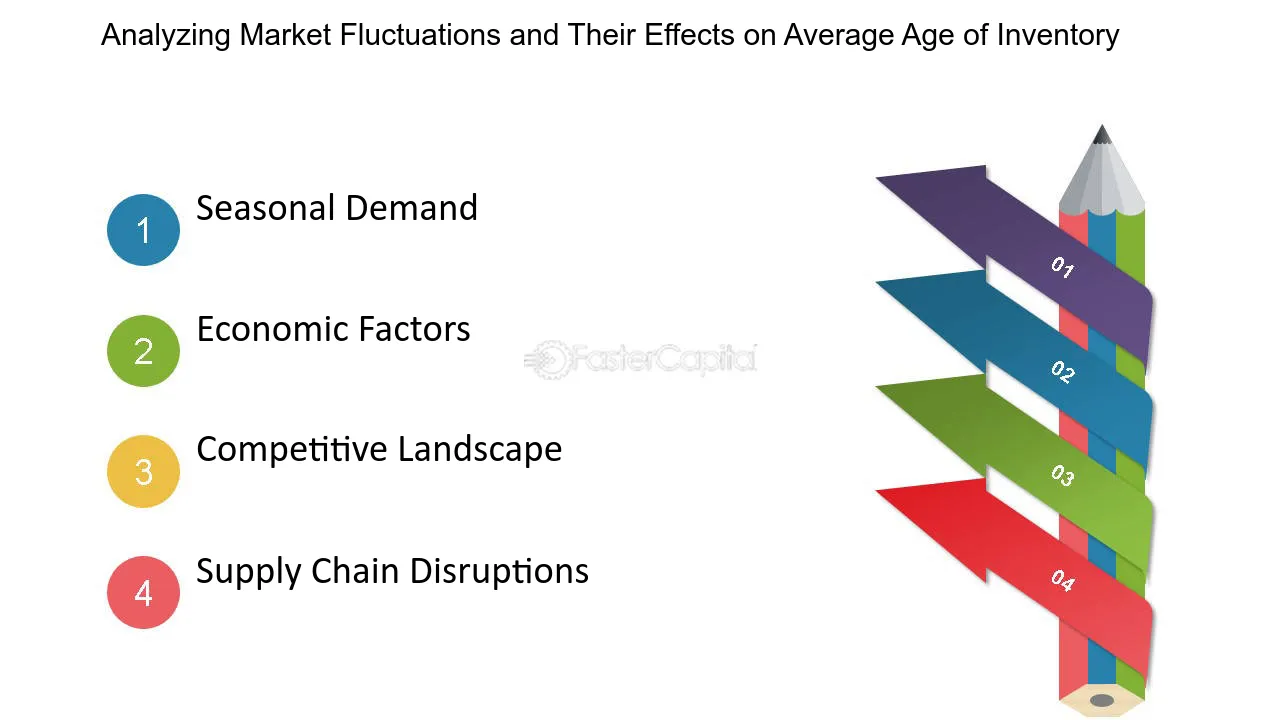
Analyzing Market Fluctuations and Their Effects on Average Age of Inventory - Seasonal demand: Adapting Average Age of Inventory to Market Fluctuations
39. Strategies for Adapting Average Age of Inventory to Seasonal Demand
When it comes to managing inventory, one of the key challenges businesses face is adapting to seasonal demand fluctuations. Seasonal demand refers to the variations in consumer purchasing behavior that occur throughout the year, often driven by factors such as holidays, weather conditions, or cultural events. To effectively navigate these fluctuations and optimize inventory levels, businesses must employ strategies that take into account the average age of inventory.
1. Forecasting and Planning: The first step in adapting the average age of inventory to seasonal demand is accurate forecasting and planning. By analyzing historical sales data and identifying patterns, businesses can anticipate demand fluctuations and adjust their inventory levels accordingly. For instance, a clothing retailer may predict increased demand for winter coats during the colder months and adjust their inventory levels accordingly. This proactive approach ensures that businesses are prepared to meet customer demands without excess or shortage of stock.
2. Just-in-Time Inventory Management: Just-in-time (JIT) inventory management is a strategy that aims to reduce carrying costs and minimize inventory obsolescence by ordering and receiving goods just in time for production or sale. By implementing JIT practices, businesses can adapt the average age of inventory to seasonal demand more effectively. For example, a toy manufacturer may utilize JIT principles and ramp up production closer to the holiday season to meet increased demand, minimizing the need to hold excess inventory throughout the year.
3. Promotions and Discounts: Another strategy to adapt the average age of inventory to seasonal demand is through targeted promotions and discounts. By offering incentives during slower periods, businesses can stimulate demand and reduce excess inventory. For instance, a swimwear retailer may offer discounts on bathing suits during the winter months to encourage off-season purchases. This approach not only helps to clear out older inventory but also generates revenue during periods of lower demand.
4. Collaboration with Suppliers: Collaborating closely with suppliers is crucial for effectively managing the average age of inventory in response to seasonal demand. By sharing sales forecasts and insights with suppliers, businesses can ensure a steady supply of inventory that aligns with expected demand. This collaborative approach helps to minimize stockouts or excess inventory, improving overall efficiency and customer satisfaction. For example, a grocery store may work closely with its produce suppliers to ensure a consistent supply of seasonal fruits and vegetables based on anticipated demand.
5. Agile Inventory Management Systems: Investing in agile inventory management systems can greatly facilitate the adaptation of the average age of inventory to seasonal demand. These systems leverage advanced analytics and real-time data to provide businesses with accurate insights into consumer behavior, enabling them to make informed decisions about inventory levels. By utilizing such systems, businesses can optimize their stock levels and align them with seasonal demand, reducing carrying costs and improving overall operational efficiency.
Adapting the average age of inventory to seasonal demand is a critical aspect of effective inventory management. By employing strategies such as accurate forecasting, JIT inventory management, targeted promotions, collaboration with suppliers, and agile inventory management systems, businesses can optimize their inventory levels and ensure they are well-prepared to meet customer demands throughout the year. By staying proactive and responsive to seasonal fluctuations, businesses can achieve a competitive edge in the market while minimizing costs and maximizing customer satisfaction.
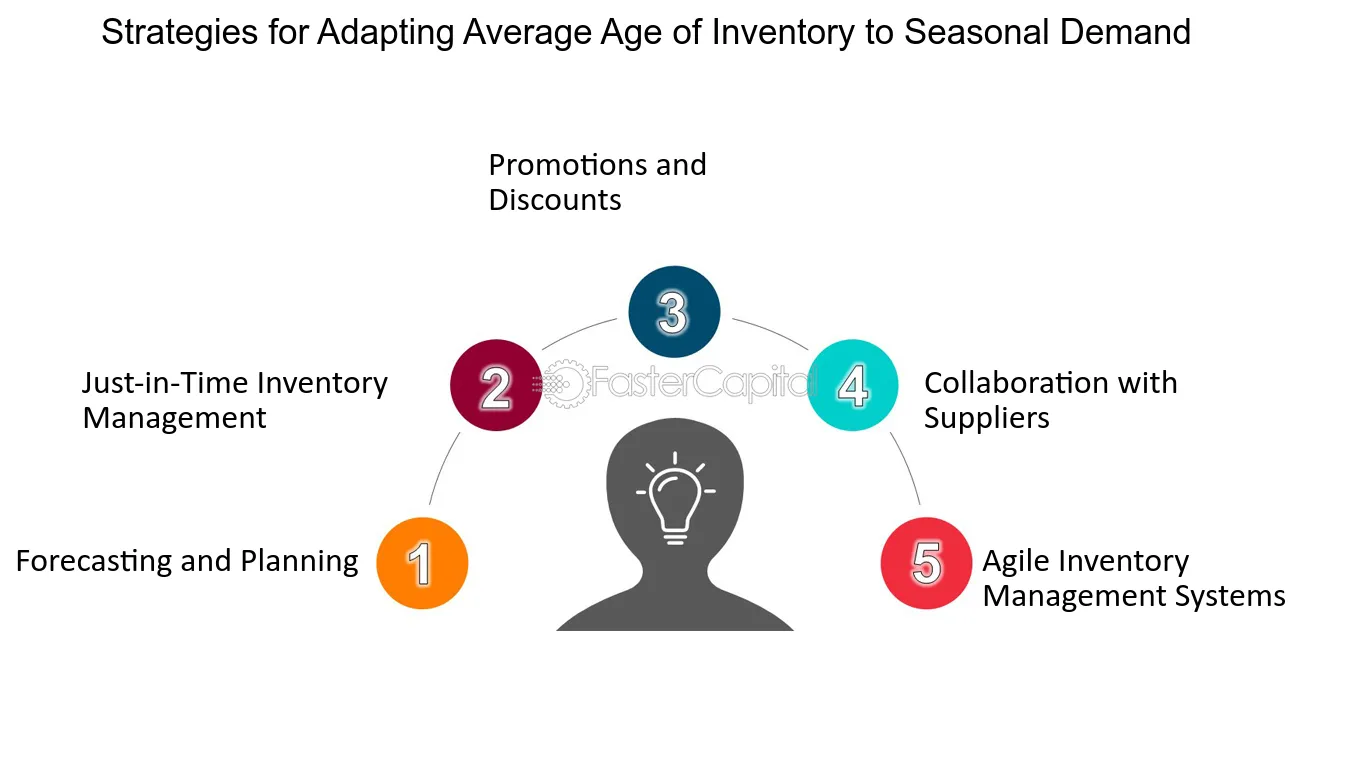
Strategies for Adapting Average Age of Inventory to Seasonal Demand - Seasonal demand: Adapting Average Age of Inventory to Market Fluctuations
40. Challenges and Pitfalls in Adjusting Average Age of Inventory
When it comes to managing inventory, one of the key factors that businesses need to consider is the average age of inventory. The average age of inventory refers to the average length of time that a product remains in the inventory before it is sold. It is a crucial metric that helps businesses determine the efficiency of their inventory management processes and make informed decisions regarding restocking, pricing, and forecasting. However, adjusting the average age of inventory to market fluctuations can be a challenging task, fraught with pitfalls that can potentially impact a business's bottom line.
1. accurate demand forecasting: One of the primary challenges in adjusting the average age of inventory lies in accurately forecasting demand. Market fluctuations, seasonal trends, and unforeseen events can significantly impact consumer demand, making it difficult for businesses to accurately predict how much inventory they will need to meet customer requirements. Without accurate demand forecasting, businesses may end up with excess inventory that ages quickly or face stockouts due to underestimating demand.
For example, a clothing retailer may experience a surge in demand for winter jackets during the winter season. Failing to accurately anticipate this spike in demand may result in either excess inventory at the end of the season or missed sales opportunities due to stockouts. Both scenarios can negatively impact the average age of inventory and ultimately affect profitability.
2. supply chain complexities: Adjusting the average age of inventory also requires businesses to navigate the complexities of their supply chain. From sourcing raw materials to manufacturing and distribution, each step in the supply chain can introduce delays and inefficiencies that can impact the overall age of inventory.
For instance, a manufacturer relying on multiple suppliers may face challenges in coordinating the timely delivery of raw materials. Delays in the arrival of essential components can lead to production bottlenecks and longer lead times, resulting in an increase in the average age of inventory. On the other hand, a streamlined and efficient supply chain can help businesses reduce the average age of inventory by ensuring timely replenishment and minimizing lead times.
3. Inventory turnover and obsolescence: Another pitfall in adjusting the average age of inventory lies in balancing inventory turnover and minimizing obsolescence. Inventory turnover refers to the speed at which inventory is sold and replenished, while obsolescence refers to the risk of products becoming outdated or no longer in demand.
Maintaining a healthy inventory turnover rate is essential for businesses to prevent excessive aging of inventory. However, trying to maximize turnover without considering obsolescence risks can lead to significant losses. For example, a technology retailer may decide to stock up on the latest smartphone models to meet high demand during a promotional period. However, if the demand drops suddenly or a new model is released, the retailer may be left with excess inventory that quickly ages and becomes obsolete.
4. Pricing strategies: Adjusting the average age of inventory also requires careful consideration of pricing strategies. Businesses need to strike a balance between maximizing profit margins and ensuring competitive pricing to attract customers. Overpricing can lead to slower inventory turnover and increased average age, while underpricing may result in reduced profitability and the need to clear out aged inventory at discounted prices.
For instance, a grocery store may face challenges in adjusting the average age of perishable items like fruits and vegetables. Setting prices too high may discourage customers from purchasing, leading to increased waste and aging inventory. On the other hand, setting prices too low may result in decreased profitability and the need to sell off items before they reach their expiration date.
Adjusting the average age of inventory to market fluctuations is a multifaceted task that requires businesses to overcome various challenges and pitfalls. Accurate demand forecasting, supply chain complexities, balancing inventory turnover and obsolescence, and pricing strategies all play a crucial role in managing the average age of inventory effectively. By understanding and addressing these challenges, businesses can optimize their inventory management processes and ensure a healthy balance between supply and demand.
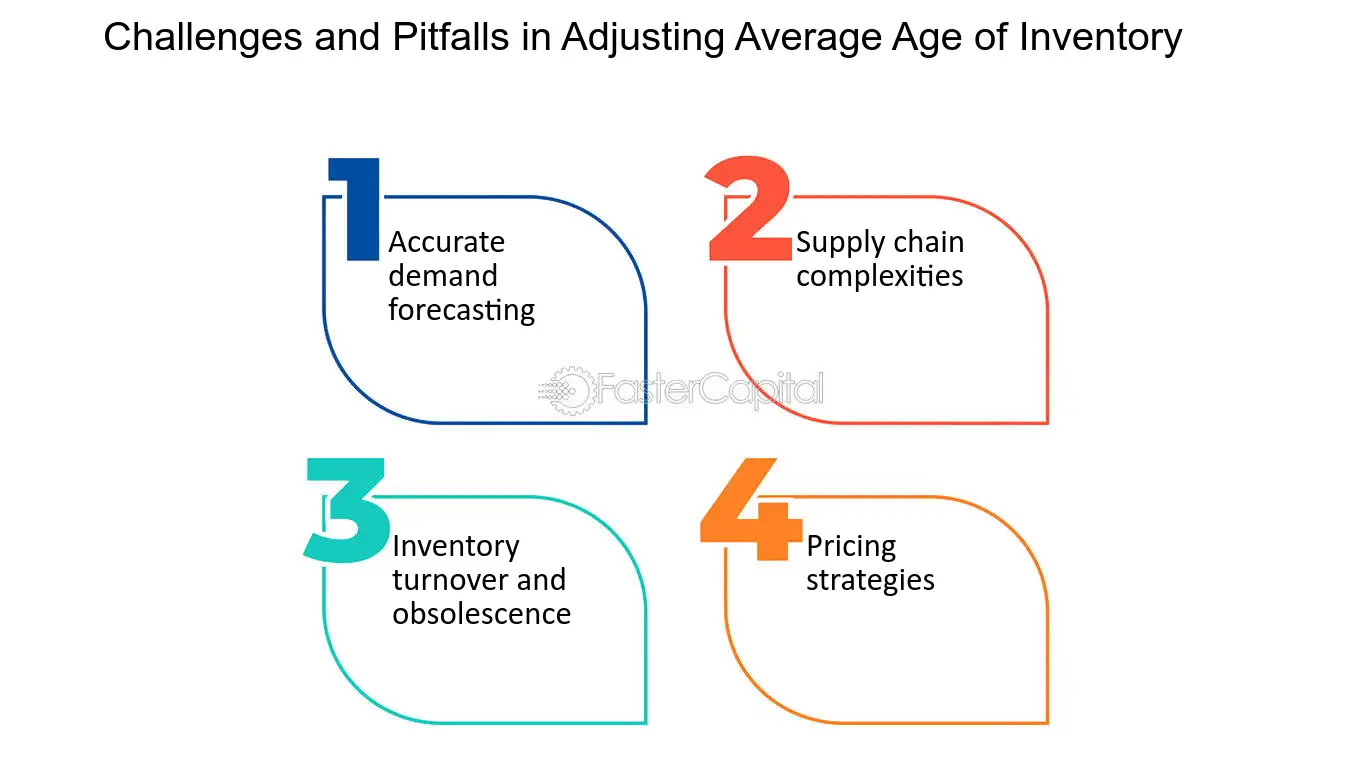
Challenges and Pitfalls in Adjusting Average Age of Inventory - Seasonal demand: Adapting Average Age of Inventory to Market Fluctuations
41. Average Age Inventory Method Explained
The average age inventory method is a crucial tool in stock management that enables businesses to gain a comprehensive understanding of their inventory control. By calculating the average age of inventory, businesses can make informed decisions regarding procurement, sales, and overall inventory management. This method takes into account the age of each individual item in stock, providing valuable insights into the efficiency and effectiveness of inventory control processes. In this section, we will delve deeper into the average age inventory method, discussing its benefits, applications, and potential challenges.
1. enhanced Decision-making: The average age inventory method allows businesses to make data-driven decisions by providing a clear picture of how long items have been sitting in stock. By analyzing the average age of inventory, businesses can determine which items are slow-moving or obsolete and adjust their procurement strategies accordingly. For example, if a particular product has been in stock for an extended period, it may indicate a need to reassess its demand or consider implementing promotional strategies to expedite its sale.
2. Optimized Inventory Levels: Maintaining optimal inventory levels is crucial to avoid stockouts or excess inventory, both of which can have a significant impact on profitability. The average age inventory method aids in achieving this balance by identifying items that have been in stock for too long or are approaching expiration. By regularly monitoring the average age of inventory, businesses can proactively adjust their stocking levels, reducing carrying costs and ensuring a steady supply of fresh products.
3. efficient Cash Flow management: Inventory ties up a significant portion of a business's capital, making efficient cash flow management essential. The average age inventory method helps businesses identify slow-moving or obsolete items that may be tying up capital unnecessarily. By addressing these inventory issues promptly, businesses can free up cash and allocate it to more profitable areas of their operations.
4. Challenges and Limitations: While the average age inventory method provides valuable insights, it is not without its challenges. One limitation is the need for accurate and up-to-date data. Inaccurate inventory records or missing data can skew the average age calculations and lead to erroneous conclusions. It is crucial for businesses to invest in robust inventory management systems and conduct regular stock audits to ensure data integrity.
5. Integration with Technology: Leveraging technology can greatly enhance the effectiveness of the average age inventory method. Inventory management software and systems can automate the calculation of average age, eliminating the need for manual calculations and reducing the risk of errors. Additionally, integrating inventory management systems with point-of-sale data or customer relationship management systems can provide a more holistic view of inventory performance, enabling businesses to make more informed decisions.
To illustrate the benefits of the average age inventory method, let's consider a retail clothing store. By analyzing the average age of inventory, the store can identify which clothing items have been sitting on the shelves for an extended period. Suppose the average age calculation reveals that a particular style of jeans has been in stock for over six months. This information prompts the store to take action, such as implementing a promotional campaign or offering discounts, to encourage customers to purchase the jeans. This proactive approach helps prevent the accumulation of stale inventory, maximizing sales and minimizing the need for markdowns.
The average age inventory method is a powerful tool that empowers businesses to make informed decisions regarding their inventory control. By calculating the average age of inventory, businesses can optimize their stocking levels, improve cash flow management, and enhance overall operational efficiency. However, it is important to address challenges such as data accuracy and leverage technology to fully harness the potential of this method.
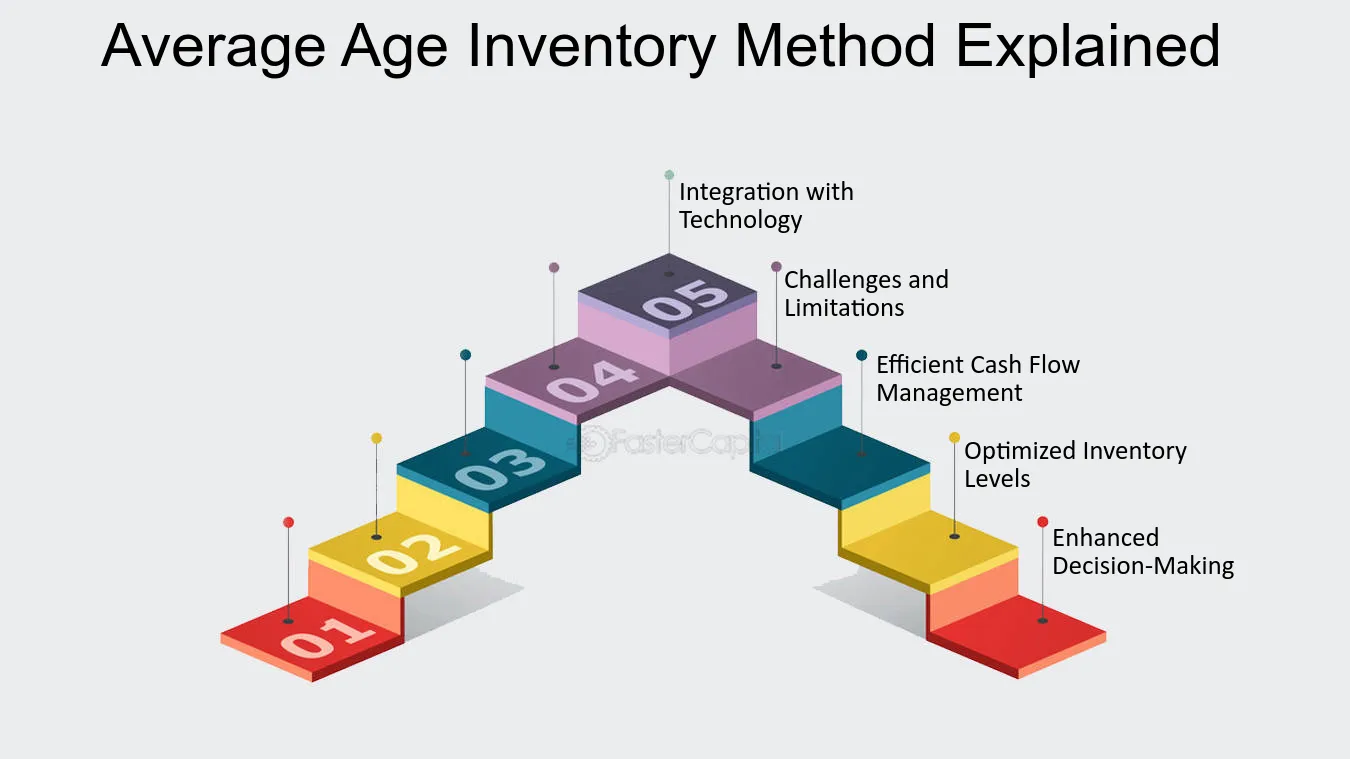
Average Age Inventory Method Explained - Stock management: Mastering Inventory Control: The Power of Average Age
42. Benefits of Using Average Age Inventory
When it comes to managing inventory, businesses often face the challenge of maintaining a healthy balance between supply and demand. One effective tool that can aid in this endeavor is the use of average age inventory. Average age inventory refers to the average amount of time that products spend in a company's inventory before being sold. By analyzing this data, businesses can gain valuable insights into their inventory control and make informed decisions that can lead to improved profitability and customer satisfaction.
1. Improved Inventory Management: One of the key benefits of using average age inventory is that it allows businesses to have a better understanding of their inventory levels. By calculating the average age of inventory, companies can identify slow-moving or obsolete items that may be tying up valuable resources. This insight enables them to make data-driven decisions regarding purchasing, production, and pricing strategies. For example, if a particular product has a high average age, it may indicate a need to adjust the order quantity or discontinue the item altogether.
2. Minimized Holding Costs: Holding costs, which include expenses such as storage, insurance, and depreciation, can significantly impact a company's bottom line. By using average age inventory, businesses can identify items that have been sitting in the inventory for an extended period. These slow-moving items can then be evaluated to determine if they are worth the associated holding costs. If the holding costs outweigh the potential profit, businesses can take action to reduce the inventory, such as offering discounts or implementing targeted marketing campaigns.
3. Reduced Risk of Obsolescence: In today's fast-paced market, products can quickly become outdated, leading to a loss in value. Average age inventory provides businesses with a means to track the age of their inventory and identify items that are at risk of becoming obsolete. Armed with this knowledge, companies can proactively manage their inventory by implementing strategies such as promotions, liquidation, or product enhancements to mitigate the risk of obsolescence. For instance, a clothing retailer may use average age inventory to identify seasonal items that need to be discounted before the next season arrives.
4. Enhanced Customer Satisfaction: efficient inventory management is crucial for meeting customer demands and ensuring timely product availability. By utilizing average age inventory, businesses can gain insights into their stock levels and accurately forecast future demand. This enables them to maintain optimal inventory levels, reducing the likelihood of stockouts or overstock situations. Consequently, customers are more likely to find the products they need when they need them, leading to higher customer satisfaction and loyalty.
5. improved Cash flow: Effective inventory control directly impacts a company's cash flow. By utilizing average age inventory, businesses can identify slow-moving or excess inventory that may be tying up financial resources. This information allows them to make informed decisions regarding inventory replenishment, reducing the need for excessive stock levels. As a result, businesses can free up cash that can be better utilized in other areas of the company, such as marketing, research, or expansion initiatives.
The benefits of using average age inventory are numerous and can greatly contribute to a company's success. From improved inventory management and minimized holding costs to reduced risk of obsolescence and enhanced customer satisfaction, this tool provides businesses with valuable insights that can drive profitability and efficiency. By harnessing the power of average age inventory, companies can master inventory control and navigate the complex world of supply and demand with confidence.
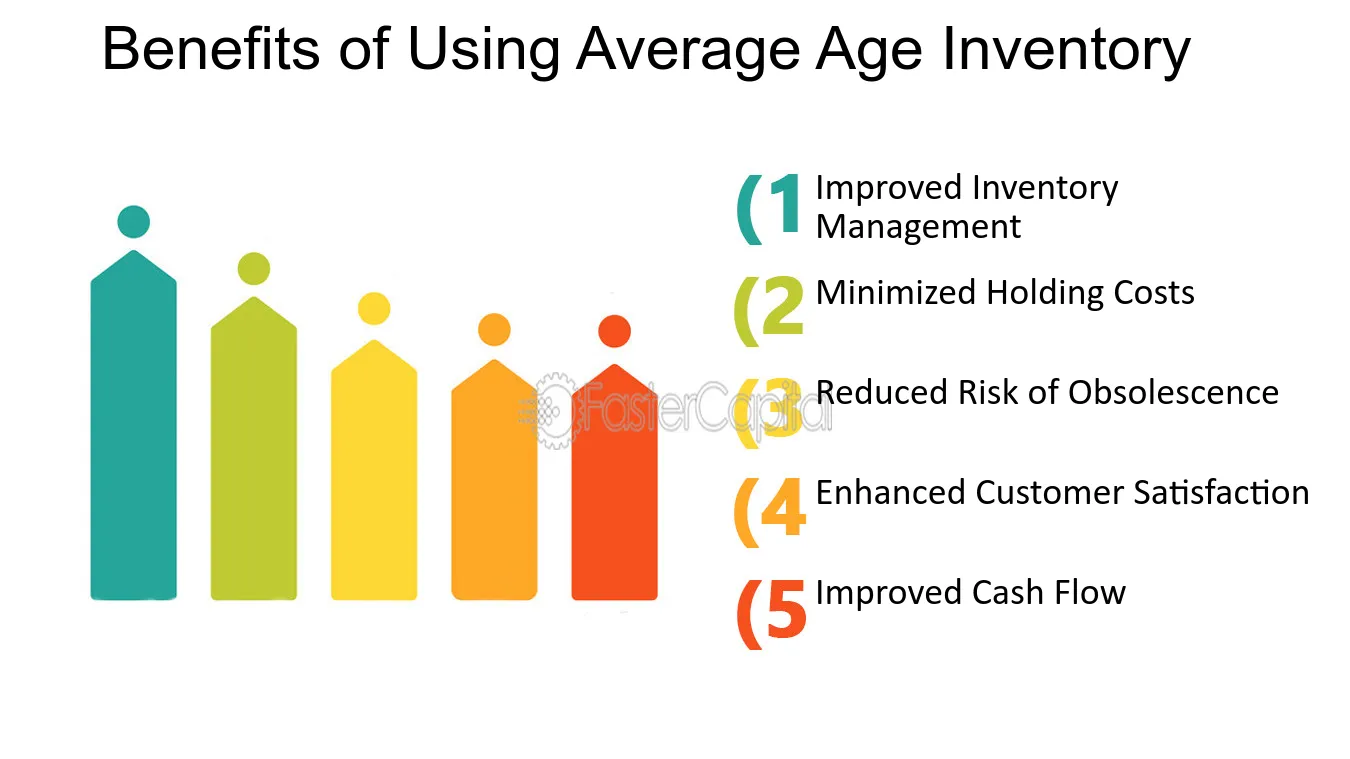
Benefits of Using Average Age Inventory - Stock management: Mastering Inventory Control: The Power of Average Age
43. Understanding the Average Age of Inventory
In the world of stock management, understanding the average age of inventory is crucial for achieving profitability. The average age of inventory refers to the average number of days it takes for a product to be sold from the time it is received into the warehouse. This metric plays a vital role in determining the efficiency of an organization's inventory management practices. By reducing the average age of inventory, businesses can optimize their operations, minimize costs, and maximize profits.
1. Importance of tracking the average age of inventory:
Tracking the average age of inventory provides valuable insights into the efficiency of stock management. It helps businesses identify slow-moving or stagnant products that may be tying up valuable resources and occupying warehouse space unnecessarily. By tracking this metric, companies can proactively address inventory issues and make informed decisions to improve profitability.
For example, consider a retail store that specializes in seasonal clothing. By regularly monitoring the average age of inventory, the store manager can identify which items are not selling as quickly as expected. This information can prompt the manager to implement strategies such as markdowns, promotions, or even returning excess inventory to suppliers, thus preventing potential losses and freeing up capital for more profitable products.
2. Factors affecting the average age of inventory:
Several factors can influence the average age of inventory, including demand fluctuations, supply chain disruptions, and forecasting inaccuracies. Understanding these factors is essential for effectively managing inventory and reducing its average age.
For instance, a sudden surge in demand for a particular product can lead to stockouts, resulting in an increased average age of inventory. By closely monitoring customer demand patterns and adjusting order quantities accordingly, businesses can avoid stockouts and maintain a healthy turnover rate.
3. Strategies for reducing the average age of inventory:
Reducing the average age of inventory requires implementing effective inventory management strategies. Here are some strategies that businesses can consider:
- Implementing just-in-time (JIT) inventory management: JIT allows businesses to receive inventory from suppliers just in time for production or customer demand, minimizing the time products spend in the warehouse. This strategy can significantly reduce the average age of inventory, leading to improved profitability.
- Enhancing demand forecasting accuracy: accurate demand forecasting helps businesses plan their inventory levels more effectively. By leveraging historical sales data, market trends, and customer insights, companies can make more accurate predictions, ensuring optimal stock levels and reducing the average age of inventory.
- Implementing automated inventory management systems: Leveraging technology and automation can streamline inventory management processes, reducing manual errors and improving efficiency. Automated systems can track inventory levels, generate real-time reports, and provide insights into the average age of inventory, enabling businesses to take proactive measures to optimize stock levels.
Understanding the average age of inventory is crucial for businesses aiming to achieve profitability through effective stock management. By tracking this metric, identifying factors that influence it, and implementing strategies to reduce it, companies can streamline their operations, minimize costs, and maximize profits. By continuously improving inventory management practices, businesses can stay competitive in today's dynamic market.
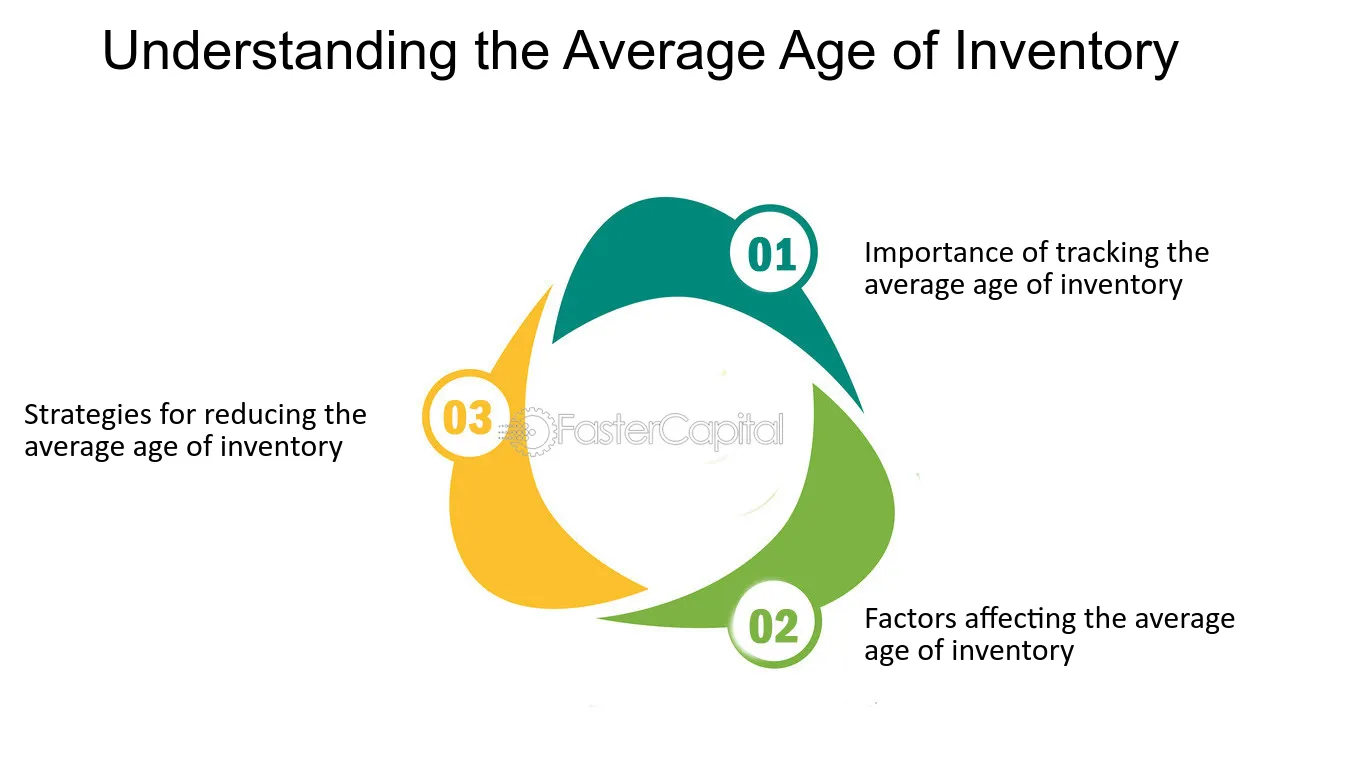
Understanding the Average Age of Inventory - Stock management: Reducing Average Age of Inventory for Profitability
44. Importance of Reducing Average Age of Inventory
The average age of inventory is a crucial metric that can significantly impact the profitability of a business. It refers to the average number of days it takes for inventory to be sold or used. Reducing the average age of inventory is essential for several reasons. Firstly, it helps businesses maintain a healthy cash flow by minimizing the amount of capital tied up in inventory. Secondly, it allows businesses to adapt more quickly to changing market conditions and customer preferences. Lastly, it helps prevent inventory obsolescence, reducing the risk of losses due to outdated or unsellable products.
From a financial perspective, reducing the average age of inventory has a direct impact on cash flow. Holding excessive inventory ties up valuable capital that could be used for other purposes, such as investing in growth opportunities or paying off debts. By reducing the average age of inventory, businesses can free up cash that can be reinvested in the company or used to improve financial stability.
1. Improved cash flow: Reducing the average age of inventory allows businesses to generate cash more quickly by converting inventory into sales. This, in turn, helps businesses meet their financial obligations, such as paying suppliers and employees, more efficiently. Additionally, a healthy cash flow enables businesses to take advantage of discounts offered by suppliers for early payments, further enhancing profitability.
2. Increased responsiveness: In today's fast-paced and dynamic business environment, the ability to respond quickly to changing market conditions is crucial. By reducing the average age of inventory, businesses can adapt more rapidly to shifts in customer preferences, emerging trends, or unexpected events. For example, a fashion retailer that can quickly introduce new designs based on the latest trends will have a competitive edge over competitors with slower inventory turnover.
3. Minimized obsolescence risk: Products that remain in inventory for extended periods run the risk of becoming obsolete or outdated. This can lead to significant financial losses for businesses. By reducing the average age of inventory, companies can minimize this risk and ensure that their products remain relevant and sellable. For instance, a technology company that regularly updates its inventory to offer the latest models will attract more customers and avoid losses resulting from outdated products.
4. Enhanced customer satisfaction: Reducing the average age of inventory enables businesses to consistently offer fresh and desirable products to their customers. This helps build customer loyalty and satisfaction, as they can rely on finding up-to-date and high-quality items. For example, a grocery store that frequently replenishes its perishable goods will attract customers seeking fresh produce and increase their chances of repeat business.
5. Efficient space utilization: Holding excessive inventory for extended periods requires additional storage space, which can be costly. By reducing the average age of inventory, businesses can optimize their storage capacity and reduce associated expenses. This is particularly relevant for businesses operating in limited space environments, such as small retail stores or warehouses.
Reducing the average age of inventory is crucial for businesses aiming to maximize profitability. By improving cash flow, increasing responsiveness, minimizing obsolescence risk, enhancing customer satisfaction, and optimizing space utilization, businesses can achieve higher efficiency and financial success. Monitoring and actively managing the average age of inventory should be a priority for any business seeking to thrive in today's competitive marketplace.
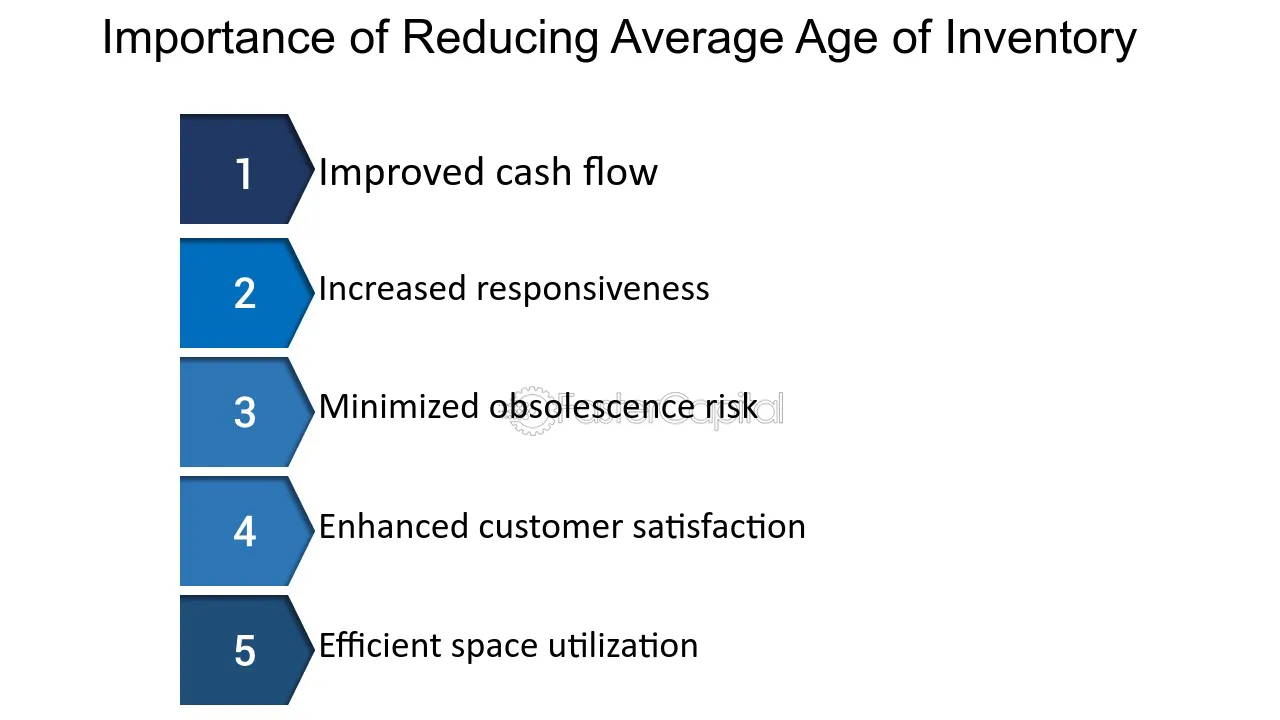
Importance of Reducing Average Age of Inventory - Stock management: Reducing Average Age of Inventory for Profitability
45. The Role of Average Age of Inventory in Preventing Stockouts
The average age of inventory is a key factor in preventing stockouts and ensuring a smooth supply chain process. It refers to the average time it takes for inventory to be sold or used up. By closely monitoring and managing the average age of inventory, businesses can avoid unnecessary stockouts and maintain a healthy balance between supply and demand. In this section, we will explore the role of average age of inventory in preventing stockouts from different perspectives and delve into the strategies that can be employed to optimize this crucial metric.
1. Maintaining a Buffer Stock: One effective way to prevent stockouts is by maintaining a buffer stock. This involves keeping a certain quantity of inventory on hand that acts as a safety net in case of unexpected spikes in demand or delays in supply. The average age of this buffer stock should be carefully monitored to ensure that it remains within acceptable limits. By replenishing the buffer stock before it depletes completely, businesses can avoid stockouts and continue to meet customer demands without interruption.
2. Demand Forecasting and Inventory Planning: accurate demand forecasting plays a vital role in managing the average age of inventory. By analyzing historical sales data, market trends, and customer behavior, businesses can make informed predictions about future demand. This information can then be used to plan inventory levels accordingly, ensuring that the average age of inventory remains optimal. For instance, if a particular product has a longer average age of inventory due to low demand, the business can adjust its production or procurement plans to avoid overstocking and potential stockouts.
3. efficient Supply Chain management: A well-structured and efficient supply chain is essential for maintaining an optimal average age of inventory. Collaboration and communication between suppliers, manufacturers, and retailers are crucial in ensuring timely delivery of goods. By streamlining the supply chain process, reducing lead times, and minimizing disruptions, businesses can effectively manage their inventory levels and prevent stockouts. For example, implementing a just-in-time (JIT) inventory system can help reduce the average age of inventory by synchronizing the arrival of materials with production schedules, thus minimizing excess inventory and the risk of stockouts.
4. Monitoring key Performance indicators (KPIs): Tracking and analyzing relevant KPIs can provide valuable insights into the average age of inventory and help in preventing stockouts. Key metrics such as inventory turnover ratio, days of inventory on hand, and fill rate can highlight potential issues and guide decision-making. For instance, a low inventory turnover ratio or a high number of days of inventory on hand may indicate excessive stock, leading to a higher average age of inventory and a greater risk of stockouts. By regularly monitoring these KPIs, businesses can proactively identify and address any imbalances in the inventory levels.
The average age of inventory plays a crucial role in preventing stockouts and ensuring a smooth supply chain process. By maintaining a buffer stock, accurately forecasting demand, managing the supply chain efficiently, and monitoring relevant KPIs, businesses can optimize this metric and minimize the risk of stockouts. This not only helps in meeting customer demands but also enhances overall operational efficiency and profitability.
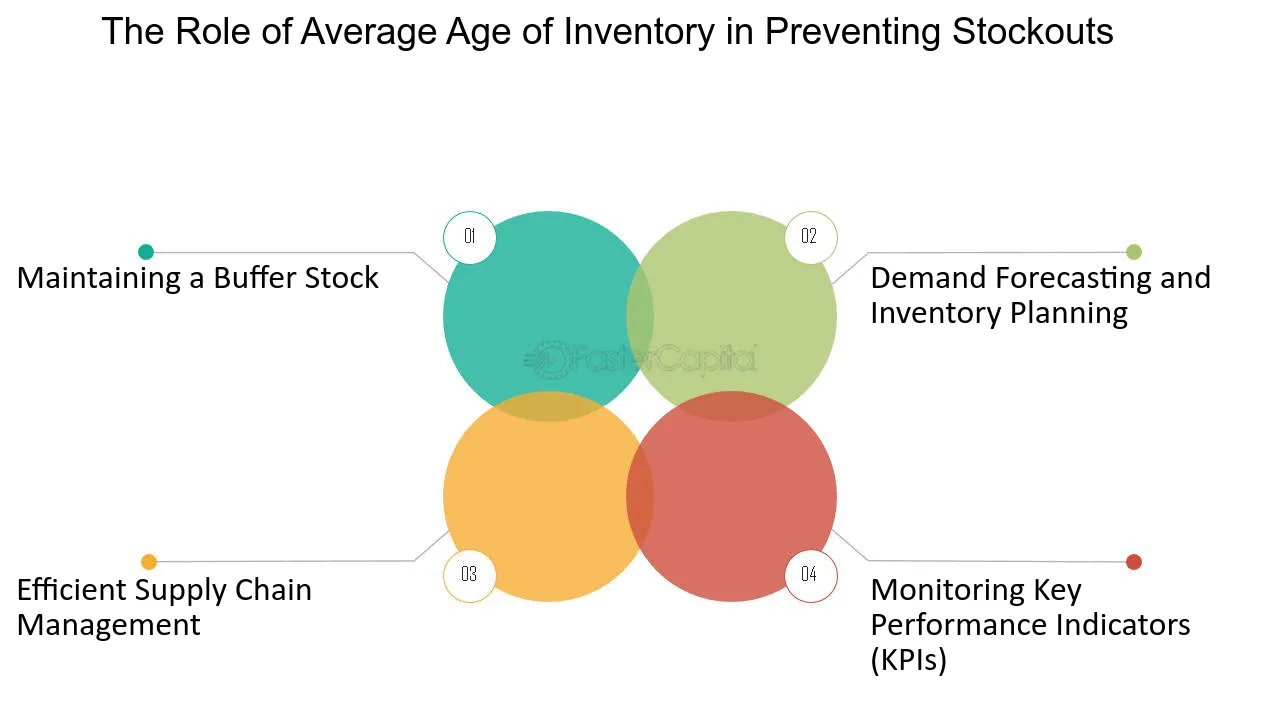
The Role of Average Age of Inventory in Preventing Stockouts - Stockouts: Avoiding Lost Sales: Average Age of Inventory and Stockouts